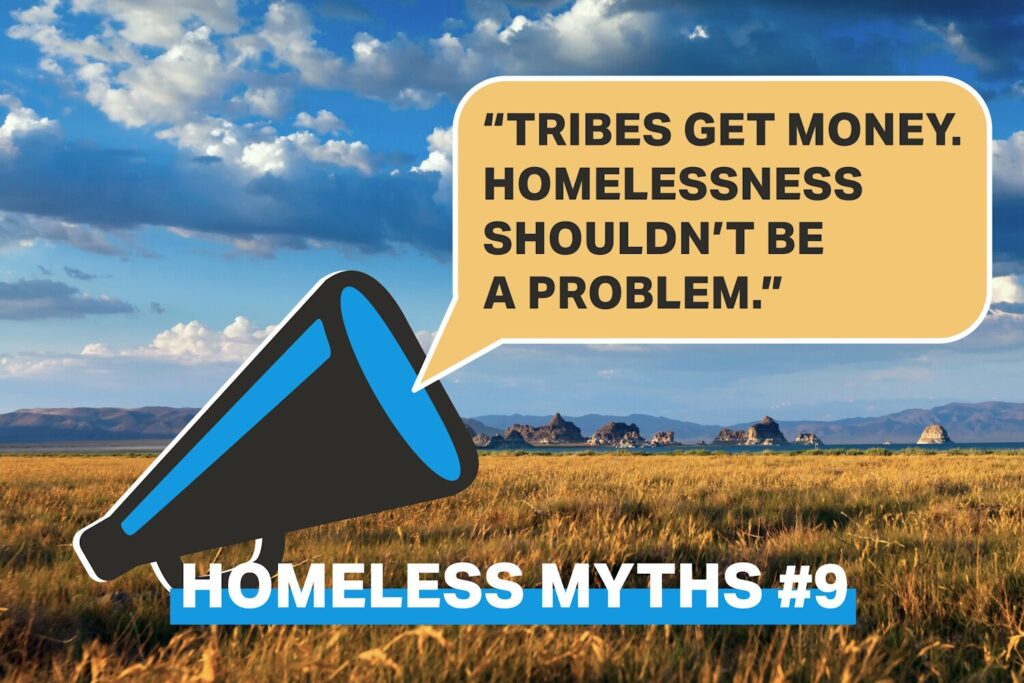
Today, American Indians/Alaska Natives (AI/AN) experience the second highest rate of homelessness in the U.S. Our recent exploration of the impacts of homelessness on Native peoples lends perspective to the complex cause-and-effect relationship behind this crisis, and many of the same factors play into the myth of adequate funding.
Yet anyone unfamiliar with the data might understandably look at it like this: The federal government is obligated to right the wrongs of decades of historical traumas, so funding sufficient to end this emergency must reach the tribes. That is not true for several reasons.
Federal funding for tribal housing assistance has stagnated since 1998
A lack of affordable housing is directly tied to higher rates of homelessness on tribal lands. But despite helpful increases in the past few years, Indian Housing Block Grant (IHBG) funding levels have remained largely static in the quarter-century following its start in 1998. Because the IHBG is the primary source of funding by which tribes provide affordable housing on reservations, an inadequate contribution translates directly to a critical housing shortage.
An estimated 68,000 new homes are needed to eliminate overcrowding and replace inadequate housing on reservations – and an increase in population since that data was collected has likely worsened the shortage.
High Inflation and increasing reservation populations play a role
Though the dollar amount of IHBG funding has increased slightly over time, inflation has taken a toll in the 25 years since it began, eating away at the value of the contribution. It now represents only a fraction of the 1998 value—a serious impact considering that even at full 1998 value, these dollars did not meet the demand for affordable housing.
Meanwhile, reservation populations have increased since 1998, significantly lowering the per capita allocation of IHBG funding. In the period from 1999 to 2014, the per capita amount decreased over 33% – with real consequences.
Other factors combine to intensify the crisis
Barriers to development including limited private investment, low-functioning housing markets, and poverty mean that Native communities face some of the worst housing and living conditions in the United States. In nearly every social, health, and economic indicator, AI/AN people rank at or near the bottom. According to the latest counts, 1 in 4 AI/AN people were living below the poverty line, almost twice the national rate, yet only 12% of households said they were in assisted housing.
Much of the existing housing is insufficient and overcrowded. According to a 2017 study, homes in tribal areas had deficiencies that far exceeded the national rates of 1-2%.
And among AI/AN households in tribal areas, 16% are overcrowded, compared to 2% nationally. The practice of “doubling up” – living with friends or family despite overcrowding – masks literal homelessness and skews the data that government agencies rely on to allocate funding.

The result? Tribal housing assistance is in desperate need of an overhaul and an infusion of dollars.
Even if funding levels rise sufficiently to meet the affordable housing crisis head on, how much time will pass before conditions measurably improve on tribal lands? Construction is a slow process and, when tied to grant funding, often hindered by red tape that can add years to a project.
The tribes need solutions now, not five years from now. Nearly 80% of Native people no longer live on reservations, due in large part to living conditions there. This leaves many feeling disconnected from their culture and caught between two worlds, with no sense of belonging in either. Understanding this – and the points discussed above – illustrates how when we assume indigenous communities are getting the help they need, we only leave them more vulnerable to going unnoticed.
There are signs of progress. With All In: The Federal Strategic Plan to Prevent and End Homelessness announced in December 2022, the government acknowledges the work to be done both nationally and specifically to improve conditions on tribal lands. The intent is to “ensure state and local communities have sufficient resources and guidance to build the effective, lasting systems required to end homelessness.” One of its four main strategies: Increase access to federal housing and homelessness funding for AI/AN communities living on and off tribal lands.
While long-term solutions are put in place, Pallet bridges the gap with immediate transitional housing and connection to wrap-around social services – a proven model for success. At the end of 2022, we built a shelter village on the Tulalip Tribal Reservation in Washington state – a good example of a solution tailored to its community. The Tulalip Tribe will run it with the ability to provide culturally appropriate resources. We know there’s no one-size-fits all approach to solving homelessness. But when advocates can create an ecosystem of support such as this, there’s potential for great progress.
6 impacts of homelessness unique to indigenous communities

Get them in a room together and Jennifer and Alan laugh – a lot. The two first met each other a handful of years ago when they were living on streets of the Tulalip Indian Reservation in Washington. Today they’re co-workers at Pallet. Their witty humor makes them a dynamic duo dropping hilarious one-liners as they tell stories about their past. Indeed, they can have a crowd in stitches.
“I relate to many of the people here because we can laugh about things that most people would get appalled by,” Alan says in admiration of his co-workers, many of whom share similar lived experiences.
Jennifer agrees – they have witnessed the darker sides of life. But, she says, they’ve risen above them. “It’s like, you guys, we have overcome so much and we’re killing it now. We are rock stars,” she says, laughing.
She and Alan are proud to have surmounted substance use disorder and other challenges that are, truthfully, nothing to laugh at. Right now though, they’re excited to be working on Pallet shelters for a new village on the Tulalip Reservation where they were once unhoused themselves.
“I’m super happy about the village because there’s a lot of my friends still stuck out there in Tulalip, doing the same dumb [stuff] I was doing,” Alan says. “Now they can potentially move into a Pallet shelter. And the guy that they used to get high with and go commit burglaries and crazy [stuff] with, is the same [guy] who built that shelter for them.”
Alan’s a machinist. He creates the individual parts that form the skeletons of our shelters.
Jennifer works in maintenance and repairs; she just transitioned from being an HR safety specialist. Sometimes she also works onsite erecting the villages. She feels a connection to the people who move into the shelters.
“When you get the opportunity to go out in the field and watch people take down their tents and cry and be so thankful and tell you that as they’re moving their stuff into a unit” it’s powerful, she says.
Years of substance use and cycles of recovery and recidivism led to Jennifer and Alan living unhoused on the Tulalip Reservation in the same circles for about six years. Alan lived in a tent surrounded by 30 other tents. Jennifer sold drugs.
“I needed drugs, she had drugs, that’s how we met,” Alan quips.
“As long as I could keep drugs in my pocket, I was ok. It meant I had money,” Jennifer explains.
Life on the streets was extremely hard both physically–such as defending oneself from attacks—and emotionally; there’s often a loss of self-worth, Jennifer says. “You have to be a survivor. You have to do things you normally wouldn’t do just to get by.”
“People tend to think of drug addicts as being weak,” Alan says. “But it’s the opposite; you’re battling every single day. You’re not thinking about tomorrow, you’re thinking about how am I going to get through today. You’ll worry about tomorrow when tomorrow comes.”
Through their own journeys and fortitude, Jennifer and Alan both eventually entered clean and sober houses. Jennifer started managing the women’s house, and Alan, the men’s. Jennifer came to Pallet about a year before Alan and found the structure and accountability she needed to start rebuilding her life. Soon she was promoted to HR. “Alan’s manager referred him to me as a great worker and we needed people,” Jennifer says. She helped hire him.
“I just love that when I got into HR I could get more people in and be a fair chancer,” she says. “To watch your fellow co-workers thrive and grow, you get so much reward out of that.”
Being part of a fair chance employer feels like an extension of how she, Alan and others provided support to each other on the streets. “Being in the circle of addiction, you still take care of each other,” she says. “Some days are harder than others. You’re just ready to give up and you just need that one person to believe in you.”
With co-workers who believe in them and stable jobs, Jennifer and Alan are thriving. Alan just moved into an apartment and got his license back. Jennifer lives in her own place with her daughter.
Through their work on Pallet’s 100th village—the Tulalip village—Jennifer and Alan are striving to provide these critical transitional shelters to friends who are still unhoused on the reservation.
“For me, it’s about being part of solving a bigger problem,” Jennifer says. “What makes me excited about the Tulalip build is coming from there–it’s literally closing that whole circle and being able to give back.”
6 Impacts of homelessness unique to indigenous communities
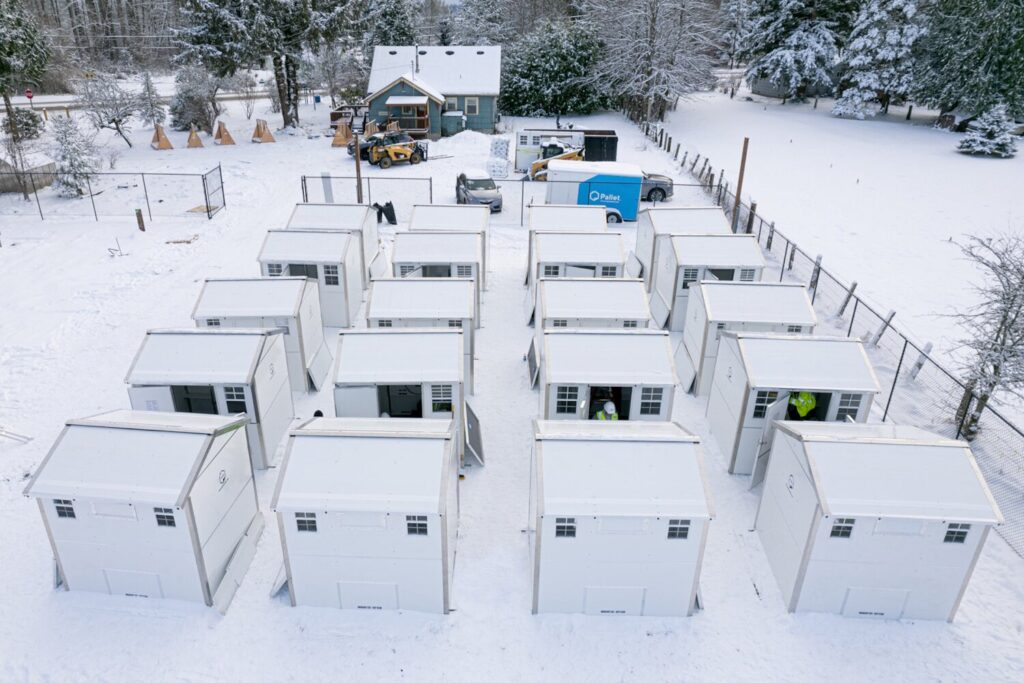
By Adrienne Schofhauser
“Native people were never homeless before 1492.”
It’s a poignant reminder from the Chief Seattle Club, a Native-led housing and human services agency in the city. In Seattle, Native people are seven times more likely than white people to be experiencing homelessness. While these rates are higher than most of the country, they represent a crisis that’s happening nationwide.
Decades of atrocities against Native people have produced a harsh reality: Today American Indians/Alaska Natives experience the second highest rate of homelessness in the U.S., according to the latest Annual Homelessness Assessment Report by the National Alliance to End Homelessness. As of 2019, Native Americans account for approximately 1.5% of North America’s population, yet they make up more than 10% of the homeless population nationally, according to the HUD report.

The reasons for these disparities are complex, but like many ethnic injustices in America, they’re rooted in the historical traumas uniquely experienced by these populations. Policies set up by the U.S. government to assimilate Native people had lasting impacts, and led to deep mistrust of agencies and resources.
It’s easy to assume the federal government’s partnerships with the Tribes would provide sufficient funding to right these wrongs. But the system is outdated and vastly underfunded. Largely due to this, nearly 80% of Native people no longer live on reservations. These impacts leave many Native people feeling caught between two worlds—with no sense of belonging in either.

Historical traumas
Actions by the federal government such the Indian Removal Act of 1830 and the forced assimilation of tens of thousands of Native children through boarding schools in the late 19th century may feel as though they’re part of a bygone era. But the traumas experienced by those who endured them have been passed down through generations of Native people.
In the boarding schools, Native children were stripped of their connections to their culture, forced to lose their language and traditions. They endured mental, physical and sexual abuses. These traumas had long-lasting, multigenerational impacts, creating personal scenarios in which it’s hard to seek help, trust authorities and systems, and ultimately establish stable housing.
The Chief Seattle Club said it sees first-hand how many Native people who walk through their doors still experience a “deep longing” for connections to their culture and traditions.
Mistrust in government agencies
These historical traumas carried in the bodies and minds of Native people through the generations have created a great mistrust of government agencies. The results are damaging: Even when assistance is available, few Native people may take advantage of those resources. According to Point-in-Time data, Native people access housing shelters at a lower rate than any other demographic.
When Native people do seek resources such as housing and employment, systemic and cultural barriers—such as implicit bias and lack of respect or understanding of cultural differences by people involved in the process—present big hurdles to securing that next step toward housing and financial stability.
In other words, when Native people take the initiative to push beyond their ingrained mistrust, they’re often met with an even higher hurdle—society’s historically negative perception of people who have endured unacknowledged hardships and harms.
Low counts lead to a lack of federal funding
Native Americans experiencing homelessness are severely undercounted in U.S. data. Certainly, mistrust in government agencies is one reason—when Native people don’t access resources, advocate services can’t generate reliable data. Another reason is simply their small population size, which makes it hard for homeless services and the U.S. Census to identify them.
The consequences of low and inaccurate counts can be devastating. Federal and other types of funding are tied to these numbers. Public policies are built around them. When Native people aren’t represented in the data—rendering them essentially invisible—public policies simply can’t address their needs.
This plays out on tribal lands, where 23% of American Indian/Alaska Native households have incomes less than 50 percent of the federal poverty line. “Tribal nations rely on the U.S. Census Bureau to make sure that the count for Indian Country is accurate and complete to ensure proper representation and redistricting, equitable federal funding decisions and formulas, and access to accurate census data for local tribal governance,” Kevin J. Allis told a Congressional panel in 2020.

The reality is, the Indian Housing Block Grant (IHBG) funding, which provides affordable housing activities on reservations and Indian lands, has remained relatively stagnant since 1998. Meanwhile, inflation has eaten away at the value of those dollars. Additionally, the Native population living on tribal lands has increased over the last two decades. Because funding has not kept pace, services like housing assistance have suffered significantly.
Unfortunately, the negative consequences of these impacts can be highly masked on tribal lands. That’s because of a practice called “doubling up.”
Doubling up masks literal homelessness
Family members on tribal lands often provide shelter to friends and extended family lacking access to housing. Because of this, homelessness doesn’t so much take the form of individuals sleeping on the street as it does in doubling up. Individuals move from one overcrowded home to the next, a direct result of lack of affordable housing, which in turn, is the consequence of inadequate funding.

According to the U.S. Housing and Urban Development, between 42,000 and 85,000 Native Americans on tribal lands experience homelessness. Yet literal homelessness—that is, sleeping outside, in an emergency shelter or some place not meant for human habitation—is far less common. This is compounded by the fact that designated homeless services are also less common in tribal areas.
These circumstances have pushed many to seek opportunities off the reservations. But this comes with its own harsh realities.
Caught between two worlds
Having a credit history or understanding how to get an ID card are elements of everyday life in America. But for Native people migrating away from the reservation, these fundamentals can present major barriers to the first steps in applying for a job and establishing an economic foothold.
Additionally, mistrust and social discrimination continue to factor into their personal journeys.

Roughly eight out of 10 American Indians do not live on reservations. Yet very little federal funding is directed specifically toward them. Tribal governments usually allocate the funds they do get for life on the reservation. This leaves many Native people feeling caught between urban life and their reservation–or rather, abandoned by both.
Loss of spiritual connection
The major impacts of homelessness are felt across populations, from hazardous environmental exposure to safety risks, such as theft and murder. But unhoused Native people also face racial discrimination and a loss of connection to their culture and spiritual traditions.
Living on the streets makes it hard or impossible to practice their healing ways. Oftentimes, shelters and advocates aren’t knowledgeable about Native cultural issues. Nationwide, there’s a shortage of culturally competent outreach, which is key to engendering trust with unhoused Native people.
However, resources that are designed specifically for Native people are finding success. “We know that when our community gets culturally competent services, by Native people for Native people, the services are going to stick,” Janeen Comenote, founding executive director of the National Urban Indian Family Coalition, told Bloomberg.
If more resources address the challenges unhoused Native people face, the effects would literally be life-saving. According to New Mexico In Depth, the average age of death for unhoused white people is 45.6 years old. For unhoused Native people, it’s 37.5. And for Native women, it’s only 35.3.
Those are staggering numbers that hit us at the core here at Pallet. They’re proof that creative solutions are desperately needed.
We’re proud to be building a village on the Tulalip Tribal Reservation in Washington state; it’s our 100th village built. The Tulalip Tribe will run it with the ability to provide culturally appropriate resources. It’s an example of a solution personalized to its community. We know there’s no one-size-fits all approach to solving the homelessness crisis. But when advocates can create an ecosystem of support for reintegration–such as the Tulalip Tribe with these shelters—there’s potential for great progress to happen.
Pallet builds it's 100th village

Just before Christmas, we crossed a milestone — building our 100th village. It’s located in Tulalip, WA which is just a short drive north of our headquarters. The location holds special meaning for some Pallet employees who previously experienced homelessness in the area and are now finding purpose in building transitional housing to help others in the community. The village is made up of twenty 64 sq.ft. shelters and one 100 sq.ft. shelter and was constructed in just two days by the Pallet deployment team. The Tulalip tribes will manage the site and provide on-site services for community members moving in over the next couple of weeks.
Build Breakdown
Pallet shelters are built by our deployment team – a dedicated group of nine staff members specializing in on-site shelter construction. They travel from city to city, building transitional shelter villages in communities for people experiencing homelessness. This team also offers advisory and training services for constructing Pallet shelters. The expertise and experience they bring create a seamless, replicable process.
A behind-the-scenes look into the process starts with the unloading of the palletized shelters from the delivery trucks.
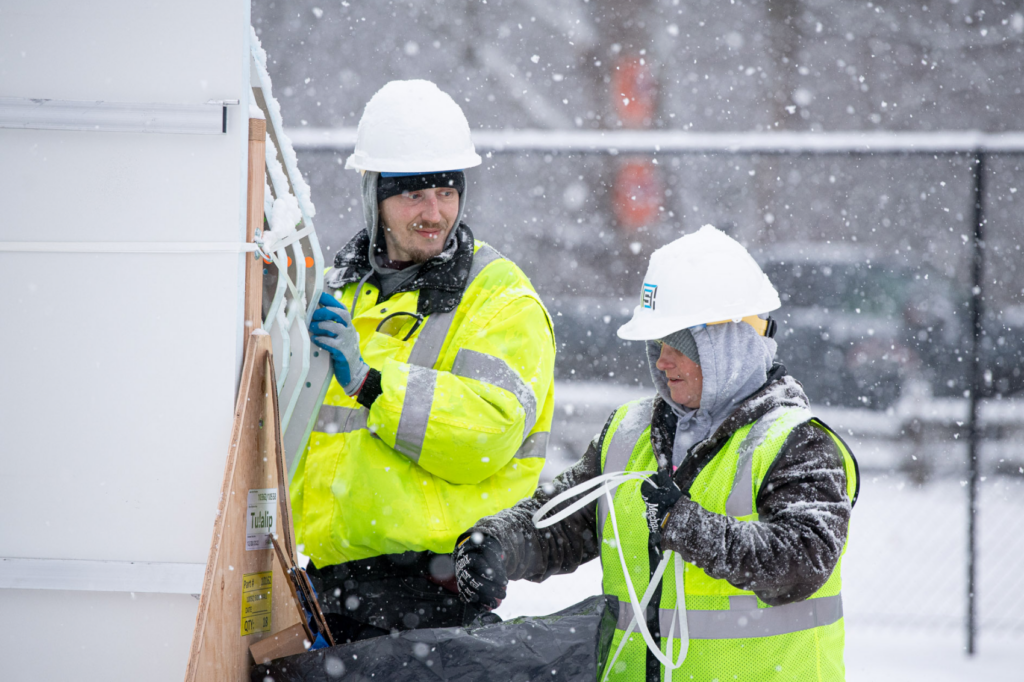
Once the bases of the shelters are set in place, each shelter is built from the outside in.
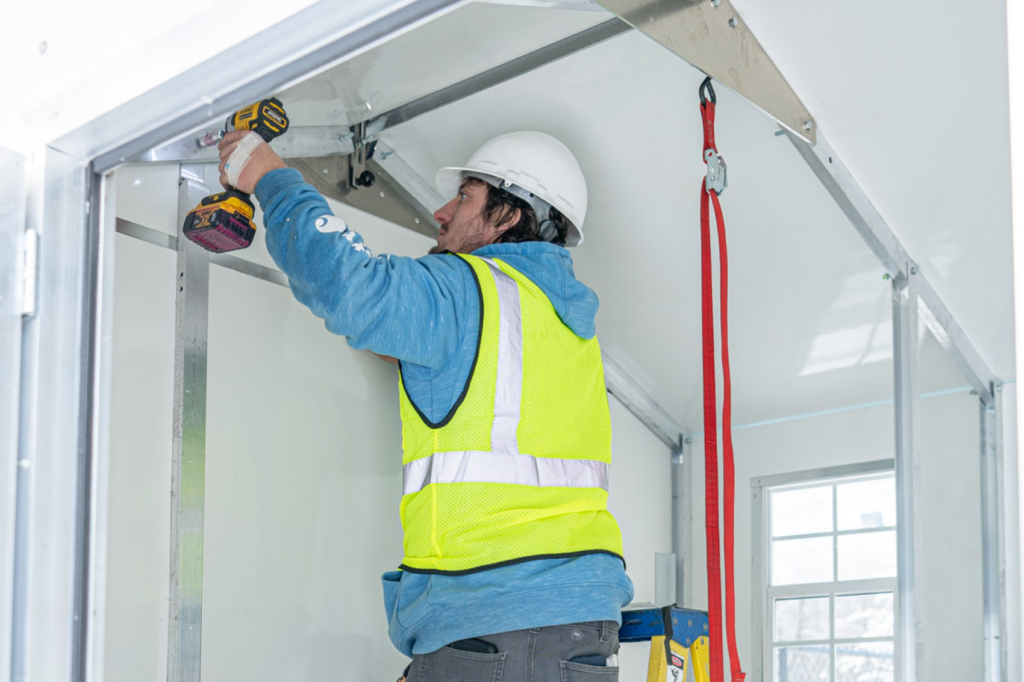
Next, the side walls are built around the base and roof is built last.

The interior of the shelter is then constructed, which includes shelving, climate control, lights, electrical outlets, a folding bunk bed with a custom-fit mattress, a fire extinguisher, and a smoke detector. The last step in the building process is an inspection typically conducted by a Field Team Lead to ensure quality and to approve the site for city inspection.
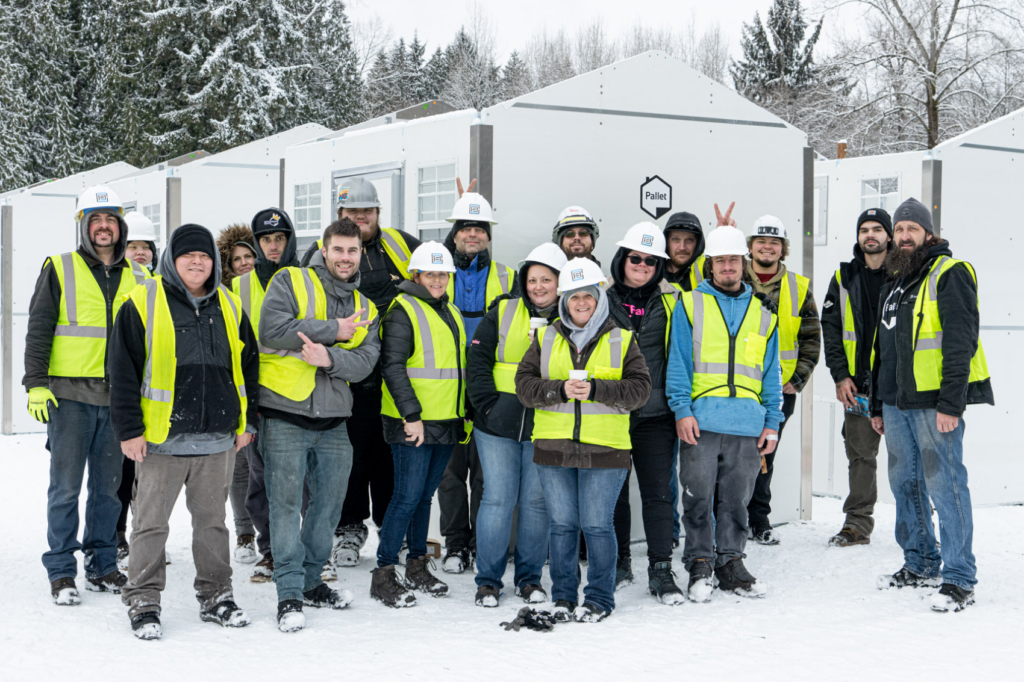
Field Team Lead, James was one of the first people on the deployment team. He joined Pallet two and half years ago as a Manufacturing Specialist and was promoted to the role he has now. James is driven by our twofold mission — addressing unsheltered homelessness and building a nontraditional workforce through fair chance employment.
"I get to work with people that have not only experienced homelessness, but substance use disorder and incarceration and see them thrive. They're some of the hardest working people I've ever worked with," he explained. "Our shelters are transitional to help people who fell on hard times. The village is here to help you get through that and get back up on your feet."
100 shelter villages built and counting...
"Building our one-hundredth village shows the Pallet model is a proven and viable option. More and more cities are turning to us because they need creative solutions," said Pallet Founder and CEO Amy King. "At Pallet shelter villages, people come in and stabilize. By consistently engaging with a service provider, they can build trust and community together. This preparation allows them to sustain permanent housing once they get there."
Our first-ever village opened in Tacoma, WA, in 2017. The Tulalip location is the ninth village in Washington state. During the last five years we've set up shelters as far south as Hawaii and as far north as Burlington, VT.
The 100th build won't be our last. We'll continue to provide this valuable resource to communities who want to help their unhoused neighbors.
Tim’s story: From a Pallet shelter village to housing
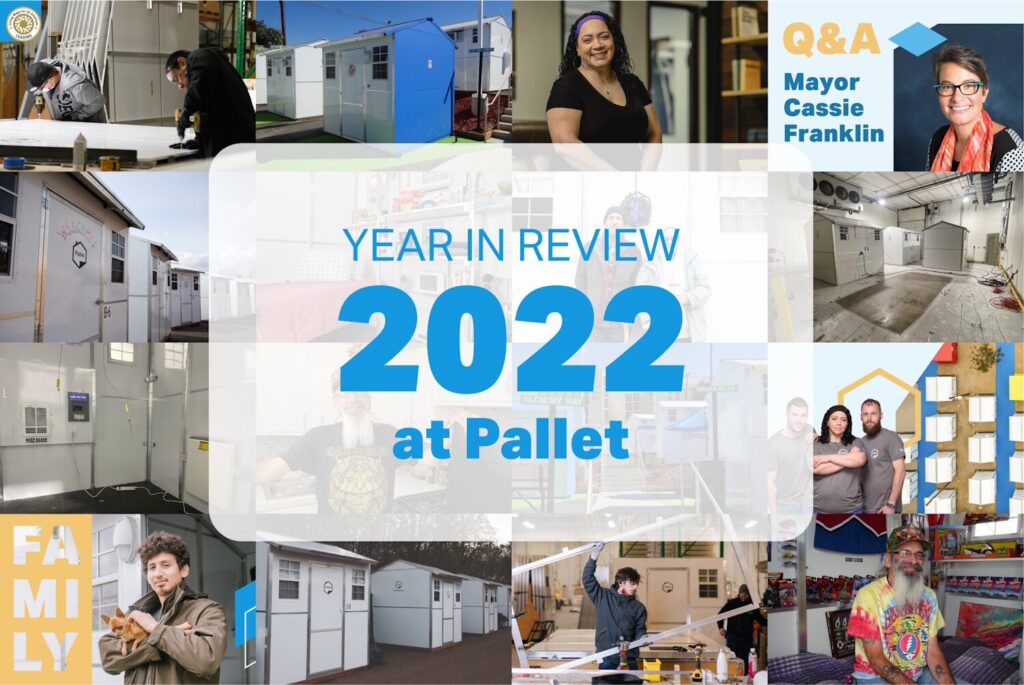
As the year ends, we’re looking back at the stories we’ve shared throughout 2022. It’s been another year of growth, and we’ve evolved as a company — we’re now a Public Benefit Corporation and a certified Living Wage Employer. We’ve also expanded our footprint by building Pallet shelter villages in the northeast.
Notably, hundreds more people experiencing homelessness are staying in dignified shelter with a locking door and have access to social services. They can now stabilize and are working towards moving into permanent housing with the assistance of an on-site service provider. This year the Pallet model helped people such as Tim and others move out of temporary shelter and into their own homes.
Here’s a round-up of our top stories from this year.
1. Tim’s story: From a Pallet shelter village to housing

Tim became homeless after a series of distressing events. First, he lost his job, then the apartment building he lived in was sold. His lease wouldn’t be renewed, leaving him with 30 days to find a new place.
“Covid knocked on our door a couple of months after that, and it’s just been one speed bump after another that has culminated in where I am right now,” he shared. Tim went on to stay at a mass congregate shelter with hundreds of other people. Next, he moved to the Safe Outdoor Space (SOS), which has 56 Pallet shelters. “This is way better. You have your own key. You have four walls that you can lose yourself in or whatever, and you can ride out whatever unpredictable in your life, save up some cash and move on to your next step.”
Stabilizing in a safe, secure space positively impacted Tim’s life. After accessing social services, Tim moved into an apartment at the beginning of October. [Keep Reading]
2. A supportive little friend: Juan and Pepe
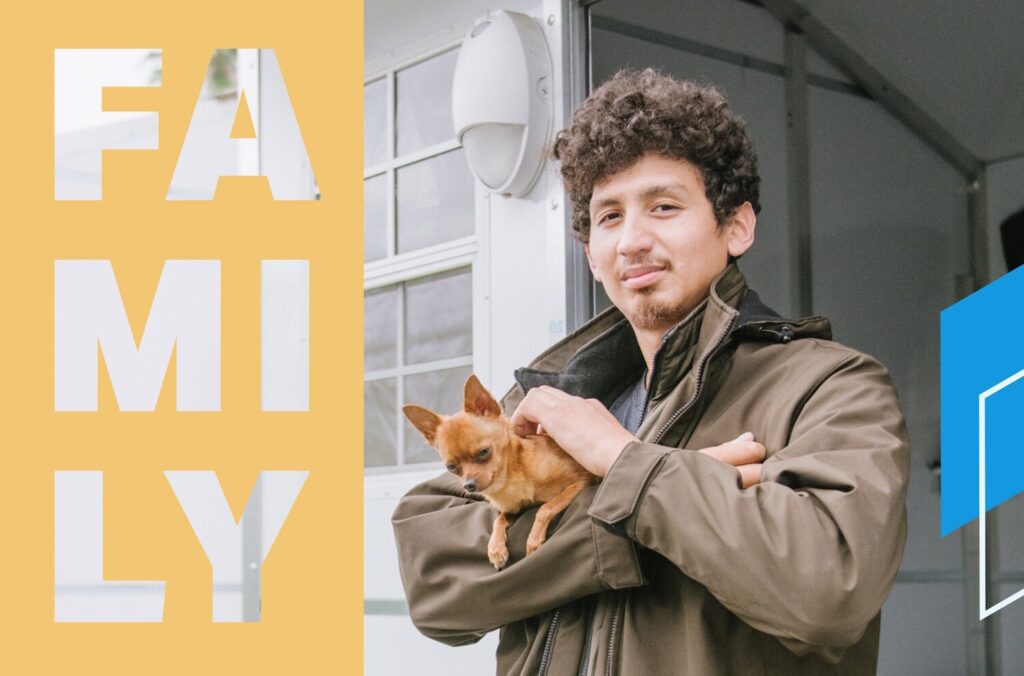
If you’re looking for Pepe – a tiny tan chihuahua – you may miss him at first. His favorite place to hide is Juan’s zip-up jacket. Pepe’s tiny head occasionally pokes out, just far enough to get ear scratches and peek around.
Juan, Pepe’s owner, loves to keep him close for cuddling. The duo first met a few months ago, in a tough time in Juan’s life. [Keep Reading]
3. Building community in Vancouver, WA
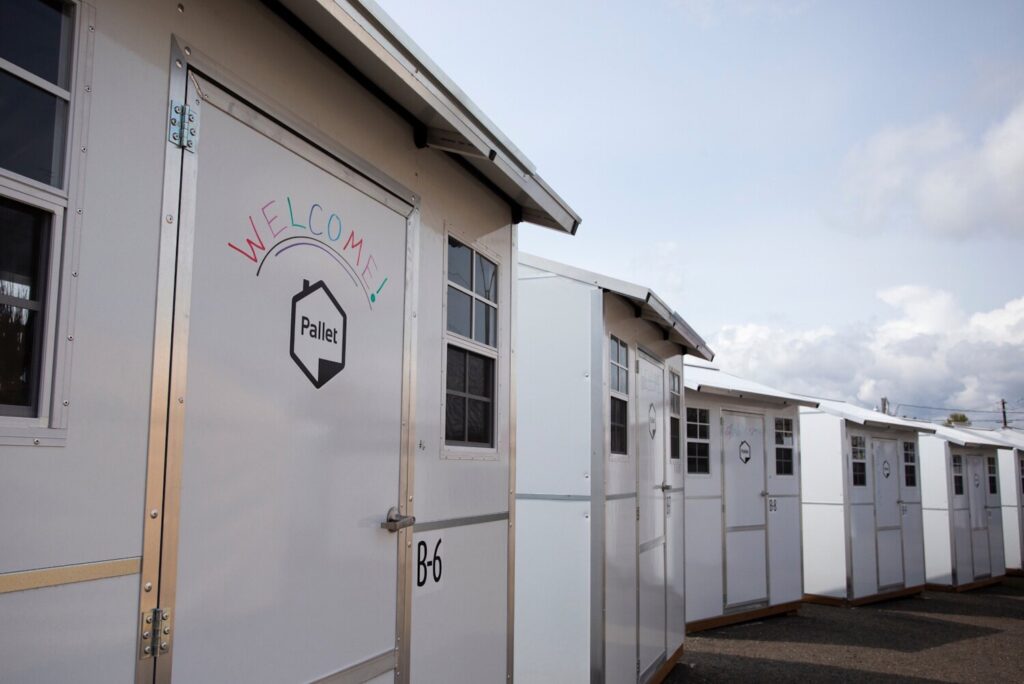
Recently Jerry and Sharon celebrated 26 years of marriage. This year they had more to commemorate than just lifelong companionship. At the same time last year, they lived outside and slept in a tent. The couple moved into Safe Stay Community, a Pallet shelter village in Vancouver, WA, when it opened in December 2021. The relocation was especially timely because of an unforgiving Pacific Northwest winter.
“It’s great compared to a tent. Heat’s good, especially in December when it’s colder than heck. Or April when it snows,” Sharon said. “And windstorms. We had a big windstorm that was taking tents down, but it never took ours down.”
“It’s a God send,” Jerry added. [Keep Reading]
4. Q&A: Mayor Cassie Franklin on addressing unsheltered homelessness

Pallet shelter villages are transitional communities for people experiencing homelessness. They provide the dignity and security of lockable private cabins within a healing environment. Residents have access to a resource net of on-site social services, food, showers, laundry, and more which helps people transition to permanent housing.
There are more than 70 Pallet shelter villages across the country, including one near our headquarters in Everett, Washington, which opened one year ago. Everett Mayor Cassie Franklin was instrumental in bringing the site to life. We held a webinar to discuss the affordable housing crisis, why unhoused people don’t accept traditional shelter, and the steps the city of Everett took to build a Pallet shelter village. Mayor Franklin provided good insight into these issues. Before becoming an elected official, she was the CEO of Cocoon House, a nonprofit organization focused on the needs of at-risk young people. [Keep Reading]
5. Change is possible, just ask Sarah
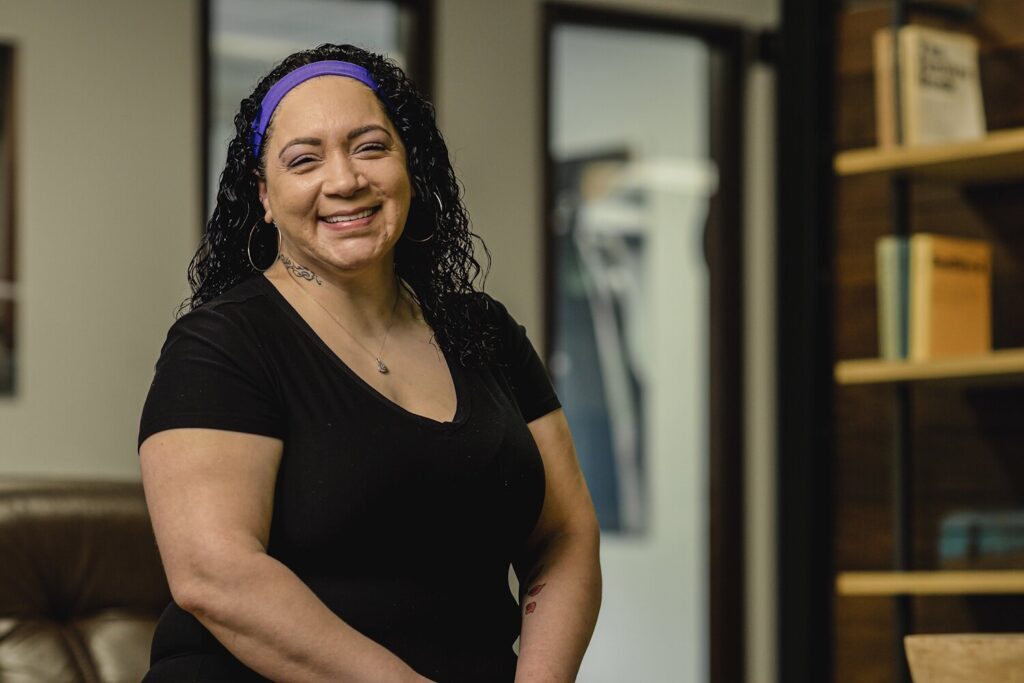
When Sarah sets her sights on a goal, she’ll inevitably be successful. Being resourceful and determined has served her well. Sarah joined Pallet as a Manufacturing Specialist at the beginning of the year. Joining the team was a full-circle moment. She vividly remembers seeing our shelters in downtown Portland a couple of years ago. In a short time, Sarah has made an impact working at Pallet. Working in the factory was a bit of an adjustment at first, particularly standing on her feet for long hours. Still, she got used to it and quickly excelled at the various steps of building Pallet shelters.
“They were bouncing me around to all the stations, and the supervisors kept saying, ‘normally people need to stay at a station for a certain amount of time before we move on, but you’re learning really quickly,'” she shared. “It helped give me that motivation and confidence.”
Within a few months, Sarah was promoted to Customer Service Coordinator, a new position on the Community Development team. [Keep Reading]
6. Building community at Westlake Village
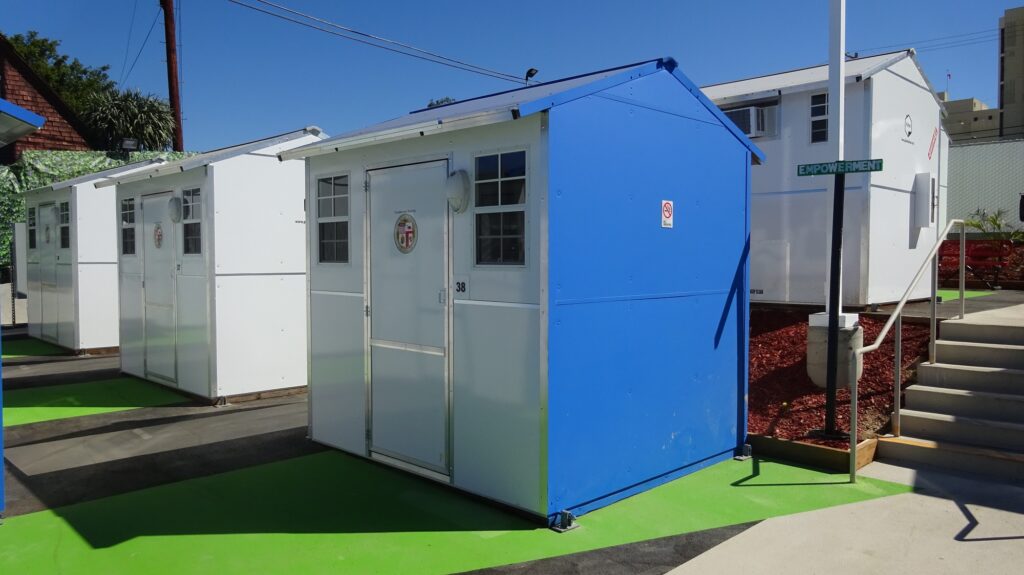
Two photos hanging from a fence greet visitors when walking into Westlake Village in Los Angeles. One has a placard underneath reading “Guest of the Month.” The other is titled “Employee of the Month.” The rotating designation encapsulates the spirit of the village and its values – building community, sharing positive feedback, and celebration.
The community of 60 colorful Pallet shelters and street signs is a transitional place for people experiencing homelessness. Residents have access to a resource net of social services, meals, hygiene facilities, laundry, and more. Urban Alchemy (UA) — a social enterprise engaging with situations where extreme poverty meets homelessness, mental illness, and substance use disorder — is the service provider for the site.
“My heart and compassion for the homeless population is huge. I believe that this is my calling,” shared Wanda Williams, UA Deputy Director of Residential Services. “We’re preparing them now for what may be next.” [Keep Reading]
7. Pallet achieves new status: Public Benefit Corporation

Pallet began in 2016 as a Social Purpose Company (SPC), the Washington state equivalent of a B corporation. As of 2022, we’re proud to announce that we’ve transitioned to a Public Benefit Corporation (PBC). It means we use profitability to expand our impact. As our business grows, the more jobs and shelter villages we can create to end unsheltered homelessness. The change reflects our growth as a company. PBCs are widely recognized across the country. More than 30 state legislators passed PBC statutes to make it easier for private businesses to establish themselves as a PBC or transition to one.
Think of a PBC as a hybrid of a nonprofit and for-profit organization. Our investment partners have allowed us to scale up quickly to meet the needs of the homelessness crisis. [Keep Reading]
8. Pallet is a certified Living Wage Employer
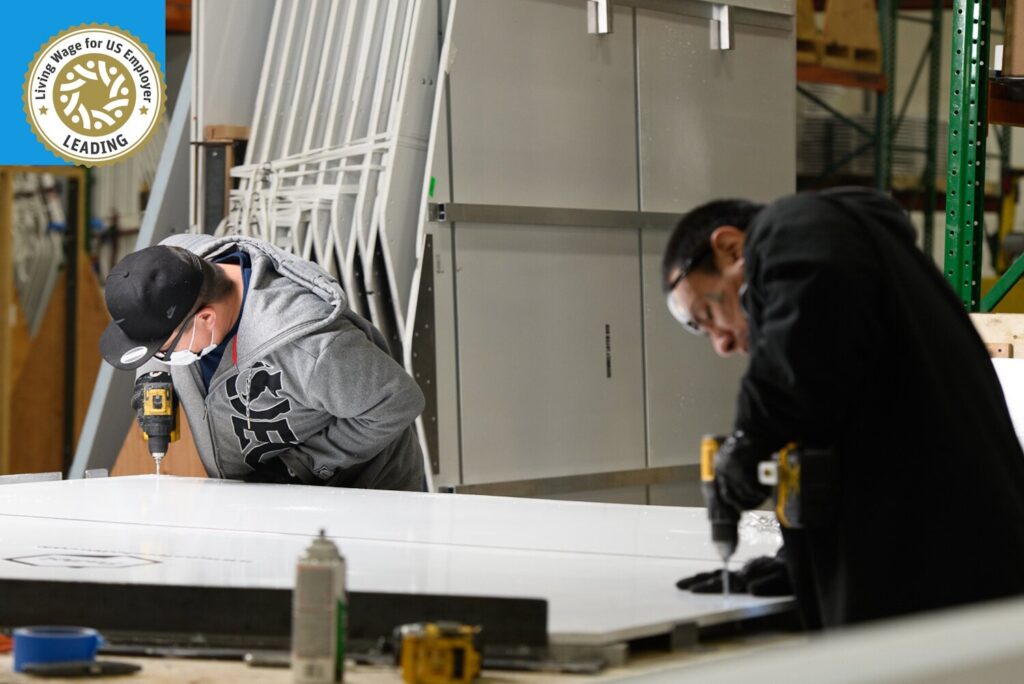
Investment in human potential is a core component of our mission. People who live in Pallet shelter villages are a part of a community where they have access to a resource net of social services, which enables them to transition to permanent housing. We’ve created a purpose-driven environment where employees are supported, and learning is encouraged.
As part of our commitment to creating sustainable jobs, we’re proud to announce Living Wage for US certified Pallet as a Living Wage Employer. The nonprofit organization granted the status after analyzing Pallet’s cash wages and benefits paid to employees. Third-party validation is another step for us to show business can be a force for good. [Keep Reading]
9. From second chance to fair chance: Why we’re changing our language
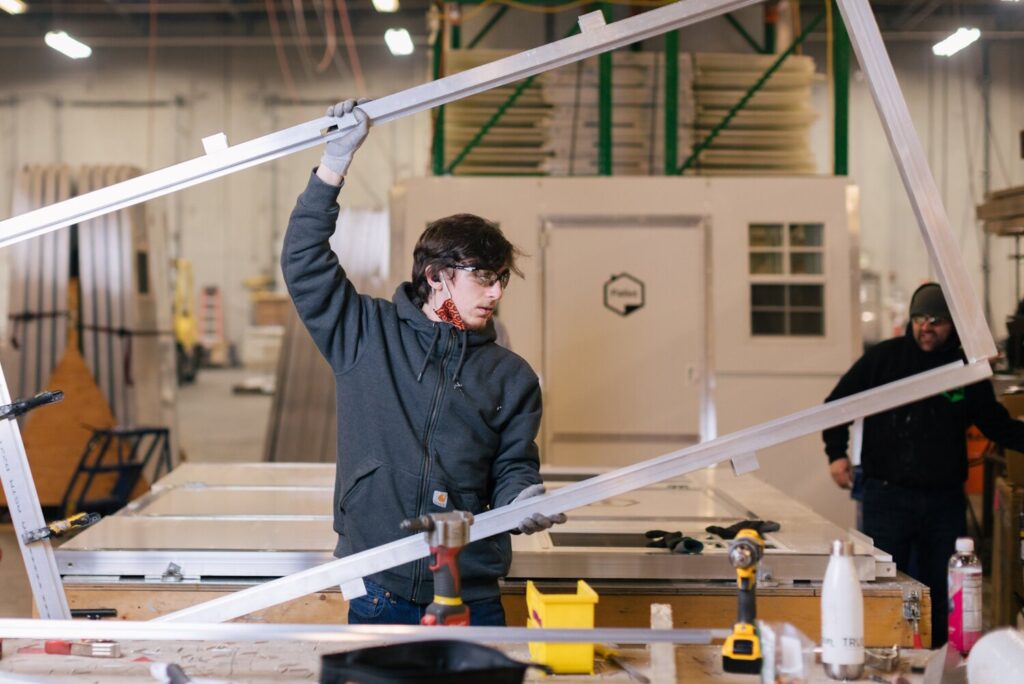
Language is ever-evolving. As society changes and grows, the words we use or stop using reflect who we are. At Pallet, we continually evaluate whether we’re using inclusive, destigmatizing language. We speak and operate in a way that mirrors our values.
Since our inception in 2016, we’ve identified ourselves as a second chance employer. At the time, it was a commonly used term to describe companies like us that aimed to build a nontraditional workforce. We focused on an applicant’s potential, not their past. As a result of this decision, it helped us design and manufacture shelter solutions firmly rooted in lived experience. But the term second chance employment doesn’t fit. It implies everyone has access to the same opportunities in life and squandered their first chance.
10. How Pallet shelters are tested for cold conditions

As part of our commitment to provide dignified space for people experiencing homelessness, we are continually improving our shelters. Conducting tests is one way to ensure Pallet shelter village residents are comfortable inside their cabins and safe from the elements. Recently two members of Pallet’s engineering team — Jordan, Design Engineer, and Jessie, CAD Designer — oversaw an independent assessment of our heaters and the 64 sq. ft. and 100 sq. ft. shelters. Specifically, we wanted an additional analysis of thermal efficiency in cold weather and the power consumption of the heaters.
Testing took place over four days at the SGS facility in Colorado. The shelters were placed inside a chamber that could reach -10 degrees Fahrenheit. [Keep Reading]
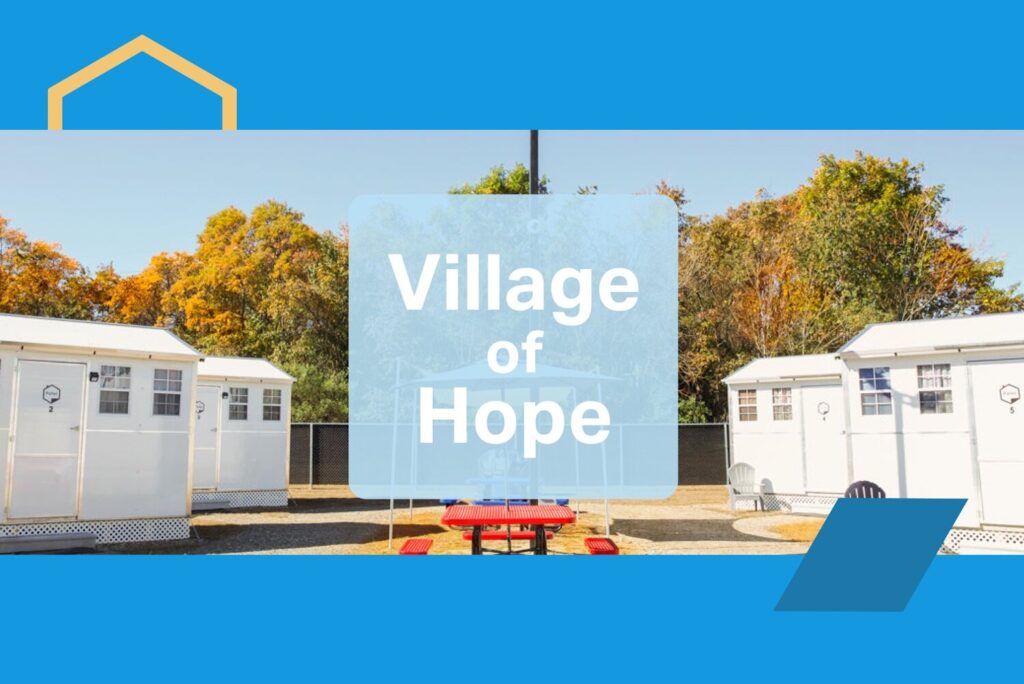
A safe place to regroup
Village of Hope, a new Pallet shelter village in Bridgeton, New-Jersey, will provide safe, stable transitional housing for people recently released from prison and on parole who have nowhere to turn and might otherwise face homelessness.
"Homelessness is a problem," said Bridgeton mayor Albert Kelly. "And this is one way of demonstrating how we can not only house those who are coming out of a halfway house, but perhaps we can expand on this for our homeless in our inner cities. And that's what our hope is."
Collaboration is essential in bringing a Pallet shelter village to life. Gateway Community Action Partnership, a New Jersey-based nonprofit, and The Kintock Group, a nonprofit that focuses on reentry programs, worked together to get the village up and running. It’s centered around six 100-square-foot Pallet shelters, and sits adjacent to a Kintock Group recovery residence. Residents will have access to shared bathrooms, picnic areas, and a community room.
Six residents at a time will stay for up to 180 days, supported by an ecosystem of essential services to help them acquire state ID cards, find work, access health and wellness care, and eventually secure permanent housing.
Each Pallet shelter provides a dignified personal space with a bed, a desk, heating and air conditioning, storage for belongings, outlets for devices, and a mini fridge—plus a door that locks for privacy.
A difficult transition
According to the U.S. Department of Health and Human Services (HHS), nearly 6.9 million people are on probation, in prison, in jail, or on parole at any given time in the U.S. Every year, more than 600,000 will be released from state and federal prison—many without anyone to assist with the challenges of reentry. With a history of incarceration, most will have trouble finding employment and housing, both crucial to building a new life.

That difficulty is compounded by social and economic barriers that contribute to recidivism and homelessness. A Prison Policy Initiative report shows that formerly incarcerated people are almost 10 times more likely to experience homelessness than the general public. And according to HHS, nearly two thirds of prisoners are rearrested within three years of release, and half are reincarcerated. Without adequate support throughout the challenges of exiting the judicial system, chances of recidivism are likely to increase.
A way forward
There is no one-size-fits all approach to support those exiting the judicial system or seeking a path out of chronic homelessness. But stable transitional housing with close proximity to essential support services is a proven model.
Pallet shelters provide safe, dignified space in healing community surroundings. With a network of services on-site, people can begin to think about the next step. We believe people should be defined by their potential, not their past—and a positive future starts with a safe space to sleep and a supportive environment.
From second chance to fair chance: Why we're changing our language

In April 2019, Alex embarked on the path of recovery after using substances for more than a decade. Once he got his life back on track, Alex focused on setting and accomplishing goals, such as getting his license back and buying a car. He joined Pallet along the way and shared the challenges of his journey last year. Since then, Alex has accomplished even more. He shares the details below.
The following has been lightly edited for length and clarity.
Pallet: Things have been going well for you these days.
Alex: We bought our first home, which was huge. Going from a tent to owning my own home in three and a half years, that’s pretty big. I didn't even remotely think that we would be close to even qualifying for it, but my brother gave us his realtors information and we contacted them, and we got approved. Never thought that. With the market the way that it was at the time, I mean, houses were going like that (snaps fingers). We were lucky enough to only look at two houses. And the second house, we put an offer on, and our realtor called us that night and said that we didn't get it. We got out- bid, kind of bummed. But then the next morning she called and said that they retracted their offer and that we got it. So that was pretty exciting. It's a three bedroom, two-bathroom home and it's wonderful. We’ve got a big yard and yeah, it's great.
Pallet: What's it like to own a home?
Alex: It's phenomenal. Just having our own place and not paying somebody else's bills. And it's just a feeling that I didn't think was possible, at least at this stage. I had set a goal when I got clean to get a home in five years and accomplished it in three. I’m pretty proud of myself for that and Amber. She was a big part of it too. And we also got engaged. I think we're going to be setting a wedding date for September of next year. And we got a dog two months ago named Bud. He's a black lab. Then we got a new puppy, Yoda. He's a beagle bull. So, beagle and a pit bull. And he's just freaking cute. But he is a little ball of joy. Little terror, though. But the kids love him, which is great.
Pallet: You were also promoted. Why did you apply for the role?
Alex: Another huge step. Went from the manufacturing side and production to Inventory Control Specialist. It’s a brand-new position for this company. I saw an opportunity to take my career to the next level. I was almost at the top of where I was at and saw a chance to get something that will pay off. Another motivator was Damon (Supply Chain Manager) and the rest of the supply chain team themselves and them all being great people.
Pallet: What are your responsibilities?
Alex: Cycle counting and comparing the numbers that are actually on hand to what our value in QuickBooks says. When there are anomalies, I have to figure out what caused them and then figure out what needs to happen to fix them. Then what needs to happen to prevent them from happening again. It's great working for Damon. He is a phenomenal boss, and all the other supply chain team members are really great.
I have to take a course, CPIM which stands for Certified in Production and Inventory Management. It's an online college course that will help me with my role. I'm working on that and that is huge. It's a lot, a lot of reading, a lot of studying. And I have to take two exams to get the certificate, but once that's completed, that'll hold some good weight and hopefully help me with my role and my future career.
Pallet: You’ve reached several milestones in the last few years. Have you set new goals?
Alex: The next minor, small one is to buy a truck and a boat. My son loves fishing and so does Amber. So that's kind of something I see myself doing in the next three years. But career-wise I would definitely be finishing my CPIM course and hopefully moving up higher in the supply chain team. Obviously staying with Pallet. My heart is definitely with this place. Getting married, that's definitely something that we want to check off. I need to continue to move forward. In order for my recovery to be successful, I need to have those milestones. No matter how big or small, I still have to set some kind of goal to be successful with myself.
Pallet: Have your familial relationships changed since you’ve been in recovery?
Alex: When I fell off, they kind of stood back. But as they've seen the progress that I've made, it's all come back tenfold. It's been great. Especially the relationship with my dad. It always used to be when I’d call him, it'd be something that he'd have to worry about, why I'm calling, what's going on this time? But now when I call, he's excited and we can have an actual conversation. I've earned trust back. I've earned all of it back. Good standing with the families. Recently my dad, mom and my 84-year-old grandma visited, and they got to see my new home. We spent the weekend with them, and it was a good time.
Pallet: You’ve been in recovery for almost four years now. Do you stop often and take that in?
Alex: Time just flies by. I can't believe it's already been that long. But the more I can push that in the past — I still reflect on it from time to time and, you know, remember where I came from. I'm just so thankful every day that I got out. The blessings that I have today are just so great. My family is just wonderful. I love really everything about my life right now. It's just great. I want to continue going up and doing the next best right thing. It’s good.

By Bri Little
It's estimated more than 500,000 people across the country are unhoused. This growing statistic includes Veterans, children, and people who are employed. Some people are chronically homeless, while others stay in hotels until they can find stable housing. Homelessness affects communities across the country, from major metro areas to rural towns.
One common misconception about homelessness is that there are enough emergency shelter beds in any given city, but homeless people just don't want them. This myth is untrue for several reasons:
There is evidence that cities vastly undercount their homeless populations. Point-in-Time Counts, which relies on volunteers hand-counting the number of visibly unhoused people they encounter on a given night, has been under fire for some time. The King County Regional Homeless Authority in Washington state cited "harmful methodology" for not following the traditional approach for the 2022 Point-in-Time count. Instead, they received a methodological exception to conduct the count differently, allowing them to seek more qualitative data.
More evidence suggests cities have insufficient resources to house people, even temporarily. In 2019, the Ninth Circuit Court of Appeals ruled that cities cannot enforce encampment sweeps if there are not enough shelter beds in Martin v. Boise. The ruling means that without enough shelter space for a city's homeless population, such as Seattle or San Francisco, city officials cannot enforce anti-vagrancy laws or prohibitions against camping in public parks or sidewalks.
Many cities with large homeless populations invest resources — which could be used for permanent supportive housing — in encampment sweeps. Sometimes people are only offered emergency shelter during sweeps, which are traumatic and disorienting events where their belongings are thrown away. Sweeps aren't a method to solve the homelessness crisis; it simply is a way to move people out of sight and around the city.
Due to the pandemic, shelters have closed or have diminished capacity. Further, since COVID precautions have been lifted in most places, it may be safer for individuals with certain health conditions to live outside than to be close to others.
People may not be able to stay in a shelter for myriad reasons. They include: desiring a sense of stability an emergency shelter cannot provide, wanting to stay with their pets/family, sanitation concerns, previous trauma related to living with strangers, domestic violence histories, and preferring vehicle residence. People already living outside have all their belongings with them, and they often cannot store all their possessions in a shelter.
It's harmful to pigeonhole people with various needs into a limited approach, such as emergency shelter. Then blame them for not being able to or not wanting to access a service that’s not one size fits all. Stable solutions that holistically meet their needs will help address this crisis.
Pallet shelter villages bridge the gap between living unsheltered and permanent housing by combining dignified space with a locking door and on-site social services. They are a proven model of success.
Bri Little is a DC-raised, Seattle-based writer and editor.
This post is part of an ongoing series debunking homelessness myths.
Part One: They are not local
Part Two: Homelessness is a personal failure
Part Three: Homelessness is a choice
Part Four: Homeless people are lazy
Part Five: Homelessness can’t be solved
Part Six: Homelessness is a blue state problem
Part Seven: Homeless people shouldn’t own pets
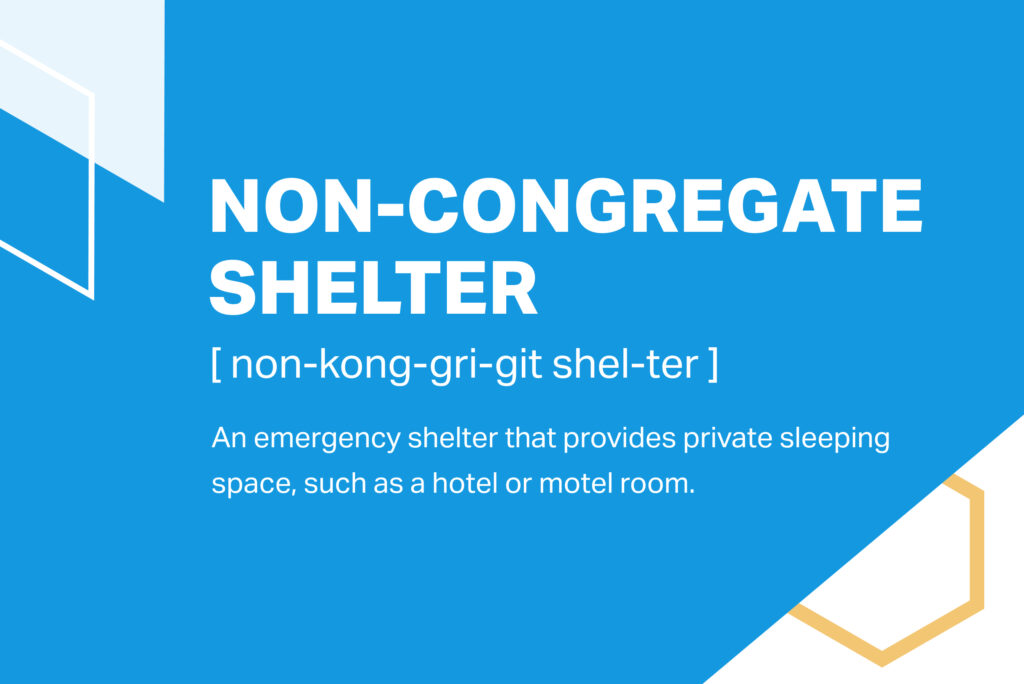
Homelessness is a complex, nuanced issue that takes time to understand fully. Organizations, experts, and advocates within the homelessness field use specific words and phrases that aren't common knowledge. To help bridge the information gap, we've put together another list of terms to help you better understand homelessness-related issues.
The list addresses metrics the federal government uses to determine who qualifies for aid, programs available to states to help unhoused people get back on track, and more.
1. Non-congregate shelter
A non-congregate shelter is an emergency shelter that provides private sleeping space, such as a hotel or motel room. Pallet shelters are in this category because people using them have their own private space and typically aren't sharing it with a stranger.
2. Area Median Income (AMI) / Median Family Income (MFI)
AMI and MFI are often used interchangeably and are the median household in a given region. This statistic is developed by the U.S. Department of Housing and Urban Development (HUD) to determine applicants' eligibility for specific federal housing programs.
3. Rapid rehousing
Rapid rehousing is a housing model designed to provide temporary housing assistance to people experiencing homelessness. This short-term intervention moves people out of homelessness quickly and into permanent housing.
4. Housing choice voucher (Section 8)
The housing choice voucher program is the federal government's major program for assisting very low-income families, the elderly, and people with disabilities so they can afford safe and sanitary housing in the private market. Housing choice vouchers are administered locally by public housing agencies (PHAs). The PHAs receive federal funds from HUD to administer the voucher program.
5. Emergency Housing Voucher
The Emergency Housing Voucher (EHV) program is available through the American Rescue Plan Act (ARPA). Through EHV, HUD is providing 70,000 housing choice vouchers to local Public Housing Authorities (PHAs) to assist: individuals and families who are homeless, at risk of homelessness, fleeing, domestic violence victims, human trafficking survivors, or were recently homeless or have an elevated risk of housing instability
6. Housing First
The Housing First model prioritizes providing permanent housing to people experiencing homelessness. This serves as a platform for them to pursue personal goals and improve their quality of life. This approach is guided by the belief that people need basic necessities like food and a place to live before attending to anything less critical, such as getting a job, budgeting properly, or attending to substance use issues.
7. Single Room Occupancy (SRO)
An SRO is a residential property that includes multiple single occupancy units. If the unit doesn't have a food preparation area or a bathroom, those facilities are shared. During the mid-70s and 80s, there was a sharp decline in SROs in cities such as Los Angeles, Seattle, and New York. This housing option reduction is considered a contributing factor in the rise in homelessness.
8. Affordable Housing
According to federal government standards, housing and utilities should cost no more than 30% of your total income. Publicly subsidized rental housing usually has income restrictions, dictating that tenants cannot earn more than 60% of the area median income. Homelessness rates rise faster in cities where residents spend more than one-third of their income on rent.
9. Temporary Assistance for Needy Families (TANF)
The TANF program allows states and territories to operate programs designed to help low-income families with children achieve economic self-sufficiency. States use TANF to fund monthly cash assistance payments to low-income families with children and a wide range of services. The U.S. Department of Health & Human Services administers the funds.
10. Supplemental Nutrition Assistance Program (SNAP)
SNAP is a federal program that provides nutrition benefits to low-income individuals and families used at stores to purchase food. The program is administered by the USDA Food and Nutrition Service (FNS) through its nationwide network of FNS field offices.
11. McKinney-Vento Homeless Assistance Act
The McKinney-Vento Homeless Assistance Act is a federal law created to support the enrollment and education of students experiencing homelessness. McKinney-Vento is intended to provide homeless students the same educational opportunities as housed students by removing as many barriers to learning for homeless students as possible.
12. Hostile architecture
Hostile architecture limits how people experiencing homelessness use public spaces and discourages them from staying in an area for too long. Examples include a bench with an armrest in the middle, spikes, and boulders. Here's more on the impact of hostile architecture.
Defining the types of homelessness
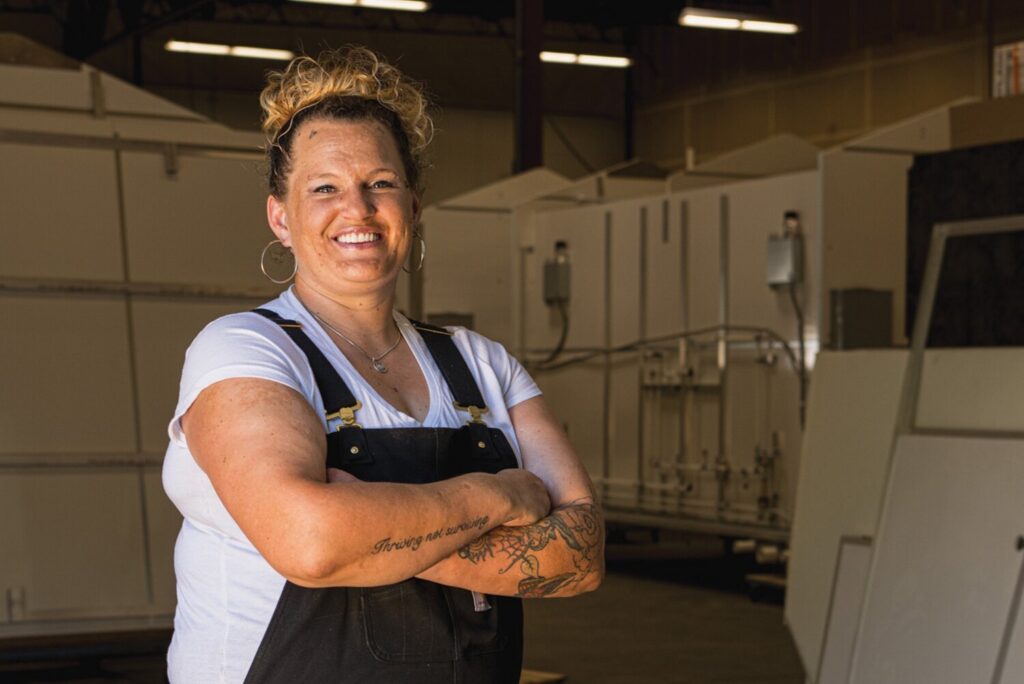
Lacey has a smile that lights up the room. Her positive outlook is contagious, and she's a joy to be around. Lacey joined the Pallet team as a Manufacturing Specialist at the beginning of the year. In this role, Lacey moved from station to station in the factory to build the shelter panels. She enjoys working with her hands, so it's been a good fit.
"I loved putting the windows in. That was really fun. I did a lot of roofs.," she shared." I love working in production."
Within a few months, she went from manufacturing shelters at our headquarters to joining the deployment team, a dedicated group of staff who specialize in on-site shelter construction. Lacey has set up Pallet shelter villages across the U.S., from Sacramento, CA, to Burlington, VT.
"When I first started here, I heard about the deployment team, and I was just like, that seems like it just sounds like a dream job to be able to travel around. I'm a really hard worker," she explained. "I love the fast pace of deployments. I love running back and forth doing that stuff. I'm just excited."
In addition to being enthusiastic about being on the team, Lacey is thankful to be working alongside others with similar backgrounds. It was uncomfortable for her to disclose she had felony convictions to an employer in the past. She shares one of her experiences, "I had an interview, and the lady was just looking at me just crazy the whole time. I felt extremely judged. It was awful."
Lacey’s interview experience was different at Pallet because we're a Fair Chance employer. We believe in people's potential, not their past. More than half of Pallet staff are in recovery, have experienced homelessness, and/or have been impacted by the justice system.
"To be around a bunch of people that have been where I've been and are striving to go where I want to go — it's a good environment," she added.
Next month Lacey will celebrate being in recovery for two years. A tattoo on her forearm that says "thriving, not surviving" reflects how far she's come. Her substance use disorder began with a back injury she received at work when she was 19. A doctor prescribed her OxyContin. She used it to alleviate her pain for several years, but Lacey says the opioid shouldn't have been the treatment. Later, she had two laser treatments which technically negated the need for OxyContin.
"I had no idea that it was synthetic heroin. I had no idea that opioids were so powerful. Then they were like, 'Okay, it's time to get off of it,'" she explained. "It was everywhere. Everybody that I knew was doing it. Everybody was just smoking these pills, and so I just started."
She continued to work, but maintaining a full-time job became increasingly difficult. She moved onto other substances, and her life began to unravel. She had to quit her job, lost the home she bought a few years earlier, and had been arrested several times. She lived in a car and tried to survive. These were stressful times for Lacey that lasted many years, but after undergoing detox five times, and three rehab stints, Lacey was ready to make a change.
"You're not done until you're done, you know what I mean? You can go through the process over and over," she shared. "You can be forced to go to rehab, you can be forced to do whatever, and it does not matter."
Two years ago, Lacey was ready to stop using substances partly because a milestone birthday was approaching, and she wanted to live a different life. One where she had a stable place to live, employment, and no longer using substances.
After serving a sentence in county jail, Lacey moved into an Oxford House, which is recovery housing. Initially, Lacey wanted to live independently, but the peer-supported environment was a perfect fit. They share expenses, hold weekly meetings, and support one another. As part of recovery, Lacey attends Narcotics Anonymous (NA) meetings and tells her story to others. She can also spend time with her family, who live nearby.
After many years of tumult, Lacey is focused on leading a quality life. Pallet is proud to be a part of her journey. She exemplifies why diversified hiring practices are vital to our success. Lacey brings compassion and optimism to the team.
"Pallet is a place where you're welcomed with open arms. It's really freeing to be able to walk in here and be around a bunch of administrative people — who most likely have not been where I've been — and not be judged," she said. "I'm so grateful to have the opportunity to work and be able to gain my self-worth. I know what it was like to just give up on life basically."
Q&A: Mayor Cassie Franklin on addressing unsheltered homelessness
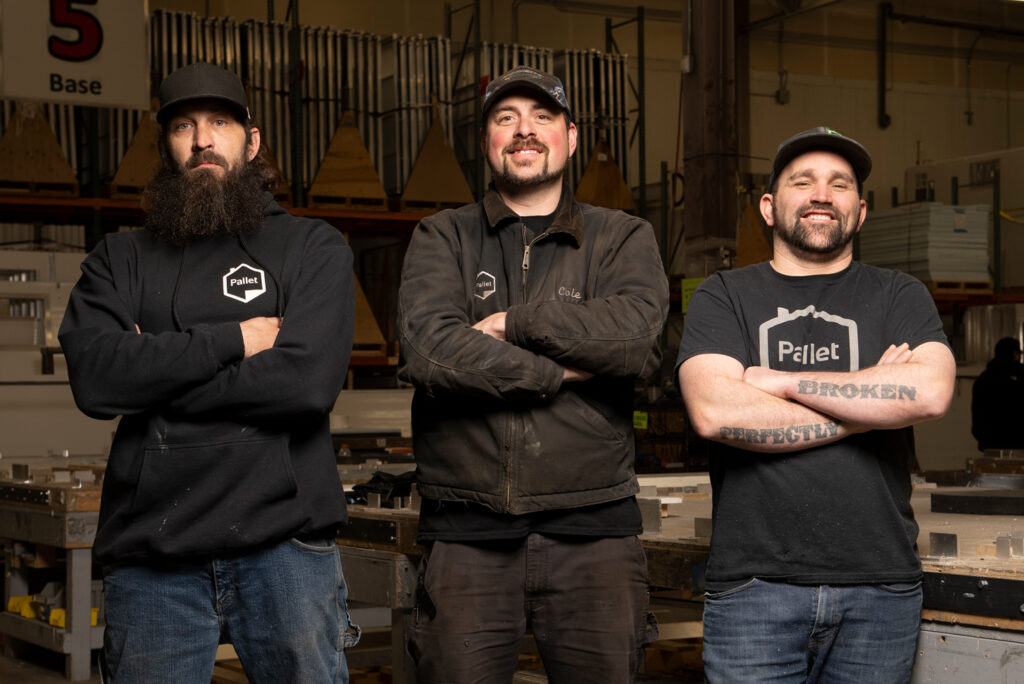
Pallet is the leader in rapid response shelter villages. There are nearly 100 active villages across the country where unhoused people can access dignified shelter with a locking door and on-site social services. With their basic needs taken care of, residents can focus on taking the next step.
Today Pallet is addressing unsheltered homelessness at scale and building a nontraditional workforce. Among the more than 100 employees, three people have been a part of this innovative endeavor since the beginning — Brandon, Cole, and Josh. They were early adopters of our mission and continue to play an integral role as we grow. All three have backgrounds in construction, so Pallet was a natural fit.
Here's a look at Pallet’s growth from their perspective.
Pallet is born May 2016
Pallet began with the idea of sheltering displaced populations, and it took some time to design the physical structure. Our engineering team created several prototypes before finding suitable materials and shelter sizes. Brandon recalls those early days.
"Lots of waves and roadblocks. They did a lot of research to figure out a lot of different things — fire rating to snow loads, wind ratings, square feet," Brandon explained. "I remember so many hurdles to get over because this was not a normal product. This was not a piece of wood."
Building the shelters was lengthy and tedious because the team cut each of the seven panels with a skill saw. By summer 2020, Pallet added a CNC router to the factory, which improved accuracy and efficiency. What initially took months to build can now be done in a fraction of the time. The manufacturing team produces 50 shelters a week.
"The evolution of this product is crazy," Cole shared. "You never would have thought it was going to have an air conditioner, a breaker box, and a heater and all these amenities that most of our houses have nowadays."

In the beginning, we held numerous demonstrations to showcase our shelters. It's where Brandon realized this was what he wanted to be doing — building dignified space for our vulnerable neighbors. At this point, he'd built a strong relationship with Pallet's co-founders, Amy and Brady King. Brandon believed in them and what they set out to accomplish. He ignored those who didn't think our transitional shelters would work.
"I knew it was a good idea. I just wholeheartedly knew it. And I didn't really have a reason why," Brandon shared. "I just knew that it felt good to do this, especially once we started doing deployments, then it really kicked in."
While Pallet worked to find its footing, only a handful of people were working for the company. Over time the number steadily increased, and today there are more than 100 employees. Josh was one of two in the factory building shelters when he started. Now he's surrounded by dozens of others and working on research and development. During company-wide meetings, he marvels at the number of people present.
"Every time we have an all-hands meeting, I get choked up every single time. I'm just blown away with how many people we have here," Josh shared. "The ways that we've grown and moved forward. It's just unbelievable."
Personal growth
As Pallet evolved, so did the team. Josh talks fondly of the relationship he built with Zane, recently retired Director of Engineering, and Greg, now Director of Operations. Josh said the two helped mold him.
"We all came from a construction background, and it was yell, scream, and get your point across. Zane taught us how we didn't have to do that. We could actually talk civil and come up with ideas together," Josh shared. "That's what I strive for in the R&D section. If I have an idea, I'm going to ask four people before I actually do it because what if I'm thinking wrong?"
For Cole, joining Pallet was an opportunity to move away from the grueling work of building permanent homes. He'd been working in construction since he was a teenager and thought he would be stuck in that role until he couldn't walk anymore. He's moved from Manufacturing Specialist to Supervisor to Manufacturing Engineer. Cole's time at Pallet coincides with his recovery journey.
"I focus really hard on a daily basis on growing as a person to better my people skills and my career," Cole added. "Being teachable and being humble and learning something new every day."
In addition to personal development, all three say being able to help those in need is a bonus for working at Pallet. They've each been able to talk with Pallet shelter village residents who are stabilizing and working on moving into their own place.
"It's not just about helping people. It's about changing people," Brandon shared. "When you can be there on-site and watch them move in and see how happy they are. That was probably the greatest reward I've ever had when I came to this company."
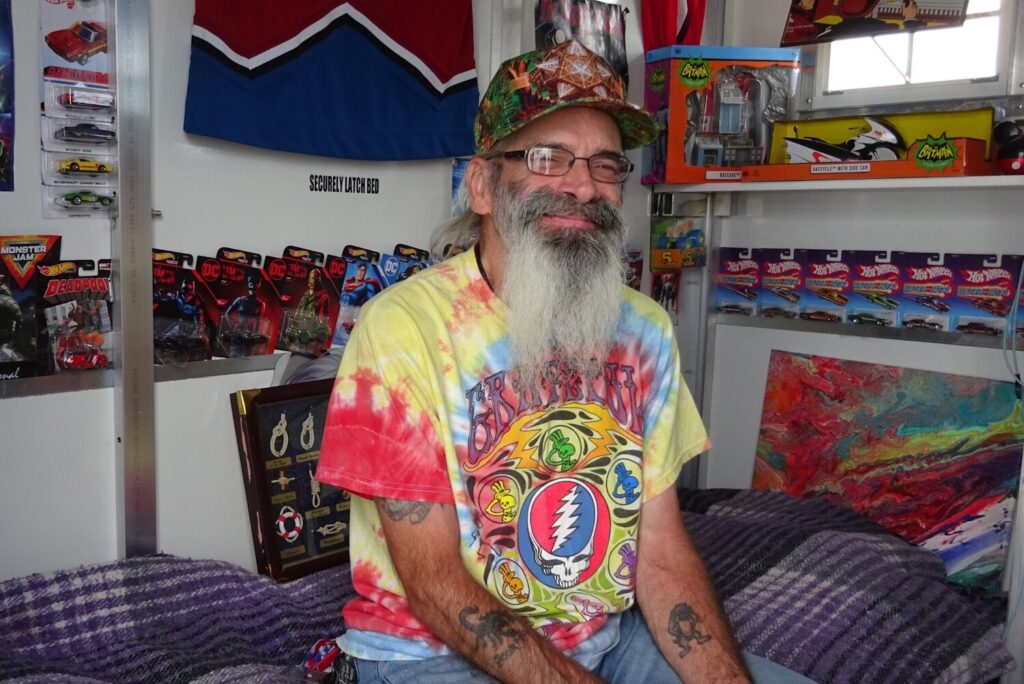
The inside of Tim's Pallet shelter in Aurora, CO, reflects what brings him joy. Denver Broncos and Colorado Avalanche jerseys brighten the space. A replica of a Detective Comics cover with Batman on the front is over the window. And dozens of Hot Wheels line the wall. Some are superhero-themed, while others are sleek racers inspired by real sports cars. Each is still pristine, encased in the original packaging. For Tim, they are much more than a toy marketed to kids.
"That is my salvation," he explained. "That takes me back to a more innocent time in my life where I can just lose myself in Hot Wheel cars. It was easy for me to do it as a kid. It's really easy for me to do it as an adult. They're the coolest things on Earth."
At one point, he had 3,500 Hot Wheels.
"They were my wallpaper in my dining room and kitchen of one of my apartments. I don't have that collection anymore, but I'm acquiring a new one," he added.
Tim is originally from Buffalo, NY, but he's lived in Colorado for years. He became homeless after a series of distressing events. First, he lost his job, then the apartment building he lived in was sold. His lease wouldn’t be renewed, leaving him with 30 days to find a new place.
"Covid knocked on our door a couple of months after that, and it's just been one speed bump after another that has culminated in where I am right now," he shared. Tim went on to stay at a mass congregate shelter with hundreds of other people. Next, he moved to the current site known as Safe Outdoor Space (SOS), which has 56 Pallet shelters. "This is way better. You have your own key. You have four walls that you can lose yourself in or whatever, and you can ride out whatever unpredictable in your life, save up some cash and move on to your next step."
Stabilizing in a safe, secure space positively impacted Tim's life. He no longer must navigate what he described as the chaos of being homeless. He's also enjoying independence.
The Salvation Army is the service provider at the site. Tim has been working with staff to take the steps necessary to move on to permanent housing. For example, he now receives income from the state's Old Age Pension Health Program (OAP), which provides financial assistance to elderly and low-income residents. About a month ago, he received the good news he's been waiting for. The Aurora Housing Authority let him know he was awarded a lifetime housing voucher.
"This voucher is a godsend," Tim shared. "With the little income that I have that the staff here helped me secure, I should be okay."
Because he has a voucher, he's only responsible for a portion of the rent. Now Tim is searching for an apartment to move into, which he's confident will happen soon. He's looking forward to getting back to the everyday life he led before becoming unhoused.
When asked what misconceptions people have about homelessness, Tim points out the absurdity of stereotypes and the assumption that all homeless people are the same.
"Nobody wakes up in the morning and says, 'I want to sleep on a piece of grass this morning. Or when I go to bed tonight, I want to sleep on a park bench or under a table or wrapped around a tree.' This isn't a social experiment," he shared. "The stigma, it's the word ‘homeless’ that scares the general public into a fit that they don't want nobody around them if they're homeless. We have to eat just like everybody else. We have the right to get our life back in order like anybody else that has a hard time."
UPDATE: At the beginning of October, Tim moved into a one-bedroom apartment, and he couldn't be happier. He credits several factors and a community of people coming together to help him navigate the path back to permanent housing. It includes the Salvation Army caseworkers, the Aurora Housing Authority, which granted him a housing voucher, and the ability to live in a Pallet shelter. Tim is grateful that he's now in a position to help others. He also has plenty of room for his Hot Wheels collection.

Building a path to permanent housing at Esperanza Villa

It's been another sweltering summer for many cities across the country. Days where temperatures reach triple digits are no longer as rare as they once were. Even the Pacific Northwest, an area known for having a moderate climate, hasn't been spared from record-breaking temperatures. As meteorologists issued extreme heat warnings, people did their best to stay cool.
Heat Wave Dangers
When the weather becomes unbearable, people without a stable place to call home are vulnerable to adverse health conditions and even death. According to an Associated Press report, "around the country, heat contributes to some 1,500 deaths annually, and advocates estimate about half of those people are homeless." Statistics from Maricopa County, Arizona — where Phoenix is located — show 130 homeless people died last year from heat-associated conditions. The number of deaths decreased from the previous year, but it was almost double the 2019 statistic. People who live in homes are also at risk for heat related death since having air conditioning isn't always a given.
To combat elevated temperatures, many cities open cooling centers. It's an essential tool because prolonged heat exposure can lead to numerous health problems. Groups at greater risk for heat stress include elderly individuals, those with chronic conditions such as heart disease, and people experiencing homelessness. According to the CDC, illnesses associated with heat include:
- Heat Stroke - occurs when the body can no longer control its temperature.
- Heat Exhaustion - the body's response to an excessive loss of water and salt, usually through excessive sweating.
- Rhabdomyolysis - also known as rhabdo, is a medical condition associated with heat stress and prolonged physical exertion.
- Heat Cramps - usually affect workers who sweat a lot during strenuous activity.
- Heat Rash - a skin irritation caused by excessive sweating during hot, humid weather.
Pallet shelter villages play a crucial role in helping our unhoused neighbors avoid the perils of living outside when a heat dome settles on an area. Our shelters are dignified spaces with a locking door and climate control which help keep the interior cool in the summer and warm in the winter.
Candace recently moved into a Pallet shelter in southern California. The week she settled in, temperatures in the area reached the mid-90s. After previously sleeping in a tent, she was thankful for a cool place to rest and recharge. "The AC is nice. It's a blessing to have the air conditioning," she said.
Cold Snap Concerns
Conversely, winter is also a hazard for our unhoused neighbors. Tents, tarps, blankets, and warm clothing can only do so much, especially when temperatures get down to single digits. If someone makes a fire or uses a camping stove for heat, that also presents hazards. Even when someone is living in their car, they can’t have it running all night to stay warm.
According to the CDC, hypothermia, and frostbite are the most common cold-related problems. When exposed to cold temperatures, your body loses heat faster than it can be produced. While hypothermia is mostly associated with very cold temperatures, the CDC says it can occur even at cool temperatures, above 40°F, if a person becomes chilled from rain, sweat, or submersion in cold water.
The heaters and insulation in the panels of Pallet shelters keep residents warm. Jay Gonstead moved into one of our shelters in Madison, Wisconsin, in December 2021. In an interview, he told a local reporter that when approached by outreach workers about moving into a cabin, he said yes because, "you knew you were going to be warm. You knew you were going to be safe here."
Rain, Wind, Snow
Rain, wind, and snow are also problematic weather events for people living outside. Tents and tarps offer little protection against those elements. Pallet employee Sarah, who experienced homelessness before joining the team, shared why it's difficult to live outdoors in those conditions.
"The winters and the rain were definitely the hardest, of course, because you're so cold and you're so wet. And then to be able to find dry clothes from whatever garbage can or from wherever you can find them," Sarah explained. She also had to escape from fires that started inside her tent while trying to stay warm.
Pallet shelters offer protection from rain, can withstand 110 mph winds, and have a 25lb per square foot snow load rating.
There are many other challenges to living outside that make it unsafe. At Pallet, we're working towards the goal of ending unsheltered homelessness. With each village we build, more people are brought inside, protected from the weather, and their basic needs — such as meals and showers — are met. Residents also have access to a resource net of services that enable them to move into stable, permanent housing. By providing this opportunity, people experiencing homelessness can focus on the next step, rather than solely survival.
Debunking Myths: Homelessness is a choice

Pallet shelter villages are transitional communities for people experiencing homelessness. They provide the dignity and security of lockable private cabins within a healing environment. Residents have access to a resource net of on-site social services, food, showers, laundry, and more which helps people transition to permanent housing.
There are more than 70 Pallet shelter villages across the country, including one near our headquarters in Everett, Washington, which opened one year ago. Everett Mayor Cassie Franklin was instrumental in bringing the site to life. Recently we held a webinar to discuss the affordable housing crisis, why unhoused people don’t accept traditional shelter, and the steps Everett took to build a Pallet shelter village. Mayor Franklin provided good insight into these issues. Before becoming an elected official, she was the CEO of Cocoon House, a nonprofit organization focused on the needs of at-risk young people.
Below is a lightly edited version of the conversation.
Pallet: How has the affordable housing crisis affected your area in the past three years?
Mayor Cassie Franklin: First of all, Everett has had a housing crisis. The West Coast has had a housing crisis for decades now, and the pandemic has only exacerbated that. So the last three years it has just gone out of control. Everett is about 20 miles north of Seattle. Seattle was always an affordable big city, and people would move to a more affordable working class community like Everett. Now Everett is also becoming unaffordable. I just actually had a conversation with one of our residents that her rent was going up $300 a month and she's on a fixed income. That is not going to be affordable, and that's going to lead folks like that individual into homelessness if we don't protect the affordability that we have in our communities.
Because affordable housing is for everybody. It is for our nurses, it is for our firefighters, our police officers, our baristas, our working families need affordable housing. Everett needs housing at all price points.
The homelessness crisis has escalated tenfold, I guess, in the same period. So I just want to say that they're both interrelated very important issues that we're working towards. And I see Pallet as a very important tool in addressing homelessness and making sure that we have pathways to affordability for folks.
Pallet: Can you discuss funding sources available to fund Pallet shelter villages or comparable models?
Mayor Franklin: Before actually all that federal funding that's available right now, we were interested in Pallet and interested in making it happen. So we started to work with the team to identify how we could do it using city-owned property. So that helps with the expense right there. If you take city owned property that's underutilized, that's just — you're holding it for future purpose.
We were also able to get a state grant from the Department of Commerce, our county human services, and of course, American Rescue Plan dollars. Pallet is so affordable. I think that as a city and you're trying to figure out your way out of this housing crisis or how to build a new shelter, you're talking millions of dollars, and it's overwhelming. It is so much more affordable that it's kind of mind blowing how much easier it is to get temporary shelter up. There are so many people that congregate shelter is not the appropriate solution for.
The folks that we were seeing in our city that were like, okay, we've got these great service providers, we've got these hotel vouchers, we've got these dollars in these programs, but none of our unsheltered population wanted to access those services. There were just too many barriers. And I needed a solution for the folks that were living in encampments, for the folks that really were service averse. We needed far less funding than we would have to buy a motel or build a shelter or acquire even a warehouse to house people.
The city continues to work on permanent supportive housing. That is our goal. We've built permanent supportive housing here. It takes years. We're very proud of it. We need so much more of it. We are continuing down that path, working with outstanding housing developers, our nonprofit partners that understand the population that needs services. But I can't wait four years for a new housing project to be built and for us to get all the complex funding for that. I needed something more quickly, and that's where Pallet came in to provide that bridge.
(Note: Federal funding from FEMA and HUD is also available to use towards building Pallet shelter villages, safe sleep sites, and other interim shelter solutions. Pallet’s Community Development team can connect cities and nonprofits with these sources.)
Pallet: What is the goal of these villages and what are the other measurable or quantifiable results that you consider successes?
Mayor Franklin: We had this area that was just a disaster. It was a huge encampment. We got so many complaints. It was not safe for the individuals out there. So we had angry residents complaining that we weren't taking care of the city. But I was also just really worried about the people that were living in those unhealthy conditions, health hazards. This is not an okay environment for people to sleep in.
We were able to get people inside living safely in their dignified four walls and the businesses that were impacted, again, this also helped us locate it. So all the NIMBYism like, ‘oh, this is going to make our neighborhood worse,’ actually it made the neighborhood better. It has improved the neighborhood. We took care of the health crisis. We have a safer neighborhood there now. And the people in the Pallet shelter community are after months, it takes time because these are service averse populations that have a lot of trauma from years of abuse on the streets and drugs and whatever illnesses they've been dealing with. But they are getting treatment, they are connected to social workers, they are getting medical treatment and some of them have been able to transition out of a Pallet [shelter] into permanent housing. So to me that's a huge win.
Pallet: How did you go about choosing the location you selected?
Mayor Franklin: It's the hardest thing right? No one wants to see people living outside. They get angry, but no one wants a shelter or any solution in their neighborhood, even affordable housing, which is just like housing. Honestly, people get worried about that. So the way we did it was I asked the team for a map of all of our public properties. I want every single public property. I want us to evaluate everything that we own, if any of those would be viable. I also asked to look at anything else if it was a site that they thought would be suitable. Probably not smack dab in the middle of a single family neighborhood. You're going to get the most NIMBYism and most pushback in that community. And so after the team, public works planning, our community development team and certainly working with Pallet, analyzed all of those different sites — how many people we would want to house and how we could get the services to the individuals — we identified one that was right behind our mission (Everett Gospel Mission). And again, that was hard because this was an area that was already being impacted by the services. We have the only shelter in the entire county right here in Everett.
And so they were like, ‘Are you kidding me? You're going to put more shelter in our neighborhood.’ The businesses and the residents in that neighborhood were scared, so that's why we looked at, okay, well, what can we do to improve the neighborhood? How can we make sure that this is actually going to be a positive impact, not a negative impact? And the no sit, no lie [ordinance] was very helpful.
We have two other Pallet shelter communities coming up. One is going to mainly house single adults, mainly single men. The next shelter is for women and children, and that is very close to a single family neighborhood. And so that is where that project will be going. And then a third site that we'll be discussing is on unused property that the city owns that is kind of somewhat close to residential, but more close to former industrial. So it's kind of like finding those transition properties in your city. That kind of where you're almost making everybody mad, your businesses and your residents, but it's not in the middle of anybody's area. Those borderline properties, and again, city owned.
Pallet: Anything else you’d like to add?
Mayor Franklin: I think separating the affordable housing crisis from the homelessness and kind of the street level issues that we're dealing with, they are not the same. The community gets them all mushed together, and that doesn't actually help us in our cause. So really talking about them strategically as separate issues that somehow they do relate, but they're separate issues. And so when you're talking about homelessness and the street level social issues and what we're dealing with there, finding solutions for non-congregate shelters are super important.
The main thing is land, education and balance. You've got to find the land and break through that, and that is achievable. Cities do have a lot of land. We did a ton of outreach before we put up the first Pallet shelter. Helping people understand this is not what you think it is. This is something very different. This is actually going to move people that are living outside causing problems for you inside and also educating the community. This is different than the other shelters you've experienced.
Breaking the cycle of homelessness in Aurora, CO

Pet ownership is a quintessential part of American life. Statistics show 70 percent of households across the country own at least one pet. From parks to specialty items, there's an entire industry catering to the needs of furry family members. But when a pet owner is unhoused, their ability to care for an animal is questioned.
A prevailing myth is that people without a stable place to live shouldn't own pets and should give them up. According to a Homeless Rights Advocacy Project (HRAP) policy brief, "this advice is predicated on the false belief that surrendering dogs to shelters is superior to having a dog live on the streets with its owner." But that's not true. The brief adds, "shelter conditions alone cause severe animal suffering and unnecessary death." Some also falsely believe people experiencing homelessness are unworthy of owning a pet and are incapable of caring for them. These misconceptions are dangerous and have led to the harassment of homeless people on the street.
Jennifer, Human Resources and Safety Specialist at Pallet, knows firsthand the value of having a pet while homeless. Jennifer's bond with her dog Bailey began when she was housed, but later they lived in a car, then an RV. Bailey helped fill the void in Jennifer's heart and alleviate the pain and suffering she was going through. Jennifer was dealing with personal setbacks and substance use disorder at the time.
"Even in some of my darkest moments, Bailey was the reason I didn't just give up and quit and die. Because then it was like, what's going to happen to Bailey?" she shared. "She was literally my reason for not giving up and helped me really get through a lot."
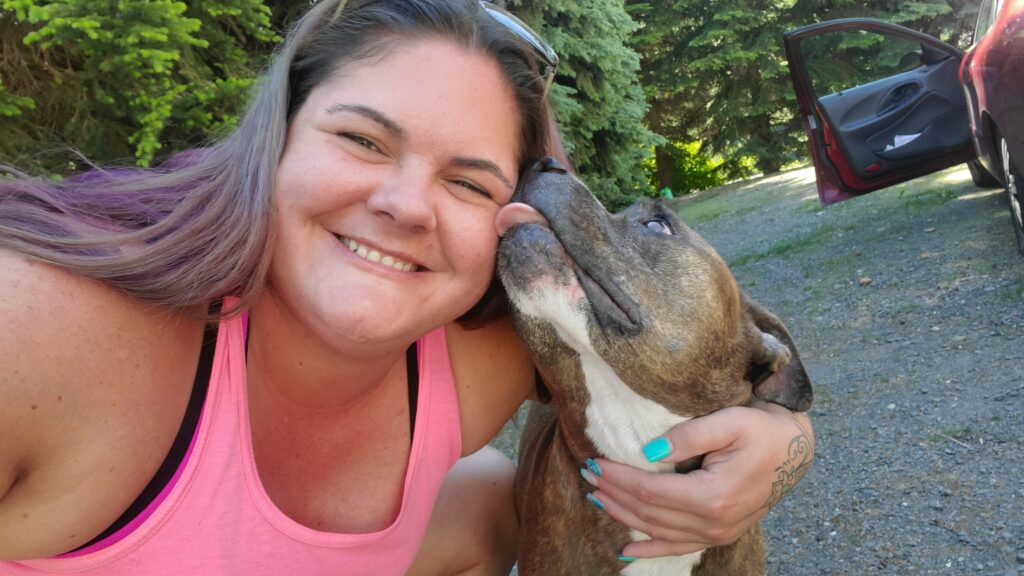
Jennifer took great care of Bailey and was attentive to her needs. Homeless pet owners often feed their animals before feeding themselves. For Jennifer, Bailey was a source of protection, companionship, and unconditional love.
"When you're in those situations of being homeless, you need something to hold on to, to keep going, to keep surviving. You can be a single mom living in your car, and CPS (Child Protective Services) will still leave you alone," Jennifer shared. "Just because you don't have a roof and four walls around you doesn't mean you're not functioning. It doesn't mean you're not living, and it doesn't mean that you're not doing the best that you can."
At Pallet, we understand the critical bond between pets and their owners. Because traditional congregate shelters don't allow pets, it's a barrier for unhoused pet owners to accept shelter. At Pallet shelter villages, unhoused people and their pets can stay together in a healing environment while stabilizing and preparing for the next step. Here's what a couple of pet owners staying in our shelters had to say about the benefits of having their four-legged family members with them.
"Most homeless people I've met in my time if they have an animal, they need it because it gives them clarity, some focus, and it gives them something to live for," John explained. His dog, Walter, brings him joy and is his best friend.
"They keep me grounded," Lynette added. "They're my life, really. They're my kids. They're very protective of me."
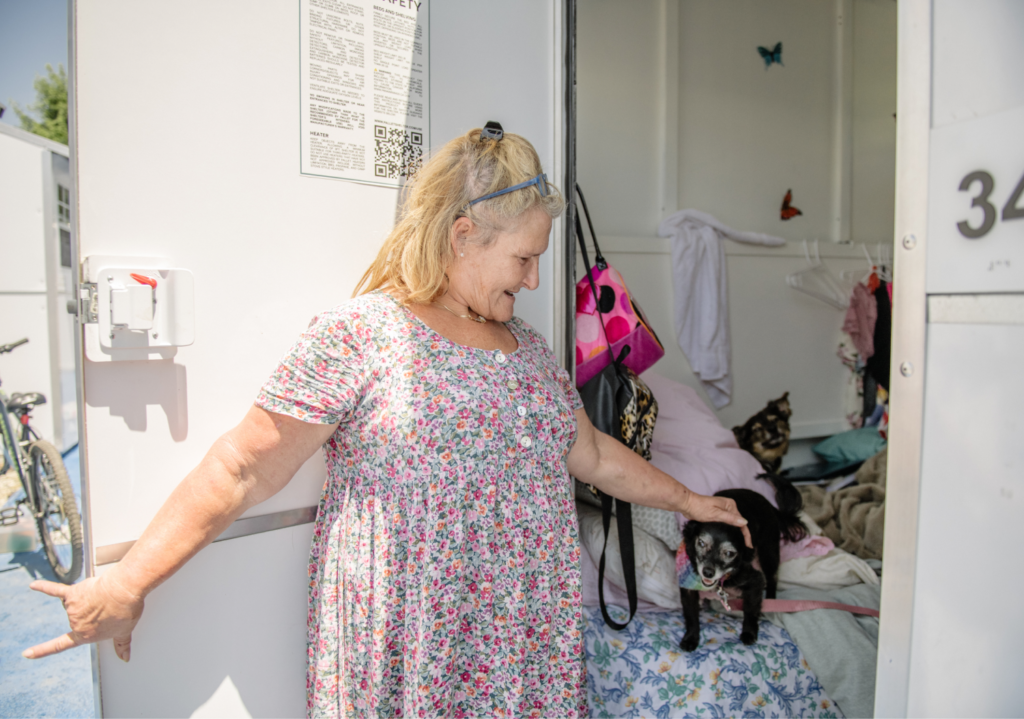
The numerous mental and physical health benefits of having pets don't suddenly disappear when someone is unhoused. Rather than calling into question their ability to take care of their beloved pet, donating food and supplies to the many local organizations, food banks, and veterinarians assisting them would be helpful. Better yet, support transitional housing communities that help people move from the street to permanent housing.
The unhoused community has as much right as those who are housed to build and maintain a bond with a pet if they choose to. The personal experience of Jennifer, John, Lynette, and countless others show having a pet in their life is invaluable.
This post is part of an ongoing series debunking homelessness myths.
Part One: They are not local
Part Two: Homelessness is a personal failure
Part Three: Homelessness is a choice
Part Four: Homeless people are lazy
Part Five: Homelessness can't be solved
Part Six: Homelessness is a blue state problem

*Name has been changed upon request for privacy.
Damone* is a lover of dogs – which is why he sought out Blue, a hyperactive cocker spaniel and husky mix. Blue is only a puppy, but she’s made a huge impact on Damone’s life.
Damone was born in Seattle, then moved to Mexico until he was seven or eight years old. He then came back to the United States, settling in Los Angeles where he’s been ever since.
A few years ago, Damone experienced a severely traumatic incident. Leaving him homeless, he spent over a year sleeping outside on the streets. He tried to go to mass shelters, but they were usually full, so he always had to find a new safe place to sleep.
Eventually Damone connected to mental health services, and was offered a spot to live in a Pallet shelter village. Blue came into the picture shortly after.
Blue, even in her energetic puppy phase, serves as a friend and confidant to Damone, who spends a lot of time on his own. When he needs calmness in his life, Blue has a way of sensing it and adapts to his mood.
“She keeps my mind occupied when I go through depression and anxiety phases. It’s almost like an aid,” he said.
Right now, Damone is working with the on-site service provider to find an apartment. He is looking forward to a more structured life: going to the gym, hanging out with friends, and doing things that make him feel good about himself again.
“I want to find my own peace and live in a normal environment again,” he said. “It’s a blessing to have a place to live [right now]. At the same time, I feel like I can overcome this and be part of society.”
Learn more about building the right shelter for people and their pets

If you’re looking for Pepe – a tiny tan chihuahua – you may miss him at first. His favorite place to hide is Juan’s zip-up jacket. Pepe’s tiny head occasionally pokes out, just far enough to get ear scratches and peek around.
Juan, Pepe’s owner, loves to keep him close for cuddling. The duo first met a few months ago, in a tough time in Juan’s life.
In 2021, Juan was riding his motorcycle and was struck by another vehicle. He woke up in the hospital with his arm bloodied and skin ripped off. His arm had to be partially amputated, and he was in the hospital for a month to recover. Since then, he’s gone through three surgeries, with more on the way.
The accident left him unable to work in his former job: construction and demolition.
As his arm healed and surgeries took place, Juan lived on-and-off with family members – like with his grandfather. But in December 2021, his grandfather passed away, leaving Juan alone without stable housing.
To cope with the loss, Juan’s mom gave him Pepe. She thought the little chihuahua would help keep his mind off what was going on at the time, and become a supportive friend. Juan temporarily moved in with his mom before realizing it “wasn’t going right.”
He ended up on the streets, without a job and income due to his injury. In February he tried out mass shelter, but found, “That experience wasn’t that good,” he said. He was surrounded by people in all different circumstances, and was worried someone might mess with Pepe.
In April, Juan moved into a Pallet shelter village in California. He has a shelter with a lockable door, air conditioning, a bed, and storage for him and Pepe. Juan knows it’s temporary, and looks forward to the future.
“Eventually I hope to get somewhere more stable,” he said. “If it wasn’t for [the motorcycle] accident, I wouldn’t even be here.”
Pepe gives him the support he needs to keep going.
“My life is kind of in shambles right now. [Pepe] gives me hope… I like seeing him when I wake up, when I get back to my room, I know there is someone waiting there for me. It’s not like I’m alone in the world,” Juan said. “I believe everybody should have a friend to guide them through life – that’s what Pepe does with me sometimes.”
Learn more about building the right shelter for people and their pets
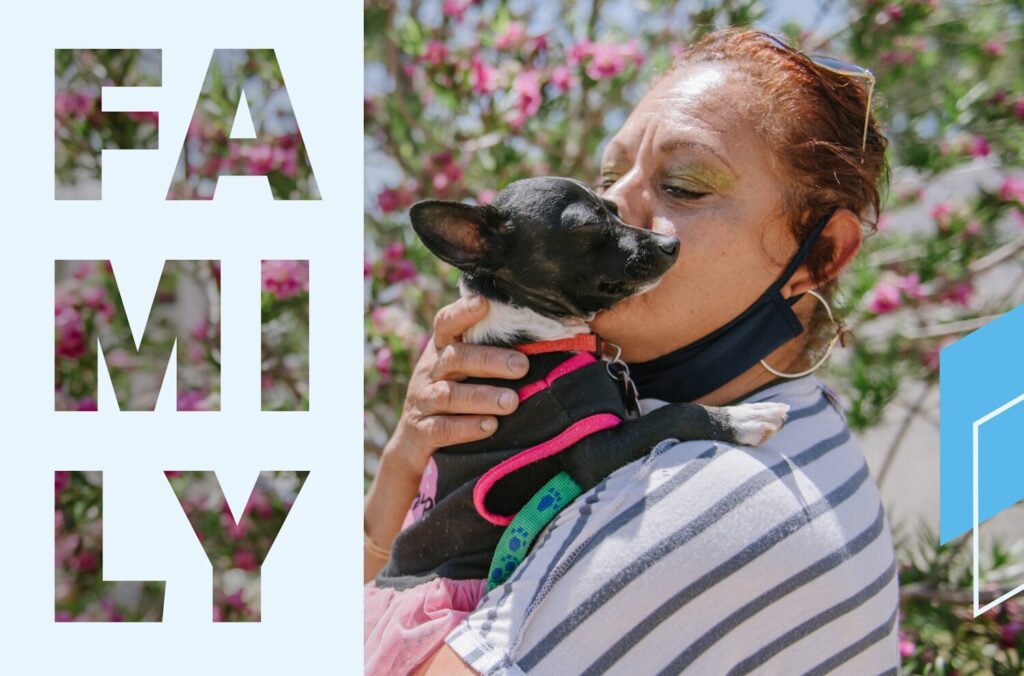
My Lady – a black and white toy chihuahua – is often dressed to the nines. Her black shirt is stamped with a pink heart and perfectly paired with a matching tutu. Daisy, her best friend and owner, cradles her.
They have a mother-daughter relationship, Daisy describes it, which includes playing dress-up.
Knowing her love of chihuahuas, Daisy’s youngest daughter gave her My Lady as a gift. They’re inseparable, taking it day by day in one of Los Angeles’ Pallet shelter villages.
Before Daisy moved into a temporary Pallet shelter, she was evicted and living in her car. When the heater broke in December, it became unbearable.
While on the streets, she worried My Lady would be hurt or taken away. Staying near the train station, Daisy was approached by a police officer who told her, “I think at this point, you shouldn’t have a dog.” Daisy panicked.
“She’s more taken care of than anything, more than me. My Lady comes first,” she said.
The past three years have taken a toll. Daisy lost her housing, saw her sibling pass away from COVID-19, and constantly worries about her daughter, who is on the street with a substance use disorder. Daisy was formerly a registered nurse but had to quit because of her disability. She needed surgery on her back and her ankle.
Daisy eventually moved into a temporary shelter – without any pet restrictions.
My Lady has been there for support. “She fills all those pains,” Daisy said.
My Lady doesn’t just bring joy to Daisy. She’s got a personality to match her chic clothes. She’s a playful pup with furry and human friends. Instead of walking, she hops around like a rabbit, becoming a natural star of the show. She even has a well-known relationship with a German Shepherd.
Daisy and My Lady are always side by side, providing each other unconditional love, laughter, and protection.
Learn more about building the right shelter for people and their pets
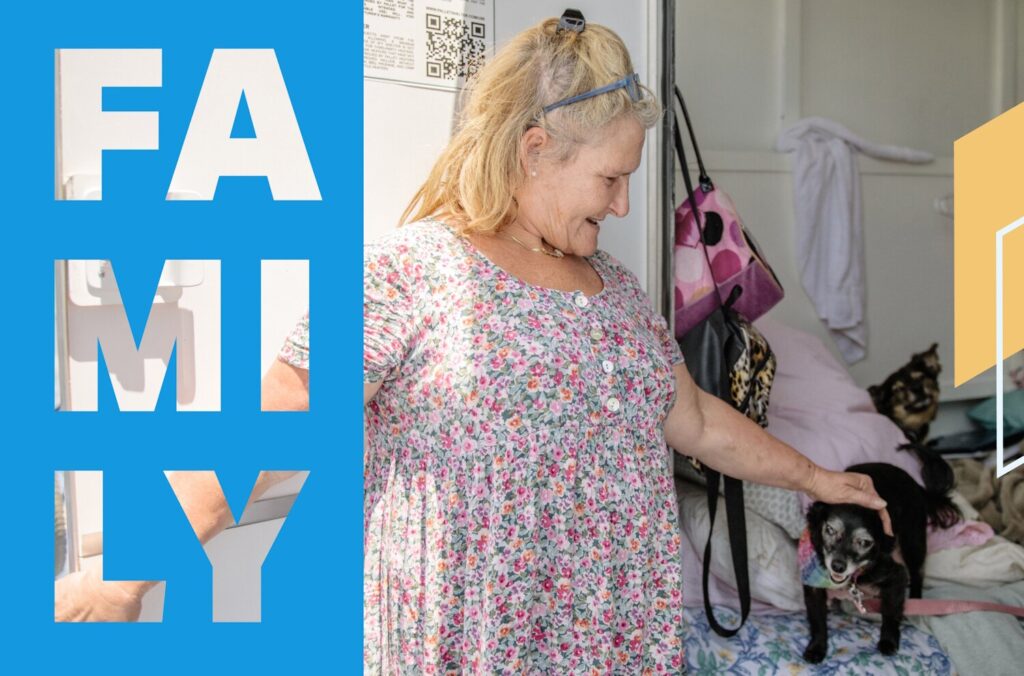
California is home to Lynette. She grew up in the San Fernando Valley, eventually adopting BooBoo, a Pomeranian mix. BooBoo has been with Lynette for 13 years, with RaRa being born soon after.
A few years ago, Lynette and her pups lived in a house in Los Angeles. When a man forged quitclaim deed on her property, she lost her house.
Lynette moved onto the streets. She started off in a motorhome with her previous boyfriend, but she couldn’t handle the uncleanliness. Mostly, she despised the rats.
By moving into her truck, she controlled the space. But it wasn’t easy – especially during summer heat waves; the car became miserable and suffocating.
“I didn’t want to be out there, that’s for sure,” Lynette said.
BooBoo and RaRa became her protectors. Alert and ready to bark, they always knew when someone was unwanted near the truck. Nobody would try to open the doors. Lynette lived in her car for four years – losing track of time. She slept her days away, eating dinner late at night, missing sunrises and sunsets.
“It’s hard to get on your feet once you’ve dropped off,” she said. “We’re all lonely out there. It’s not an easy place to be. When you have pets, you’re not so alone anymore.”
The idea of living in a mass shelter never appealed to her. BooBoo and RaRa are too protective, and Lynette worried about strangers sleeping in nearby cots. Her truck had privacy: locking doors and guard dogs.
“I don’t think I’d ever go to those [mass] shelters,” she said.
Lynette eventually got into a Pallet shelter village with her own space to sleep, a locking door, and a secure area for the dogs to play. BooBoo and RaRa have their pick of dog beds – but they prefer cuddling close. RaRa sleeps curled next to Lynette's head, right on the pillow. During the day, the dogs go on long walks, and explore in the grass.
“[The shelter] has given me a really big stepping stone. I realize it’s nothing permanent, but it’s a stepping stone to get my housing and get me out of here,” she said. “It’s got me grounded again, where I can see the important things.”
After moving into a Pallet shelter village, Lynette began to plan: schedule surgery for her feet and neck, find a permanent place to call home, keep the dogs happy, and go back to school.
As she works toward her goals, she knows BooBoo and RaRa have played an enormous role in her life.
“If I didn’t have them, I don’t know what I would do. I probably wouldn’t be sitting here – I probably would’ve just ended it all if it wasn’t for my pets. I know I can’t because I have them. They’re my whole soul – my purpose – right now.”
Learn more about building the right shelter for people and their pets

John gently holds on to Walter’s leash in front of his temporary shelter. Outside the red front door, there are a few wooden chairs for relaxing and a well-worn welcome mat.
Walter, ever so obedient and calm, pants in excitement under the Los Angeles sun. His kind eyes look up at John to pay attention to every movement.
They’re best friends. But John had a long journey before Walter came into his life.
In the early 90s, John moved from Germany to the United States. He was a teenager, tagging along for a life-changing move with his siblings and newly-married parents. As the years passed and John grew older, he ended up in Los Angeles in 2005. His brother had fallen ill and was left alone after a breakup.
Years later, after eventually marrying and having an apartment to call home, the COVID-19 pandemic hit. John’s husband lost his job. “On my social security income alone, we couldn’t afford an apartment,” John said.
By the time the housing assistance program got back to them, they were both already living on the street, under bridges, and on hot sidewalks.
They were told about congregate, also known as “mass,” shelter. But John didn’t feel that was the right path. “I was given those options, but because of the person I am, I wasn’t quite happy,” he said.
Many people reject mass shelter because of privacy and safety concerns. Most mass shelters also require people to leave in the morning – putting people in an endless cycle of homelessness, always waiting in line for a bed that’s not guaranteed.
John eventually connected with an employee from Hope of the Valley Rescue Mission, who runs the Chandler Blvd. Village site. He initially felt embarrassed about even reaching out for help.
Thankfully, there was a shelter available. John moved into his temporary Pallet shelter in October 2021.
“I do like the privacy it gives you,” John said. “I like the fact that I can close the door and just forget about [everything] – just watch TV and be happy… It affords you a little bit of dignity that you don’t have in a congregate [space].”
A few weeks later, Walter came into his life.
“I went to the [animal] shelter looking for love, and someone who needed love,” John said. “I knew there was somebody. I had this feeling.”
An animal shelter volunteer suggested John visit with a long-haired, black dog – a corgi mix. They meet in the dog run area – where they first ignored each other. Then they sat there, staring at each other.
“He didn’t know what to make of me, I didn’t know what to make of him. We were both in a place where we needed somebody,” he said. “We actually fell in love.”
According to John, before Walter came to the shelter, he was abused. He was chained up, hit by people, and poorly fed. Other dogs attacked him.
When John took him back to the Pallet shelter village, Walter’s personality blossomed. Although he doesn’t know many traditional dog tricks, he shows his trust in John in different ways. When John drops something, Walter picks it up for him, knowing John has back pain.
When John and Walter interact, their love for each other is palpable. He knows the importance of having a pet by your side. “Most homeless people I’ve met in my time, if they have an animal, it gives them clarity and focus. It gives them something to live for. They aren’t good at taking care of themselves, but they’d die for their animal,” he said.
A few months have passed since John moved into Chandler Blvd. Village. As of summer 2022, John’s husband now has a stable job, and has moved into his own housing.
As John waits for a permanent place to call home, Walter is right by his side. John is thankful for Walter during this challenging time.
“[Walter and I have] both been hurt. We both want love. We deserve the dignity of any human being and any animal deserves. If God has the patience for us, why do humans don’t?”
Learn more about building the right shelter for people and their pets

In San Gabriel Valley, California, a group of unhoused people are on the path to permanent housing thanks to a Pallet shelter village. Esperanza Villa opened in late November 2021 with 25 Pallet shelters in Baldwin Park, CA. Each shelter has a bed, desk, shelving, climate control, electrical outlets to power devices, storage space for personal belongings, and a locking door. In addition to living in a dignified and private space, residents can access Pallet bathrooms and our laundry facilities.
The service provider at Esperanza Villa is Volunteers of America Los Angeles (VOALA), a nonprofit human services organization committed to serving people in need, strengthening families, and building communities. They provide meals, case management, and housing navigation. They also connect residents to mental and physical health services. Securing vital documents such as an identification card or birth certificate is a crucial step in the path to receiving housing. VOALA staff assists residents who need them.
VOALA Senior Program Manager Amanda Romero described the village as a safe place for our unhoused neighbors. They experience many emotions when moving in.
"It's definitely a sense of relief when they finally have a place where they're able to get services, and they're able to shower and do their laundry," she shared.
It's definitely a sense of relief when they finally have a place where they're able to get services, and they're able to shower and do their laundry.
– Amanda Romero, VOALA Senior Program Manager
Amanda describes the site as being quiet and mellow. Many people there are seniors, while some are working or going to school. Since opening, Amanda said six people have moved out of the village and into permanent housing. It was through a combination of housing vouchers (rental assistance) and family reunification. One woman who recently moved into her own place had been experiencing homelessness off and on for ten years. The successes at the site show when people have the opportunity to stabilize and access essential services, they can take the next step.
"About four more of the participants who are living there have emergency housing vouchers, so they should be housed soon," Amanda added. "It's just a matter of finding an apartment that accepts their housing voucher."
The surrounding community is also supportive of Esperanza Villa. Leading up to the site's opening, Baldwin Park Mayor Emmanuel J. Estrada held several information sessions to explain its purpose. The move helped dispel any misgivings people may have had and provided a greater understanding of the value of transitional housing.
Amanda said the village is an excellent alternative for people who — for several reasons — won't go to a traditional congregate shelter.
"We've gotten a variety of people from different walks of life, and we've really been able to help a lot of people," she shared. "The Pallet shelters are great because they can have their own space and sense of security and safety and a door that locks."
Homelessness Glossary: 15 terms to know

Recently Jerry and Sharon celebrated 26 years of marriage. This year they had more to commemorate than just lifelong companionship. At the same time last year, they lived outside and slept in a tent. The couple moved into Safe Stay Community, a Pallet shelter village in Vancouver, WA, when it opened in December 2021. The relocation was especially timely because of an unforgiving Pacific Northwest winter.
"It's great compared to a tent. Heat's good, especially in December when it's colder than heck. Or April when it snows," Sharon said. "And windstorms. We had a big windstorm that was taking tents down, but it never took ours down."
"It's a God send," Jerry added.
After getting settled, both underwent delayed surgery because they didn't have a stable place to recover. Now that they've moved into a Pallet shelter — a dignified space with beds, shelving, storage for their personal possessions, and a locking door — they've started the process of transitioning into their own place. Their son also lives in the community. He began taking online classes for a high school diploma.
"He's getting all A's. I'm so proud of him," Sharon shared.
There are 20 Pallet shelters at Safe Stay Community. The village replaced an encampment located in the same area. Outsiders Inn, an organization dedicated to lifting people out of homelessness through advocacy, support, and resources, is the service provider. All of their staff have lived experience.
Residents have access to a meeting space, bathrooms, hand washing stations, and a kitchen with a microwave, coffee maker, and air fryer. Meals are also delivered three times a day. A mobile health team visits the site frequently. The group includes a nurse, mental health professional, a substance use disorder clinician, and peer support. Pet care is provided through a partnership with the Humane Society. Case managers and housing navigators are also available.
In the months following the site's opening Jamie Spinelli, Vancouver's Homeless Response Coordinator, is proud of how well everyone is doing. Seven people have moved into permanent housing and a handful got jobs. Jamie has worked in outreach for more than a decade and has relationships with many residents.
She considers the greatest success of the site to be the positive shift in a resident who had been homeless for six years.
"He is the most stable I have ever seen. He was a very high crisis system utilizer. And he has not had to utilize any of those services since moving into this space," Jamie explained. "And that's only for a three-month period. But we would have had to utilize emergency services and crisis services for him probably no less than six times in that same time period when he was outside. "
He completed detox, is in recovery, and is now working at a local business near the site.
Jamie says the transitional housing village prepares people for the next step. A safe, supportive environment gets them back into a routine after living unsheltered. While residents work towards their goals, they bond and look out for one another.
Jamie eagerly tells the story of a successful paint night party in the community. One resident who loves the late Bob Ross made sure everyone tapped into their creativity.
"Everybody painted, and he would walk around. It was the sweetest thing I've ever seen in my whole life," she shared. "He walked around encouraging everybody because people were like, ‘I'm not a good painter.’ He said, 'Yours looks great. There's no mistakes. Only happy accidents. It looks beautiful.' Just encouraging everyone. It was probably the single greatest thing I've ever seen."
The site also gives the community a chance to engage with their unhoused neighbors. Many have come by to support residents, from making curtains for the shelters to offering employment. In April, Vancouver opened Hope Village, a second site with 20 Pallet shelters. Living Hope Church is the service provider. Jamie says it’s running smoothly and residents there are off to a great start. The city is also discussing the opening of a third site.
"I think one of the important things about these shelters, in particular, is that they offer an alternative to traditional shelter. Because there's a lot of folks who you could not pay to go into a traditional shelter," Jamie said. "I think these fill a gap that we've had for a very long time and are super needed."
UPDATE: In August the City of Vancouver released a six-month report on the Safe Stay Community. Highlights from the report:
● 14 people successfully transitioned to housing
● 40 people completed housing assessments
● 16 people obtained identification cards
● 11 people secured employment
● 1 person received a high school diploma
Read the full report.
Breaking the cycle of homelessness in Aurora, CO

Across the country, tens of thousands of youth don’t have a fixed place to call home. A 2020 count showed there were 34,210 unaccompanied youth experiencing homelessness. Ninety percent were between the ages of 18 to 24. It’s estimated 22 percent identify as LGBTQ+. According to the National Alliance to End Homelessness, youth homelessness is often rooted in family conflict. Other contributing factors include poverty, housing insecurity, and involvement in the juvenile justice system.
For two years, Sarah Allen worked as the Street Outreach Specialist at Cocoon House, an Everett, Washington-based nonprofit organization focused on the needs of at-risk young people (18 to 24-years-old). Their team provides short and long-term housing, outreach and prevention services.
Pallet talked with Sarah about her role as an advocate and former position. While there, she went into the community, especially skateparks, to provide unhoused youth food, supplies and talk with them about the services offered at Cocoon House. She was critical in ensuring that people across Snohomish County — a mix of urban and rural areas — were aware of the resources available to them. She shares what it was like to work with youth, lessons she’s learned, and common misconceptions about homelessness.
This interview has been lightly edited for length and clarity.
Pallet: How did you approach the youth you saw in the community? How did you build these relationships?
Sarah: Well, the first thing I do is make sure that I am not wearing really formal clothes. I'm not wearing dress shoes, I'm not wearing khakis. I'm not tucking in my shirt. Also in my appearance, I look younger. I was kind of younger, so I didn't seem much older to them. And in addition to that, I would go to skateparks and I would go to places where youth would be hanging out. There was consistency as well. For example, the Lake Stevens Skatepark, there's just a lot of teenagers that hang out there. I would go at the same time every Wednesday for a while, just connecting with people, handing out stuff to the point where the kids would feel comfortable approaching me.
There's a difference of need between someone who's 14 and someone who's 18. So I just made sure when I gave my little spiel or my elevator speech about it, it was applicable to them. And a lot of people might not understand what homelessness is.
Pallet: What did you consider a successful day?
Sarah: A successful day to me was really being able to connect with someone, a youth in particular, give them my card and then see them come into our drop-in center or our shelter or get sheltered. It always made me feel like I did my job right.
Pallet: The percentage of youth experiencing homelessness who are LGBTQ+ is high. Did you change your approach for those individuals?
Sarah: If I could tell, I would add that Cocoon House is an LGBT friendly place. We have people who identify that way as staff and then also just our culture in general, very respectful. For example, we had a youth in our parenting and pregnant shelter in Arlington, and they were a trans man, but they gave birth to their baby before they transitioned. And so I think about that particular person a lot and think, ‘Wow, that was really hard to do.’ And to be in a place that was safe enough for you to stay there for a long time, it really makes a difference versus other shelters that may not be as welcoming or be able to supply you safety for long periods of time.
I also wore a lot of rainbow pins on me and other kinds of signaling outfits as well. So that way it was more obvious to folks. I would let them make assumptions about me because they would be right. Because when you see someone who has a rainbow flag, you feel a little bit safer.
Pallet: Are there any lessons you learned while working in outreach?
Sarah: Yeah, I think actually I grew as a person and had a better understanding, in-depth understanding of community needs. Being able to see the range of different experiences because a lot of people just lump all homeless people into one box. That's not really fair because every single person is different. And it really helped me learn the difference between true compassion and pity, which is the antithesis of compassion. When I first started, I had pity. And I think a lot of people do not understand how limiting that is for folks. Like, ‘oh, I feel sorry for you.’ Compassion is saying, I see you and I hear you and you can do it. You're empowering them and you believe that they can do it.
I also learned a lot about street culture. There was a book [Street Culture 2.0: An Epistemology of Street-dependent Youth] that I read that was really impactful. The book would talk about how people perceive time when they're homeless, like all these other things that we don't see because we just judge people while we drive past them, while they have a sign up.
I think another lesson I learned is truly just listening and not assuming people's needs.
Pallet: What are some of the misconceptions people have about youth experiencing homelessness?
Sarah: One is drug use. ‘They use drugs, that's why they get kicked out and that's why they're using drugs on the street and that's why they're homeless.’ A lot of people have turned to drugs to survive being on the street. That's not the drugs causing them to live on the street. [They’ve said] ‘I'm on the street now and I have to stay up during the night time so the cops don't catch me or I don't get things stolen from me or I don't get hurt. So I have to take this substance to stay awake and I need to take this substance to go to sleep.’ I think that's something a lot of the regulars that I saw, they were using drugs because they just wanted to survive, which seems counterintuitive, but if that's what you got you're going to use it.
Another misconception is rebellion or youth are not listening and they deserve to be homeless. Some people think that, ‘oh if you just listen to so and so, if you just did this or that, then your life would be fine.’ People who are in the cycle of homelessness, I would say 90% have experienced some kind of physical, sexual, emotional abuse at some point, a lot of violence in life. Everyone just sees homelessness as the end result when there could have been a lot more steps preventing that person being on the street.
Also, I would argue that there's not a lot of things to do as a teenager and during Covid it was even worse. I feel like that also contributes to just lack of community and lack of belonging, lack of connection. At 18, everyone says, ‘oh, yeah, you're an adult now and just figure it out.’ I think that's really cruel to do to folks.
Another misconception is about using the fact that they have phones or maybe they might have a car or they might have things that might be considered luxury, but those things are necessary. Like, ‘oh, they should just sell their phone so they're not hungry.’ Everyone thinks that you should give up your items so easily. But how does someone get a job or contact people they need if they don't have a phone on them? Access a bank account, et cetera. I think everyone just wants them to look a certain way and be a certain way. And when people challenge that, they're very confused.
Pallet: What are some of the challenges the youth you worked with faced?
Sarah: The part about homelessness that people may not understand is that there's nothing that's your space and that you can claim for yourself. You're on someone else's couch, you're in someone else's car. It's very limited for you, especially if you've had a privileged life and then you don't. All of a sudden it's very shocking. You always feel like you’re in the way. It's very lonely, and you feel like everyone is kind of like communicating around you and not to you. And also there's just a lot, a huge amount of shame. I think that's the number one thing.
Pallet: What was your favorite part about working in outreach?
Sarah: I really enjoyed just interacting and talking to the youth that I was with and being able to just hang out with them, especially in the drop-in center that I worked in. I think that was my favorite part because I can actually hang out with them and talk to them for more than 30 seconds to a couple of minutes. I can see their personalities. I can see the difference in a good day and a bad day. I can learn what their favorite drink was or snack was. And maybe I was able to cheer them up by finding it for them, see them improve and reach their goals, be with them when times were hard.
I even got a Facebook message from one of the youth that I connected with recently. He said, ‘I really want to thank you for being there for me. Without you (and he named a couple other staff) I don't think I would be here.’ And now he's doing way better and living in Oregon and making improvements in life and moving forward, which I think is great. But I didn't do anything exceptional. I didn't give them a lot of cash. I didn't give them a miracle. I just showed up.
Pallet: What would you suggest someone do to specifically help young folks?
Sarah: I would definitely encourage folks to really reach out to organizations where they can spend time, face to face with youth by either mentoring, hanging out with them, maybe even sharing life skills with them for example. I know during Covid it's not always doable, but there's other programs like donating a meal, finding organizations that just lend a hand to folks. And really I would encourage people to step out of their comfort zone just a little bit more because I think a lot of people don't. They just drive past or walk as quickly as possible avoiding anyone who seems like they might need help instead of actually talking to them for a minute or maybe saying, I hope you have a good day or anything positive.
Pallet: As you were talking. I was thinking yeah, mentorship would be incredibly helpful.
Sarah: And I think it's really important that there's lots of representation of different communities as well, because as a cisgender woman who is White, I can only reach someone so far. There should be more volunteers and other mentors to reflect the community that they're in. More folks who can speak Spanish, more folks who can sign, more folks who are neurodivergent. Because there's a lot of need and a lot of different kinds of folks, and some people can just understand others better than others can.
Pallet: Is there anything else you'd like to add?
Sarah: I think there's one thing people can do. Be kind, listen and believe people when they tell you their story, even if it doesn't match your expectations.
Today Sarah works at Stanwood Camano Food Bank as a Program Coordinator. She’s assisting housed and unhoused youth and adults in this role.
How Pallet shelter villages have a positive impact on mental health
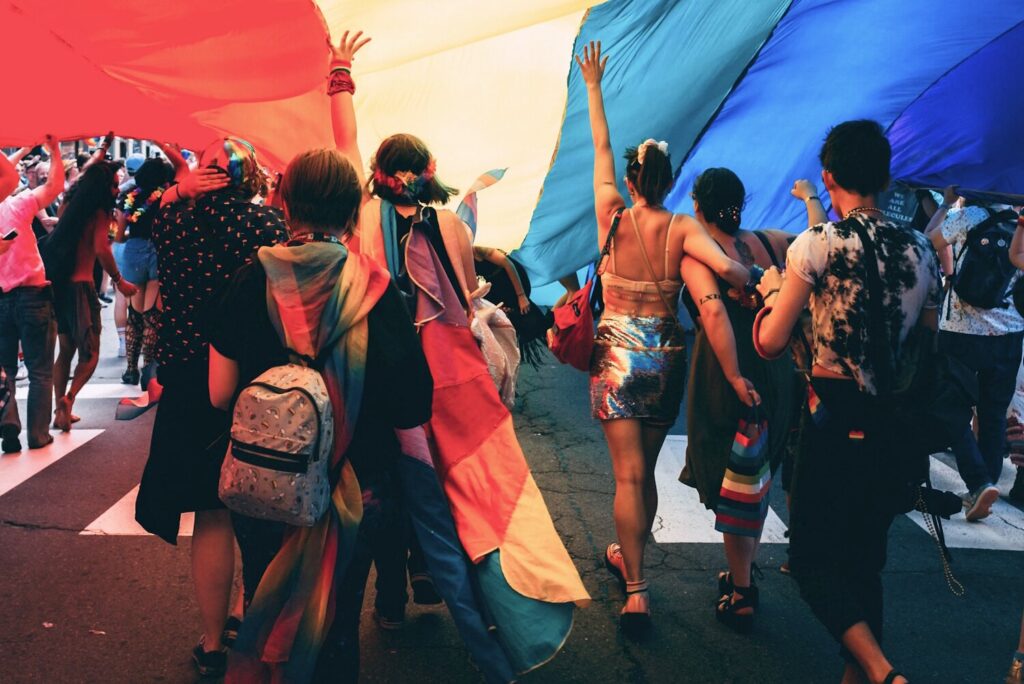
(UPDATED June 26, 2024)
Across the country, unhoused populations continue to grow. The leading causes of homelessness are economic hardship such as job loss, lack of affordable housing options, and mounting costs of living. Homelessness rates rise as rent prices increase: half of renters across the nation now spend at least 30% of their income on rent, while a quarter spend at least 50%. But even with economic conditions as a common factor, homelessness doesn’t affect all communities equally.
Some groups of people experience higher rates of housing instability. In particular, people who are LGBTQ+ are overrepresented among the unhoused population. Social stigma, discrimination, and family rejection put them at greater risk. According to a 2020 survey by UCLA's Williams Institute, 17% of lesbian, gay, and bisexual adults and 30% of transgender adults have experienced homelessness at some point in their lives, compared to 6% of the U.S. population. The Williams Institute is a research center on sexual orientation and gender identity law and public policy. Their research also shows:
- Nearly 30% of transgender respondents to the U.S. Transgender Survey who experienced homelessness reported being denied shelter due to their transgender status or gender expression. Approximately 44% reported mistreatment at a shelter, including harassment, assault, or requirements to dress or present as the wrong gender.
- 22% of LGBT adults live in poverty in the U.S. compared to 16% of non-LGBT people.
- 8% of transgender adults report experiencing homelessness in the past year, compared to 3% of non-transgender lesbian, gay, and bisexual people and 1% of cisgender, heterosexual adults.
New data also shows that nearly half (48.1%) of LGBTQ+ adults say they are financially unwell, compared to just over a quarter (25.7%) of the general public, and 30% of those who identify as LGBTQ+ reported experiencing discrimination while accessing financial services. These challenges put the LGBTQ+ community at a uniquely heightened risk of experiencing housing instability and homelessness.
LGBTQ+ youth and homelessness
In addition to LGBTQ+ adults, youth are also disproportionately affected. According to a 2022 report from the Trevor Project, 28% of LGBTQ+ youth reported experiencing homelessness or housing instability at some point in their lives—and those who did had two to four times the odds of reporting mental health challenges compared to those with stable housing. Additionally, research shows LGBTQ+ youth make up 22% of homeless youth. This means LGBTQ+ youth are 120% more likely to experience homelessness compared to non-LGBTQ+ youth.
A survey of 350 service providers across the country revealed the top four contributing factors for LGBTQ+ youth homelessness:
- Family rejection resulting from sexual orientation or gender identity
- Physical, emotional, or sexual abuse
- Aging out of the foster care system
- Financial and emotional neglect
In addition to homelessness, LGBTQ+ people are also at increased risk of experiencing poverty.
Because of stigma and discrimination, LGBTQ+ people are at greater risk of housing instability. In 2021, the Department of Housing and Urban Development (HUD) announced the Fair Housing Act would also protect individuals from sexual orientation and gender identity discrimination. It’s a step in the right direction to expand federal protections for a vulnerable group. According to experts, improving school safety, workplace protections, and expanded housing options will benefit the LGBTQ+ community.
In Portland, Oregon, Queer Affinity Village is a welcoming atmosphere for LGBTQ+ self-identified neighbors. The village has 35 Pallet shelters, a dignified, private space with a locking door, bed, climate control, electrical outlets to power personal devices, and more. Residents have access to hygiene facilities, meals, and various social services delivered by an on-site service provider. Residents are working towards moving into permanent housing.
Homelessness is a complex issue without a one size fits all solution. Because of the unique obstacles LGBTQ+ youth and adults face, it’s imperative agencies and organizations tailor services to meet their needs.
Debunking Myths: Homelessness is a choice

Investment in human potential is a core component of our mission. People who live in Pallet shelter villages are a part of a community where they have access to a resource net of social services, which enables them to transition to permanent housing. We've created a purpose-driven environment where employees are supported and learning is encouraged.
As part of our commitment to creating sustainable jobs, we're proud to announce Living Wage for US (For US) certified Pallet as a Living Wage Employer. The nonprofit organization granted the status after analyzing Pallet's cash wages and benefits paid to employees. They specifically examined the lowest potential cash wages guaranteed to workers. Third-party validation is another step for us to show business can be a force for good.
A living wage is the minimum income necessary to afford a sufficient standard of living. When someone earns a living wage, they can cover basic necessities such as food, housing, and child services. Meeting this standard is one step toward reducing housing and food insecurity. According to For US, more than half of American workers don't earn enough to support themselves and their families at a basic level of decency from a human rights lens.
According to For US, these are the some of the benefits of paying a living wage:
- A household can afford heat without sacrifice
- Food insecurity decreases
- Fewer workers receive public assistance
- Workers can save for unexpected events
Methodology
When calculating whether a company can be certified as a living wage employer, For US analyzes the following county-based cost categories:
- Geography
- Family size
- Workers per family
- Food costs
- Housing costs
- Childcare costs
- Transportation costs
- Healthcare costs
- Miscellaneous (ratio of other expenses to food and housing)
- Resiliency (buffer for unexpected circumstances)
- Payroll taxes
The base wage at Pallet is $20.39. With benefits, the pay is calculated as $21.28. Washington state's minimum wage is $14.49. The living wage for Snohomish County is $21.02. We must submit pay and benefits information yearly and maintain compensation levels to keep the certification. Pallet employees receive annual reviews, and there are opportunities to receive merit increases throughout the year.
Why paying a living wage matters at Pallet
More than 80% of Pallet employees are formerly homeless, in recovery, or previously involved in the justice system. It's essential we pay everyone a livable wage and don't inflict further harm on a vulnerable group of people. Paying a livable wage positively impacts the employees and the greater community. In addition to a livable wage and benefits, Pallet employees also have access to life skills training and personal support services.
For US has also certified Olympia, Washington-based Olympia Coffee Roasting Co., Well-Paid Maids home cleaning company, and the Center for Progressive Reform.
Pallet achieves new status: Public Benefit Corporation
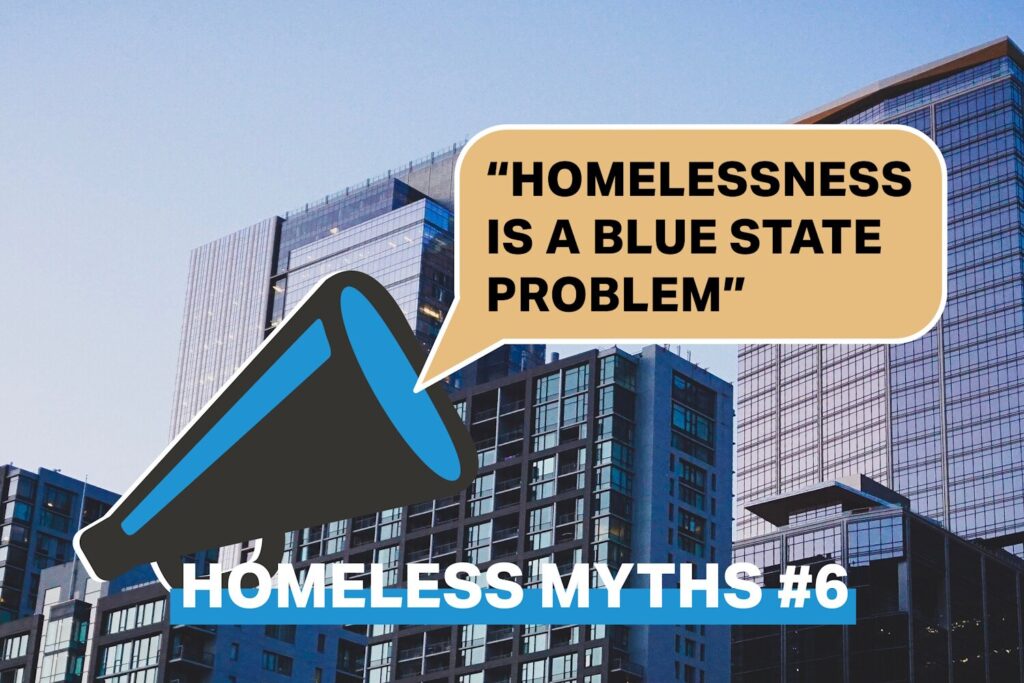
Across the country, more than 500,000 of our neighbors don't have a stable place to sleep at night. People experiencing homelessness are more than the negative images they've been reduced to. They are parents, children, and beloved family members going through challenging times. The leading cause of homelessness is economic hardship.
It’s a myth homelessness is primarily a problem in blue states — areas with an abundance of services available to people who won't help themselves. This falsehood is related to the belief homeless people in a particular area aren't local. In reality, homelessness touches every part of the United States, from urban to rural areas, from the coast to the mountains, from blue states to red states. Unhoused people may not be visible, but they are in your community.
California, Oregon, New York, and the cities within them receive significant attention regarding reporting on the homelessness crisis. But these blue states aren't the only places with many residents experiencing homelessness. Here's a list of the top 15 states with the highest number of unhoused people:
- California: 161,548
- New York: 91,271
- Florida: 27,487
- Texas: 27,229
- Washington: 22,923
- Massachusetts: 17,975
- Oregon: 14,655
- Pennsylvania: 13,375
- Arizona: 10,979
- Ohio: 10,655
- Illinois: 10,431
- Georgia: 10,234
- Colorado: 9,846
- New Jersey: 9,662
- North Carolina: 9,280
Source: US Interagency Council on Homelessness 2020 report. Also, the Department of Housing and Urban Development (HUD) breaks down the number of people experiencing homelessness per 10,000 people in the appendix of their annual report.
As shown above, a mixture of liberal and conservative states made this list. There are left-leaning and right-leaning cities and counties within each state whose policy approaches vary. Services are available everywhere because of federal government programs. There are also people in every community working to address the crisis.
Whether it's 50 people or 5,000 people experiencing homelessness in your community, they all need help. Once someone no longer has a permanent address, they face numerous barriers to getting back on track. Being homeless is complex and demanding. Day-to-day survival is the singular focus, and there isn't much time or mental space to figure out how to thrive.
Pallet employee Sarah was unhoused before joining our team. "There were times I had to get food out of the garbage because I was hungry," she shared about her experience of living outside. "The winters and the rain were definitely the hardest, of course, because you're so cold and you're so wet. And then to be able to find dry clothes from whatever garbage can or from wherever you can find them."
Pallet shelter villages provide residents with dignified shelter and access to basic needs and services. This allows residents to rebuild their lives and move onto permanent housing.
Our unhoused neighbors are better served when we embrace compassion and reject falsehoods about who they are.
This post is part of an ongoing series debunking homelessness myths.
Part One: They are not local
Part Two: Homelessness is a personal failure
Part Three: Homelessness is a choice
Part Four: Homeless people are lazy
Part Five: Homelessness can't be solved
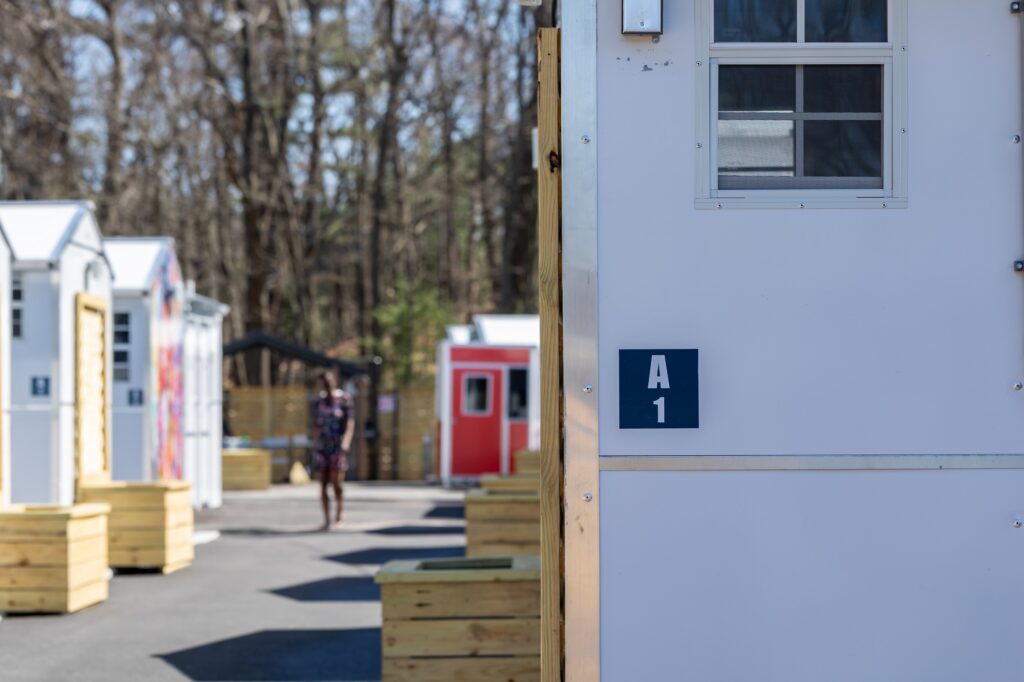
Pallet shelter villages are dignified places for unhoused people to get themselves back on track. Each shelter has a locking door, bed, shelving, climate control, electrical outlets to power personal devices, and more. Residents have access to hygiene facilities, meals, and various social services delivered by an on-site service provider. These features are essential as people transitioning from living unsheltered are leaving challenging circumstances where daily survival — food and shelter — is the number one focus.
Sarah experienced homelessness before joining the Pallet team. She described winters and rain as the hardest.
"In the rain your whole tent gets soaked on the sides and on the bottom, and then you're left with puddles in there. And then getting kicked out of one camp because of the city," she explained. "You're so cold, and you're so wet. And then to be able to find dry clothes from whatever garbage can or from wherever you can find them."
With a singular focus on physical needs, there's little time and opportunity to focus on one's mental health while homeless. Traditional advice for how to tend to one's mental wellness includes: eating well, getting enough sleep, regular exercise, tracking gratitude with a journal, preparing lunches for the workweek, and seeking professional help. These tips have one thing in common: they can only be effectively carried out when housed.
Pallet shelter villages not only meet the physical needs of residents they also give them a chance to improve their mental health. The shift begins almost immediately, partly because they can get a full night of sleep. Rest is crucial because chronic sleep deprivation adversely affects health and quality of life. Residents don't have to worry about being woken up and told to move, or be concerned about safety since they can lock the shelter door.
"Their faces are one of the changes. From their countenance, going from a place of hopelessness to a place of life, a sense of belonging," shared Wanda Williams, Deputy Director of Residential Services at Urban Alchemy, the service provider at Westlake Village.
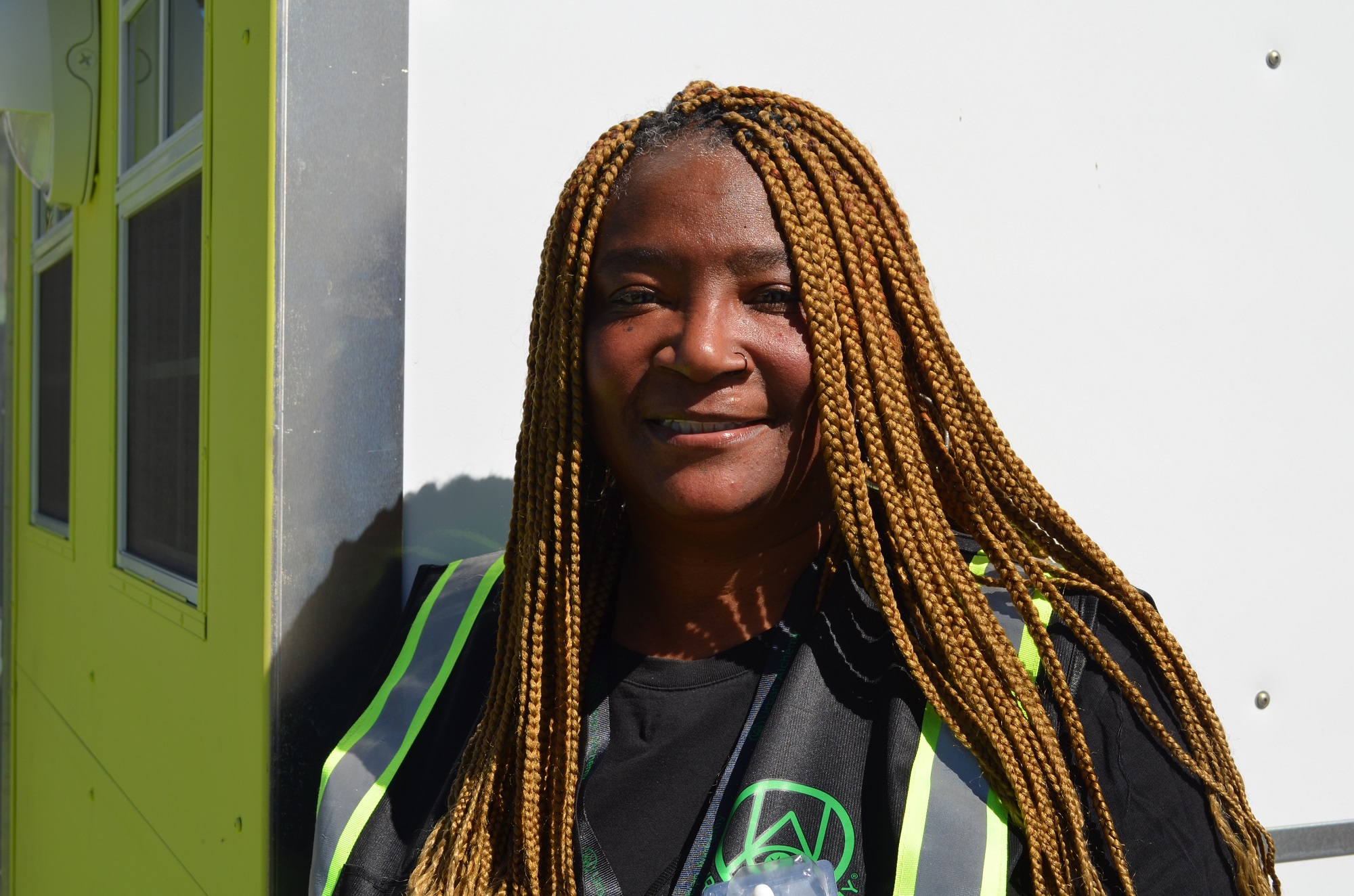
"Their faces are one of the changes. From their countenance, going from a place of hopelessness to a place of life, a sense of belonging."
– Wanda Williams, Urban Alchemy
"Even within a week, you'll see that they are sleeping better. You'll see that they're taking care of themselves and showering and things like that," Jamie Carmona told the Los Angeles Times in a feature on Chandler VIllage after it opened. "So even though they're not getting their [permanent] housing right away, you can see that it is helping them in many other ways."
Austin Foote is the manager of a Pallet shelter village in Aurora, CO. He's also worked in a congregate shelter. He described a significant difference in residents' well-being.
"In the congregate shelter, I would just see residents with just bloodshot eyes from just constant restlessness and just the inability to find any quiet or comfort," he explained. "There was no space to get away, to ever separate yourself and call something your own. It was constantly like a defense, defending your space."
Austin said because residents have their personal space, they can take time away from others when they need to. Their cabin is a place of solace to recharge.
"There's so much more follow-up because they've got that space to be able to go to. The dignifying aspect of it is a huge part of it. Safety is a huge part of it," Austin added. "We do our best to try to keep quiet hours, and we have staff do rounds to make sure that everyone's okay."
If a resident needs professional mental health assistance, services are available. While it varies from village to village, service providers have partnered with behavioral health providers who visit the site, or residents are provided transportation to an appointment. Because residents are at the same place every night, it's easier to connect them with the help they need.
Caring for one's mental health is a privilege housed people take for granted. Pallet's innovative model gives our unhoused neighbors the same opportunity.
Debunking Myths: Homelessness is a choice

Dignified personal space with a locking door, community, and access to services are critical components of Pallet shelter villages. For the last six months, unhoused people in Aurora, Colorado, have begun recovering from the trauma of living unsheltered. They're now healing in a village run by the Salvation Army Aurora Corps. The Safe Outdoor Space (SOS) has 30 Pallet shelters.
SOS manager Austin Foote described how new residents react when they move in, "There's kind of like this wonderment. ‘Is this real? Wait a minute. This is my space? I can come in, and I have food every day, and there's showers here?’" Austin is happy to confirm the village is, in fact, a safe and stable place where they can start the transition to permanent housing.
Austin considers himself an empathetic person and has a strong desire to help others. He thrives in his role at SOS, which allows him to build relationships with others and be of service. Before managing the site, he worked at a congregate shelter. He's seen firsthand the difference when people have a private space.
"Giving someone a safe place to stay and where they want to stay has increased our ability to do services. And to make changes in these people's lives on an immense level," he shared. "Our retention rates are way higher because it's comfortable. There's heating, there's cooling, they can design their place. They can lay it out the way they want. They can lock their door."
Along with Austin, there are two case managers at the site. He says because residents are staying in a set place — rather than moving around, which creates contact challenges — they can make individualized plans. In addition to having their basic needs met, staff assists residents with an array of social services, including securing documentation such as a birth certificate, housing navigation, and job assistance.
Those services offered by the Salvation Army have helped SOS resident Thomas regain stability. He told The Sentinel he's been able to get his driver's license and Social Security card. Now that he has an address, he also found employment. Thomas is grateful for the opportunity.
The village is a mini neighborhood, with residents hanging out with one another and playing board games with staff. When one person reaches a milestone like getting a job, it positively affects others. Austin says because they're able to see their neighbors' success for themselves, it encourages them to keep working towards their goals.
When SOS opened in July 2021, people initially stayed in tents. The following November, Pallet shelters replaced the tents. Here's a brief overview of the impact of the site from its opening through March 2022.
- 101 people sheltered
- 54% of residents obtained employment or employment services
- 11 people moved into permanent housing
- 7 family reunifications
- 72% of residents obtained benefits such as Colorado's Old Age Pension (OAP) program, Social Security Disability Insurance (SSDI), and Supplemental Security Income (SSI)
- 91% of residents have obtained vital documentation such as an ID, Social Security card, or birth certificate
Because of the success of the first site, local officials opened a second Pallet shelter village last month, which the Salvation Army runs. Austin says other cities have reached out to them to learn how they're helping the unhoused community.
"I think the Salvation Army is changing the way in which homelessness is being looked at here in Denver," Austin shared. "I feel very blessed and proud to be part of a group of individuals in leadership that is really focused on trying to make direct assistance and change, as opposed to just kind of bandaging things."
What happens in a Pallet shelter village
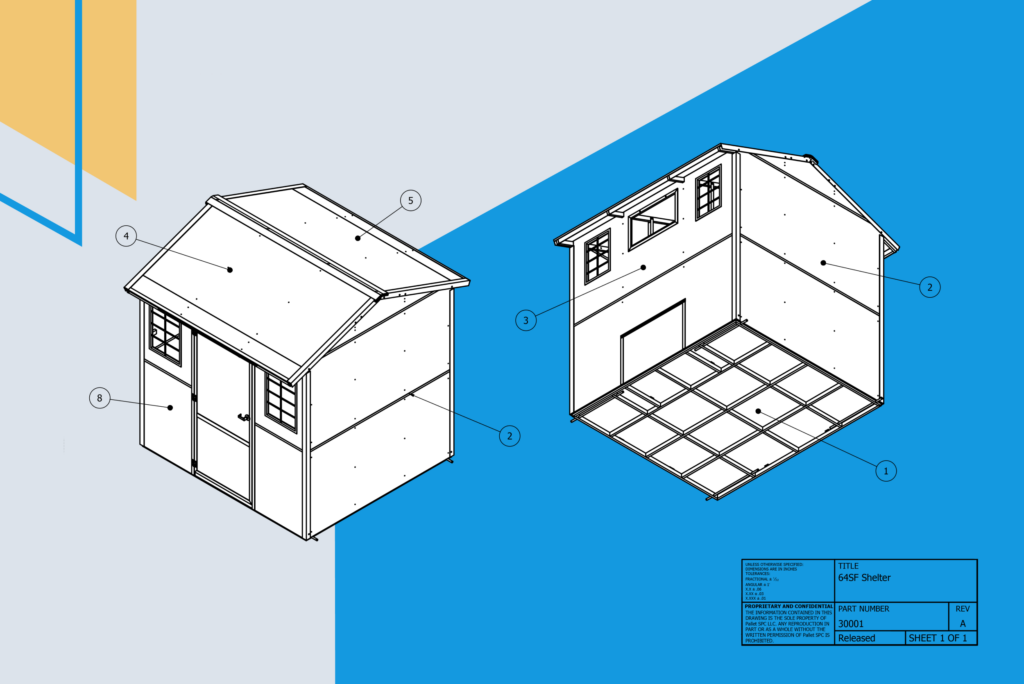
Pallet manufactures rapidly deployable shelters for displaced populations. There are more than 70 Pallet shelter villages across the country for people experiencing unsheltered homelessness. Residents have a safe, private, and personal space with a locking door, plus meals, showers, and laundry. An on-site service provider also delivers an essential resource net of social services. This month marks six years since we started this journey to address a growing crisis.
Initially, the idea was spurred by Hurricane Katrina. Pallet co-founder and CEO Amy King and co-founder Brady King watched the devastation from the storm in shock. After seeing images of thousands of people in the Superdome — a football stadium turned emergency shelter — they thought the hurricane victims needed better options. Later, Brady brought up the idea again with disaster in mind. This time with more details.
"It was very specific. It needs to be lightweight, so you can airdrop it by military helicopter. It needs to be panelized, so it's easy to set up. It's got the foundation built-in, so you don't have to pour a foundation or excavate the site," Amy recalled. "I said, 'That's actually a really good idea. What you're talking about makes a lot of sense. We should build it.'"
Many of those initial elements are still present in the current design.
At this point, Amy and Brady had moved back to Seattle and started Square Peg Construction. They often talked about how expensive it is to build housing, how long it takes, and the growing number of unhoused people. Amy wondered if Brady's shelter idea would be helpful. After all, homelessness is a disaster, albeit a personal one not caused by Mother Nature.
They discussed the idea with employees of their construction company, many of whom had been homeless. The team thought it was a great idea, and identified its potential to help people who are living unsheltered. Their hard-earned insight helped us see the value in creating an alternative to the options unhoused people have to choose from.
Next, the two reached out to Zane Geel, Pallet's recently retired Director of Engineering. Zane took some time to figure out how to make it a reality. Rather than wood, the shelter panels would be made up of alternative construction materials. Pallet was born with an initial investment of $40,000 of personal funds. Zane built the prototype in his backyard. After design adjustments and hiring staff, the first Pallet shelter was ready. The team took it to an emergency response trade show in Tacoma, Washington, a city about 60 miles south of our headquarters.
"We were a little nervous about entering the marketplace with our product in homelessness. We thought disaster would be a better entry point," Amy explained.
They met Tacoma officials who were interested in the product because the city had just declared a homeless state of emergency. A few days later, they hosted an additional demonstration with city leaders. A week later, Tacoma placed an order for 40 Pallet shelters. They were ready to take an alternative approach to address unsheltered homelessness.
After receiving the call, Amy delivered the news to the team, "I walked in, and I saw Zane, and I just immediately started bawling. And I was like, 'We got it! We got our first sale. We sold 40 shelters to Tacoma.' And then he started to cry. And then everyone else in the room started to cry. And I was like, 'Oh, my God, we're going to do this thing.' It was so exciting."

Since setting up the village in Tacoma, Pallet has grown exponentially. We started with a handful of employees and there’s now more than 100. We've also improved the manufacturing production process. In the beginning, we produced three shelters each week; now, it's 50. There are Pallet shelter villages in 11 states, from Oregon to Arkansas. We've also partnered with mission-aligned investors who helped us scale and grow to meet the needs of the crisis. As a social purpose company, we use profitability to expand our impact. Amy is filled with gratitude.
Pallet began with the intention to help some of the most vulnerable members of our community, and that continues today. Our villages are not only bringing people inside, they are helping people regain stability to take the next step. We're also building a nontraditional workforce. More than 80 percent of Pallet's team members have experienced homelessness, substance use disorder, and/or the criminal justice system. We believe people's potential — not the past — defines their future. As we look forward to the coming months and years, we hope to expand our model.
"I would really like to see us further expand our workforce development model to encourage more companies to do what we're doing in terms of job offerings, with support for staff," Amy shared. “I never thought it would grow this fast, ever. I never imagined that this would be the reality, but I'm thrilled."
What’s in a name? How we chose Pallet

When Sarah sets her sights on a goal, she'll inevitably be successful. Being resourceful and determined has served her well. Sarah joined Pallet as a Manufacturing Specialist at the beginning of the year. Joining the team was a full-circle moment. She vividly remembers seeing our shelters in downtown Portland a couple of years ago. In a short time, Sarah has made an impact. Working in the factory was a bit of an adjustment at first, particularly standing on her feet for long hours. Still, she got used to it and quickly excelled at the various steps of building Pallet shelters.
"They were bouncing me around to all the stations, and the supervisors kept saying, 'normally people need to stay at a station for a certain amount of time before we move on, but you're learning really quickly,'" she shared. "It helped give me that motivation and confidence."
Within a few months, Sarah was promoted to Customer Service Coordinator, a new position on the Community Development team. She's the point person for customer concerns and coordinates assistance for prompt resolution. Sarah first heard about the job opening at a company-wide meeting. Pallet's Human Resources Director encouraged her to apply.
"I guess the fear of rejection played a major part of why I was hesitant," Sarah explained. She pushed through any doubts and decided the worst that could happen was she wouldn't get the job. But an upside would be others would know she's interested in a promotion. Since moving into the position, she's leveraged her connections already built with other teams to streamline the customer support process.
More than 80 percent of Pallet's team members have experienced homelessness, substance use disorder, and/or the criminal justice system. We believe people's potential — not the past — defines a person's future. Sarah and others have found stability through purposeful employment at Pallet.
Sarah earned a cosmetology license, certificates in early childhood education, and a degree in small business management entrepreneurship from a local college. She achieved these milestones after becoming a mother in her late teens.
"I worked also as a Montessori teacher, and I worked for Everett Public Schools, and I was a paraeducator. Then I taught middle school math," Sarah shared. She and her former partner also opened an afterschool education company where they served about 150 families. "We tutored low-income families through the no Child Left Behind Act. It was a neat experience, fun, and most of all rewarding. To know that I was part of a village in that child’s life will be everlasting on my heart.”
Sarah's warm smile and welcoming personality made it easy for her to connect with kids. She was doing well, but things took a turn after pain from an old injury came back. She went from taking medicine as prescribed to becoming addicted. She continued working and maintained a "normal" outward appearance. When she began using other substances, her life unraveled rapidly. She lived on the streets in her hometown of Everett, Washington, then later in Portland, Oregon.
"The winters and the rain were definitely the hardest, of course, because you're so cold and you're so wet. And then to be able to find dry clothes from whatever garbage can or from wherever you can find them," Sarah explained. "I've had to escape from fires from inside the tent because we'd fall asleep, and the candle would get too hot through the glass because it would be burnt out. Then that would heat whatever to catch on fire."
Sarah essentially disappeared for about two years while in Portland, but her mother tracked her down. When they reunited, Sarah reconnected with her family and three children. Shortly after returning to Washington, she entered treatment in January 2021. After treatment, she moved into a recovery house. She began an internship at Kindred Kitchen, a social enterprise creating stable futures by offering hands-on job training to formerly homeless and low-income individuals who need a fresh start. Sarah described the café as a supportive environment.
"I learned a lot. Even the most simple thing, like how to dice up an onion without the whole thing just falling apart everywhere," she shared. "It was a good transition from going crazy to not doing anything to then that to then this [Pallet]. It helped me really transition to the work mentality."
At the end of the internship, Sarah joined Pallet and now lives in her own place. A vital part of the culture at Pallet is embracing everyone no matter what path they've taken before arriving at the company. Sarah said she feels accepted and valued. It isn't necessary to hide her personal experiences. She’s thankful for the opportunity to rebuild her life and help others who are facing the same challenges she once did. Sarah is sharing her story to show that change is possible. She cautions others not to criticize our neighbors who are living unsheltered.
"You don't know everybody's path or journey, and you don't know how they got there. So try not to judge them and try to be part of the solution rather than just be somebody who looks down on them," she added. "There is hope for people to change. And people will change with the willingness and the support from the community and from others. They can do it, so just have faith that it can happen."
Debunking Myths: Homeless people are lazy

As part of our commitment to provide dignified space for people experiencing homelessness, we are continually improving our shelters. Conducting tests is one way to ensure Pallet shelter village residents are comfortable inside their cabins and safe from the elements. Recently two members of Pallet's engineering team — Jordan, Design Engineer, and Jessie, CAD Designer — oversaw an independent assessment of our heaters and the 64 sq. ft. and 100 sq. ft. shelters. Specifically, we wanted an additional analysis of thermal efficiency in cold weather and the power consumption of the heaters.
After researching testing facilities, Jessie found SGS, a world leader in product testing, inspection, and certification. Their facility includes state-of-the-art testing cells, on-site engineering personnel, and technical support staff. In addition to specific testing capabilities, we also needed certain physical requirements.
"We were looking for a chamber that would be big enough to hold four to five fully assembled shelters," Jessie shared.

Testing took place over four days at the SGS facility in Colorado. The shelters were placed inside a chamber that could reach -10 degrees Fahrenheit. It only took about 15 - 20 minutes to make temperature adjustments which allowed us to test a wide range of climates. The equipment SGS used included thermocouples that measured the temperature inside the shelters. A Hioki machine analyzed the power usage of the heaters.
"If we get a sense of how much a 4500-watt heater consumes in an hour at a certain temperature and we know how often a location is within that temperature range, we could say this is how many kilowatt-hours you'll consume in this amount of time," Jordan explained. "If we know how much power it's using in an hour, we can turn that into a dollar amount based on the cost of electricity."
These reliable test results enable us to paint a fuller picture of the electricity costs associated with a Pallet shelter village. We also evaluated the effectiveness of weather stripping and insulation of the sleeping cabins. Jessie and Jordan watched the data collection on monitors in real-time.
Overall, the testing was successful. The staff were meticulous in their approach and were helpful.
"Their techs, the senior research engineer, working with us, were super helpful, super accommodating with everything, even giving us that extra day when our truck was delayed," Jessie said.
Now that testing is complete, Pallet's engineering team is assessing the results to locate areas for design improvements and cost reductions.
"It will inform us quite a bit and give us an excellent baseline to investigate further design and improve our cold weather units," Jordan added.
What happens in a Pallet shelter village
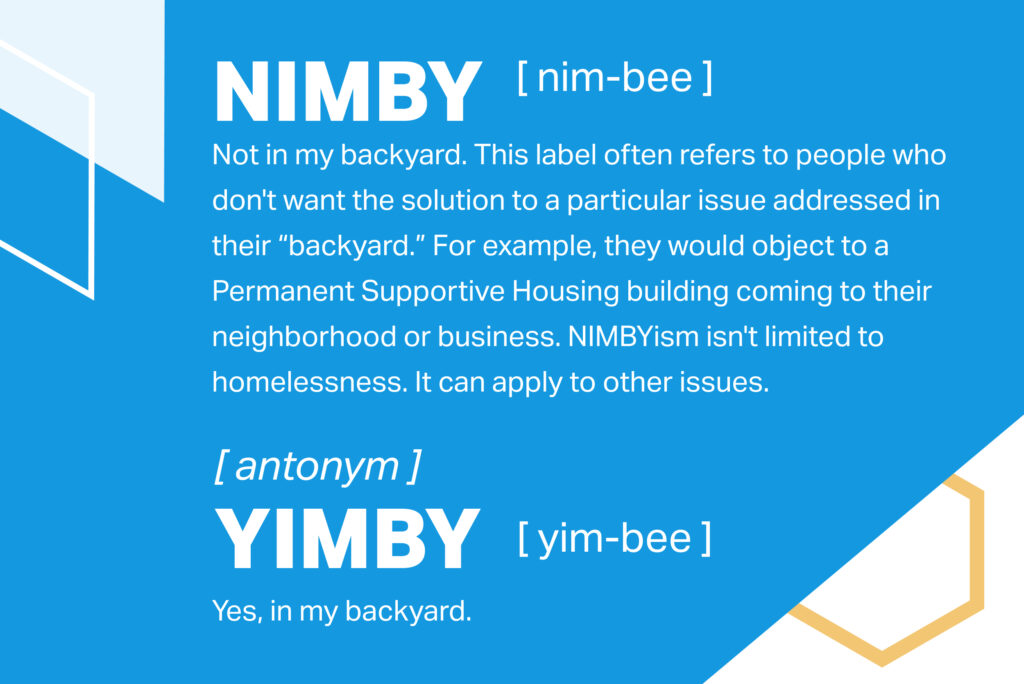
Organizations, experts, and advocates within the homelessness field use specific words and phrases that aren't always common knowledge. To help bridge the information gap, below is a list of terms that will help you better understand issues related to homelessness. Terms defined include the types of homelessness, shelter and housing classifications, and tools used to address the crisis.
1. Unsheltered & Sheltered homelessness
Unsheltered homelessness refers to people sleeping outdoors in places not designed as a regular sleeping location, such as the street, a park, under an overpass, tent encampments, abandoned buildings, or vehicles. Sheltered homelessness includes people staying in emergency shelters, transitional housing programs, or safe-havens.
2. Congregate shelter
A congregate shelter is a shared living environment combining housing and services such as case management and employment services. Often in congregate shelters, people sleep in an open area with others. They are typically separated by gender and have set hours of operation.
3. Emergency shelter
A facility with the primary purpose of providing temporary shelter for homeless people. For example, cold and hot weather shelters that open during extreme temperatures are considered emergency shelters.
4. Imminent risk of homelessness
It applies to individuals and families on the brink of being unhoused. They have an annual income below 30 percent of the median income for the area. They don't have sufficient resources or support networks needed to obtain other permanent housing.
5. Chronic homelessness
People experiencing chronic homelessness are entrenched in the shelter system, which acts as long-term housing for this population rather than an emergency option. They are likely to be older, underemployed, and often have a disability.
6. Transitional homelessness
Transitional homelessness is when people enter the shelter system for only one stay – usually for a short time. They are likely to be younger and have become homeless because of a catastrophic event, such as job loss, divorce, or domestic abuse.
7. Episodic homelessness
Episodic homelessness refers to people who experience regular bouts of being unhoused. Unlike transitional homelessness, they are chronically unemployed and may experience medical, mental health, and substance use issues.
8. Hidden homelessness
Hidden homelessness refers to people who aren't part of official counts. They might be couch surfing at a friend's or a relative's house.
9. Transitional housing
Transitional housing provides people experiencing homelessness a place to stay combined with supportive services for up to 24 months. Pallet shelter villages are considered transitional housing. Residents, on average, stay three to six months before moving on to the next step, which includes permanent housing or reuniting with family.
10. Permanent Supportive Housing
This housing model provides housing assistance and supportive services on a long-term basis to people who formerly experienced homelessness. PSH is funded by the Department of Housing and Urban Development's (HUD) Continuum of Care program and requires that the client have a disability for eligibility.
11. Continuum of Care
The Continuum of Care (CoC) program promotes community-wide commitment to the goal of ending homelessness. The program provides funding for efforts by nonprofit providers and state and local governments to quickly rehouse homeless individuals and families. At the same time, minimizing the trauma and dislocation caused to homeless individuals, families, and communities by homelessness. For example, CoC program funds can be used for Rapid Rehousing, short-term rental assistance, and services to help individuals and families quickly exit homelessness
12. HMIS
The Homeless Management Information System (HMIS) collects and reports data on the characteristics of people experiencing homelessness and their service use patterns.
13. NIMBY & YIMBY
NIMBY = Not in my backyard. This label often refers to people who don't want the solution to a particular issue addressed in their "backyard." For example, they would object to a Permanent Supportive Housing building coming to their neighborhood or business. NIMBYism isn't limited to homelessness. It can apply to other issues. Conversely, YIMBY= Yes, in my backyard.
14. Criminalizing homelessness
Refers to policies, laws, and local ordinances that make it illegal, difficult, or impossible for unsheltered people to engage in the everyday activities that most people carry out daily. "No sit, no lie" laws, which prevent people from sitting or lying down in public, are considered criminalization of homelessness. Other examples include prohibiting camping in public, sleeping in parks, panhandling, and sweeping tent encampments (removing the personal belongings of people experiencing homelessness).
15. Point-in-Time count
This count is a one-night estimate of both sheltered and unsheltered homeless people nationwide. Local groups conduct one-night counts during the last week in January of each year. Because of the 2020 pandemic, some point-in-time counts have been suspended or occurred later in the year.
Hostile architecture and its impact on unhoused people
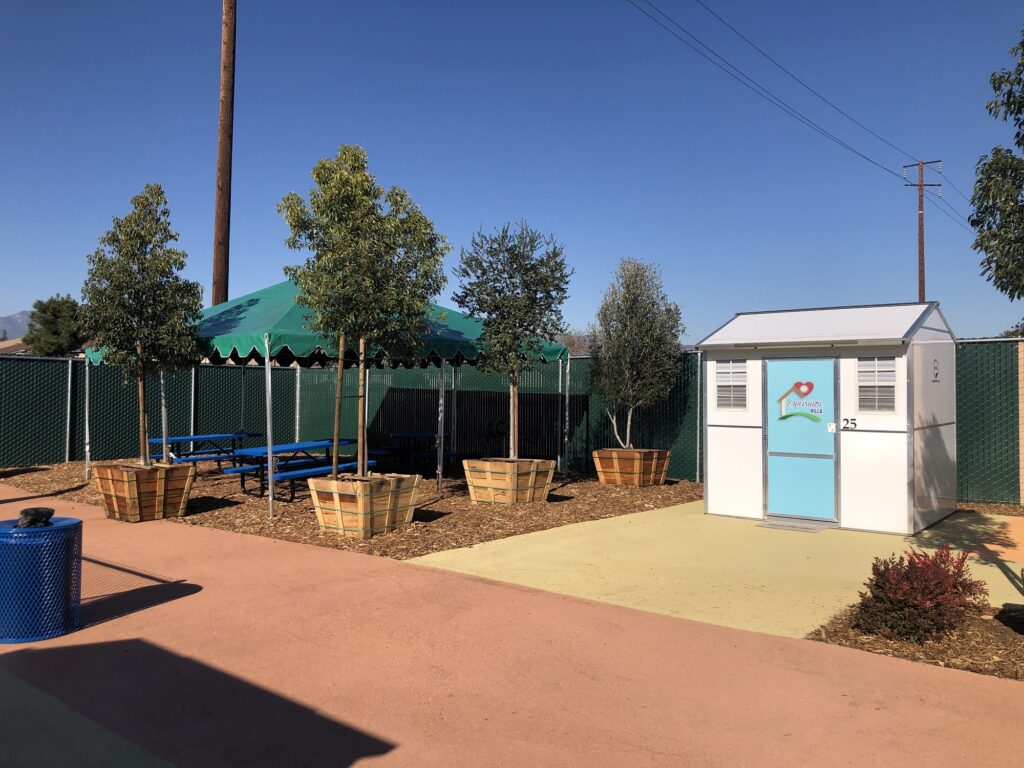
Pallet envisions a world where no one goes unsheltered. Our villages provide people experiencing homelessness the dignity of personal space in a healing community environment. Because we're a Social Purpose Company (SPC), we can respond to this emergency with solutions built fast, at scale. SPC is the Washington state equivalent to a B corporation. We use profitability to expand our impact. Pallet's social purpose is to unlock possibilities by building shelter communities and employing a nontraditional workforce.
Why SPC vs. Nonprofit
We recognized the scale needed to be successful in ending unsheltered homelessness required a market-based solution. So we brought on investment partners to front-load the resources necessary to rapidly meet the needs of the ever-growing homelessness crisis across the country. Doing so allowed us to buy materials, secure a factory, hire staff, and more. Today we have more than 60 villages across 11 states with more than 100 employees. The investors on this journey understand Pallet is a social enterprise with the mission being the driving force, not substantial returns on profits.
“As a social purpose corporation, profit is not our first priority,” said Amy King, CEO of Pallet. “We exist because communities cannot quickly build enough affordable, permanent housing to meet the needs of their residents. This investment will ultimately help those cities and towns address the unsheltered homelessness crisis.”
Recently Pallet received $15 million in funding to help us expand the number of communities that want to address homelessness. The round was led by the impact investment firms DBL Partners and Citi via the Citi Impact Fund, with participation from six total firms.
Investment isn't solely monetary. Autodesk donated a suite of programs, including AutoCAD, Revit, Inventor, and more, to Pallet through the Technology Impact Program. Our engineering department uses the software. Jennifer, who used to be a Manufacturing Specialist and is now Safety and Human Resources Specialist, is excited about new tools funded by the investment.
"I was excited to hear about the new Rivet guns," Jennifer shared. "We could get our job done quicker. We're able to hire more people to help build this company."
Building a Workforce
More than 80 percent of Pallet employees have experienced homelessness, incarceration, or substance use disorder. Gaps in employment and other barriers can prevent people from these backgrounds from securing a job.
Nearly one in three Americans have a criminal record, and even a misdemeanor or arrest can create a lifetime of barriers to employment. A Prison Policy Initiative analysis showed "the unemployment rate for formerly incarcerated people is nearly five times higher than the unemployment rate for the general United States population." Another analysis showed "formerly incarcerated individuals tend to experience joblessness and poverty that started long before they were ever locked up." Stable employment through a living wage job can help break this cycle.
As a second chance friendly employer, we believe potential — not the past — defines people's futures. People who have had to live outside, navigate the prison system, or are in recovery are intelligent, resilient and have excellent survival tactics. Those skills can be used in a business setting. (*We now describe our hiring practices as fair chance employment. Learn why we changed our language here.)
Pallet is committed to creating opportunity for others who have been overlooked. Having a dignified place to live and access to social services improves one's chances to transition to the next step. Second chance employment, or in some cases a first chance because of circumstances, creates a pathway to a different future. Lifting people up is the definition of our company name and reflects our values.
"The more you help the people at the bottom, the more you're helping everybody," said Amy. "Because everybody is responsible for that person at the bottom."

Nationwide, more than half a million people are experiencing homelessness. While visible or unsheltered homelessness is growing, people without a stable place to stay at night are also couch surfing, living in their vehicles, hotels, and shelters.
One pervasive myth about our unhoused neighbors is they're lazy. This stereotype fails to consider the daily challenges of homelessness and the effort it takes to survive. The laziness falsehood is reinforced through decades of negative imagery in entertainment, rhetoric from some politicians, and judgment of visibly poor people. This myth is similar to the incorrect belief that people choose to be homeless. Unhoused people aren’t lazy. Some have jobs, but they don’t earn enough to afford a place to live.
Here's a look at available statistics:
It's estimated anywhere from 25% to 60% of people experiencing homelessness across the country are employed. There's a range because it isn't a standard metric captured in all local homeless counts or at the federal level.
Details from a 2017 Axios article:
"Josh Leopold, a researcher at the Urban Institute, said the percentage of homeless people who work may be close to 25%, maybe a little more. Megan Hustings, director of the National Coalition for the Homeless, suggested higher percentages — 40% to 60% of the homeless float in and out of both part- and full-time work, she said."
In the 2020 Seattle/King County Point-in-Time count, 21% of homeless people report having some employment. Specifically, 15% said they work part-time, and 6% work full-time.
The annual point-in-time count in the Metro Washington region — the District of Columbia, suburban Maryland, and Northern Virginia — showed overall 14% of adults experiencing homelessness on a single night in January 2021 were employed. The percentage varies between single adults and adults in families and by region. For the four previous years employment among homeless people was approximately 22%.
The challenges of maintaining employment while homeless include finding a place to shower, rest, and meet transportation needs. Another contributing factor to being employed but still unhoused is the rising cost of housing. A 2021 report from the National Income Housing Coalition showed: "In no state, metropolitan area, or county in the U.S. can a worker earning the federal or prevailing state, or local minimum wage afford a modest two-bedroom rental home at fair market rent by working a standard 40-hour workweek."
Even with rising housing costs and increased income inequality, the belief that homeless people should pull themselves up by invisible bootstraps persists. So what's stopping them? In short, numerous barriers:
- Gaps in employment
- Lack of permanent address, reliable phone
- Criminal record
- No identification card such as a birth certificate or driver's license
- Limited access to the internet to fill out an application
- "Clean" clothing/appearance
- Low credit score
- Disability
- Cost and access to transportation
In addition to those barriers, being homeless is complex and demanding. Day-to-day survival is the singular focus, and there isn't much time or mental space to figure out how to thrive and get back on track. Daily challenges include:
- Getting food and water
- Finding a bathroom to use
- Traveling to appointments such as meeting with a case manager
- Finding a safe place to sleep
- If you're not working, finding a public place to be that won't lead to arrest is a moving target.
People experiencing homelessness are dealing with circumstances infinitely harder to handle without a stable place to live. Here’s how a Street Sense Media article described being homeless: “You become scared, frustrated, angry, bitter, distrustful. You’re always tired, overwhelmed. Little tasks become chores as depression saps your energy. Stress clouds your judgment. You grab at anything that looks like an opportunity, yet you feel like you’re getting nowhere.”
Continuing to believe a stereotype about our vulnerable neighbors is not showing the compassion they deserve.
Pallet shelter villages are a vital part of the transition out of homelessness. Residents can focus on the next step by having a dignified shelter with a locking door and access to on-site services.
This post is part of an ongoing series debunking homelessness myths.
Part One: They are not local
Part Two: Homelessness is a personal failure
Part Three: Homelessness is a choice
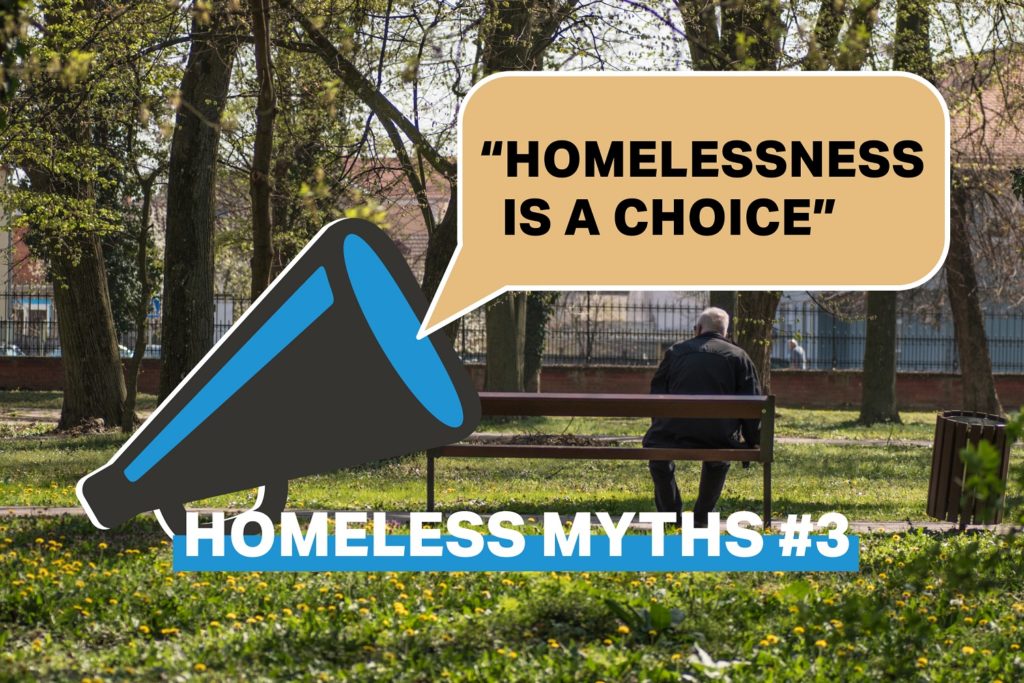
As more people living on the margins of society are increasingly visible in cities across the country, how to address the growing homelessness crisis is on everyone’s mind. Discussions on homelessness inevitably include beliefs based on longstanding stereotypes about the unhoused community. Among the most pervasive stereotypes is that homelessness is a choice. But people who have experienced homelessness repeatedly reject this notion. They want help. They want the opportunity to move back inside.
A survey in the city of Seattle's 2016 Homeless Needs Assessment report echoed what homeless folks have said about wanting to accept a place to live. Ninety-three percent of survey respondents reported they would move inside if safe, affordable housing were available. A recent survey of approximately 140 tent encampment residents in Boston showed 95 percent “would be willing to leave their tents for housing, if it were available.”
The stereotype that homelessness is a choice coincides with the pervasive belief homeless people are drifters, moving from city to city to take advantage of free government services. People experiencing homelessness aren't just the people we see sleeping outside. They could also be the cashier at the grocery store or the dad of one of your child's classmates. Homelessness isn't always visible.
Service providers and outreach workers also say homelessness isn't a choice. In video series debunking homeless myths, United Way of Orange County spoke with advocates who shared their experience with the unhoused community.
Brian Peterson, founder of Faces of Santa Ana, shared, "I've actually never met any person that has wanted to be homeless, quite the opposite. They often share stories with me of how difficult it is to be homeless. How difficult it is to not have a good night's rest. How difficult it is to be woken up every hour throughout the night telling you to move to a different place."
I've actually never met any person that has wanted to be homeless, quite the opposite. They often share stories with me of how difficult it is to be homeless. How difficult it is to not have a good night's rest.
– Brian Peterson, Founder of Faces of Santa Ana
"When building these relationships with individuals and families, they hear that this isn't the life they chose. And it's not something that if they had all the options in the world that they would choose to experience. But it was a ripple effect from whatever life situation that they endured," Chelsea Bowers, Communications Director at City Net, shared. City Net is the service of a Pallet shelter village in Riverside, CA.
The leading cause of homelessness is economic hardship. Homelessness rates rise faster in cities where residents spend more than one-third of their income on rent.
Where did this stereotype originate? Late President Ronald Reagan is credited with bringing it to the national stage. Throughout his time in office, he said homelessness is a choice. A 1988 New York Times article includes a quote Reagan gave to David Brinkley with ABC News: "They make it their own choice for staying out there…There are shelters in virtually every city, and shelters here, and those people still prefer out there on the grates or the lawn to going into one of those shelters." Reagan's economic policies — which crippled federal and social housing programs — are cited as contributing to the modern homelessness crisis cities are grappling with today.
When homeless people don't accept the traditional options presented to them, there's a false belief that they're choosing to stay homeless. Barriers to accepting assistance at congregate shelters include: pets not being allowed; partners can't stay together because genders are separated; hours of operation don't accommodate someone working a nontraditional schedule such as an overnight shift. It's why Pallet shelter villages have removed these obstacles. Pets are welcome, partners can stay together, and residents can come and go as they need to. Our villages are a safe place to stabilize while people work towards moving onto permanent housing.
Rather than assuming the worst of our unhoused neighbors, let's show compassion instead and treat them with dignity. They are individuals going through a challenging time who need support.
This post is part of an ongoing series debunking homelessness myths.
Part One: They're not local
Part Two: Homeless is a personal failure

For people with homes, public spaces are often inviting environments. A bench with an armrest in the middle could be seen as an excellent addition, as it provides separation between you and a stranger.
But for someone who wants to use that bench as a place to rest, they aren't able to. This design feature is referred to as hostile architecture. Hostile architecture limits how people experiencing homelessness use public spaces and discourages them from staying in an area for too long.
Hostile architecture isn't limited to seating with barriers. It also includes the placement of boulders, spikes, high pitch sounds, or other features to stop people from lying down or camping. In New York City, a bookstore installed sprinklers to prevent people from sleeping under its awning. In Seattle, the city installed bike racks near a highway onramp after sweeping a camp in the same area. After complaints of its placement, the city removed the racks. Anti-urine paint was used on public spaces in San Francisco. This paint splashes back liquid when it hits a surface it's applied to. (Friendly reminder: a lack of public restrooms is a significant problem across the country.) Later, San Francisco officials created a Pit Stop program which provides 24-hour access to public bathrooms throughout the city and has since reduced the incidents of public defecation.
Cities install hostile architecture because of pressure from constituents who demand that public spaces and streets are clean. But if access is limited and visible poverty is frowned upon, where can someone experiencing homelessness exist?
Hostile architecture isn't solely an issue in the United States; it's present in other countries worldwide. Here are a few examples.

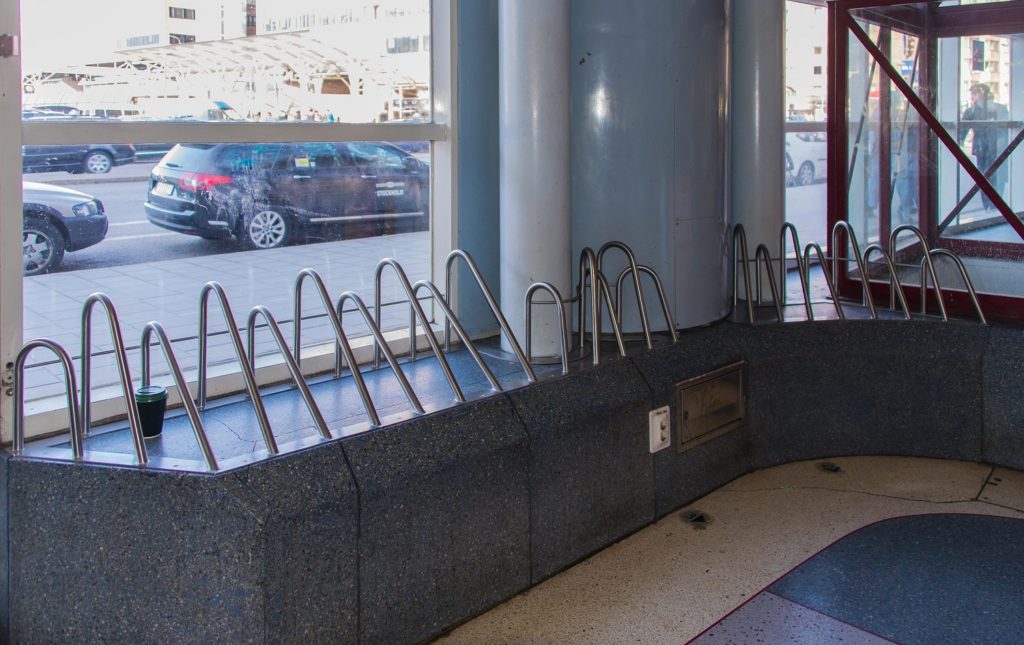
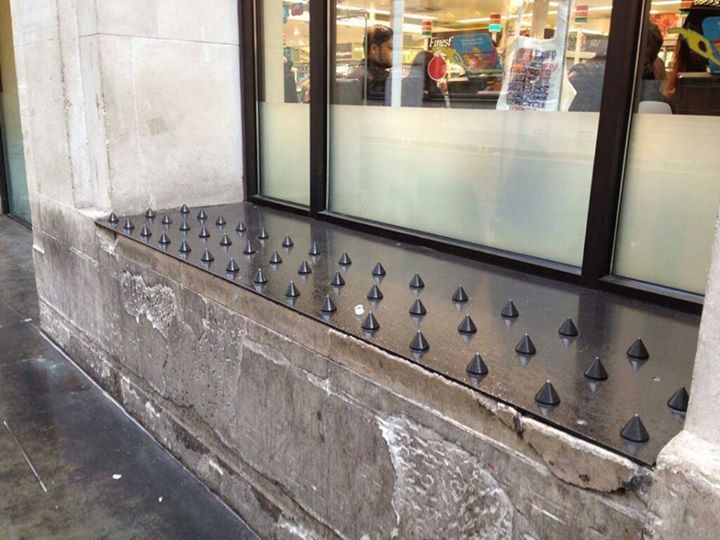
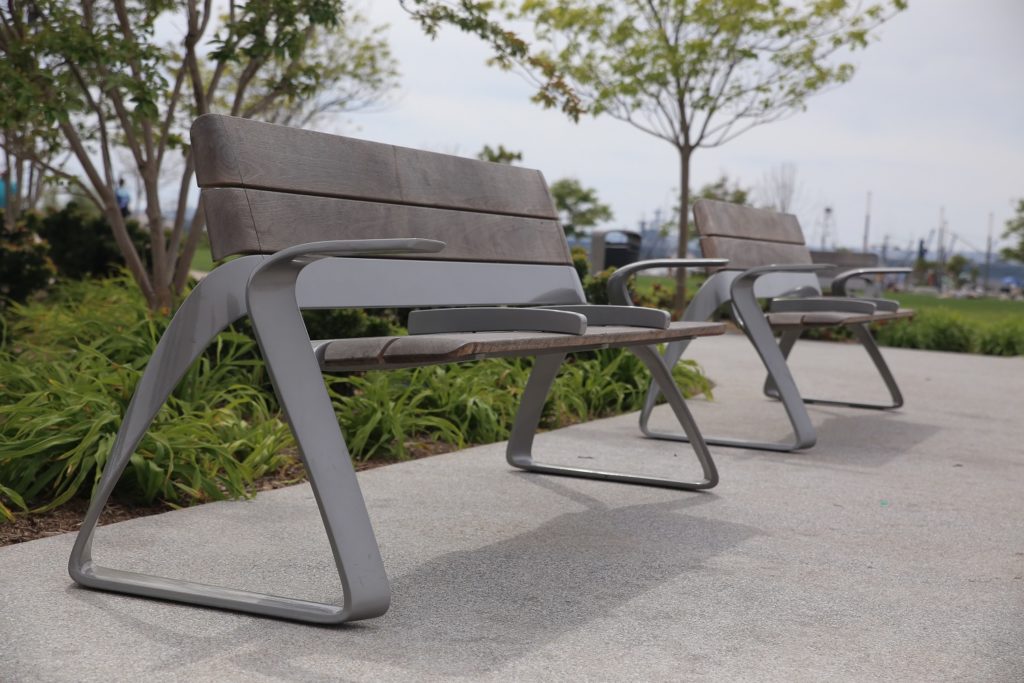
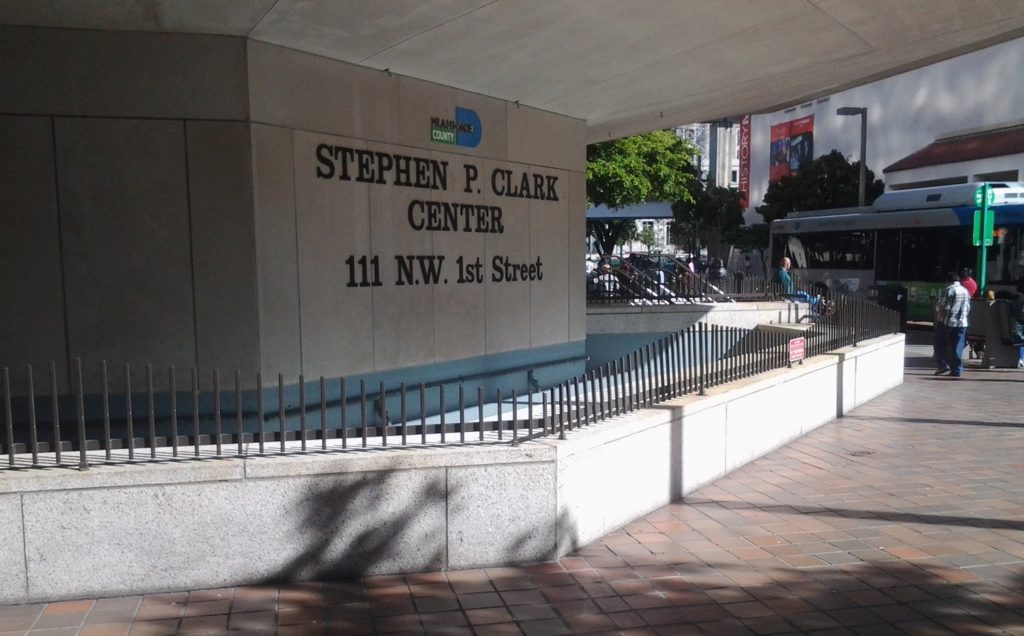
Hostile architecture isn't harmless. The design decision conveys that people who live outside are not welcome. Even when unhoused people use congregate shelters, they can't stay there all day. They must leave early in the morning and can't return until the evening — leaving extra hours available for those who aren't working. With few options, it's yet another obstacle for unhoused people as they try to survive.
People who aren't homeless are also affected, notably when seating in a public space is eliminated. If someone has mobility problems such as muscle weakness, joint pain, or neurological issues, removing a place to sit prevents them from stopping and resting when they need to.
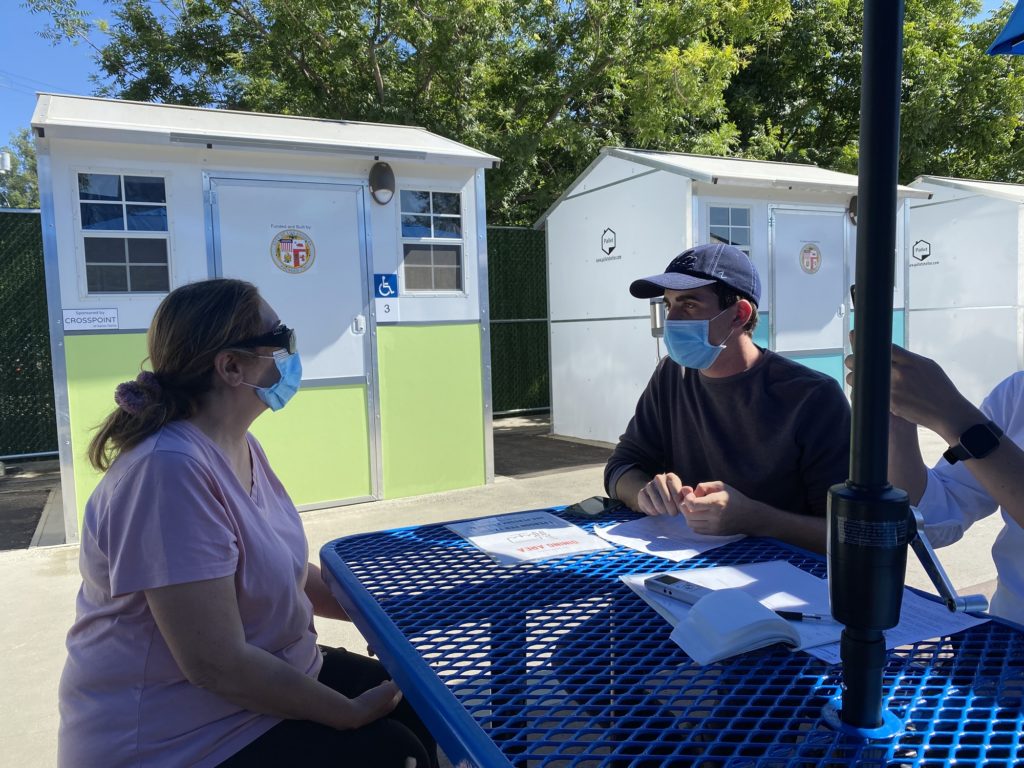
Pallet shelter villages serve as transitional housing communities for people experiencing homelessness. A local service provider operates each village and provides social services, meals, and more.
After an initial assessment and orientation, residents can finally relax and recharge by moving inside a Pallet shelter, a private space with a locking door. Living unsheltered can be disruptive partly because of the threat of being forced to move. It isn't easy — everyone is in survival mode.
Here's some of the services provided at Pallet shelter villages across the country:
Securing documents
People living outside are often subject to "sweeps" of their encampments. During a sweep, anything remaining on the site is cleared away. Campers are given notice, but the length of time they have to move locations varies from city to city. It's common practice for cleanups to lead to the loss of documents, such as an identification card, driver's license, Social Security card, or birth certificate. These documents are necessary for an unhoused person to move into permanent housing. Case managers help residents who need them secure these documents. Because each village has a postal address, the documents can be shipped directly to residents.
Housing navigation
Pallet shelter villages are a place to stabilize before moving on to permanent housing. Navigating the application process or applying for a housing voucher can be challenging. Housing navigators help residents through the steps they need to take, whether for a traditional apartment or supportive housing.
Social services
Being homeless is a traumatic experience, and it takes time to recover. The service providers at our villages offer residents health, mental health, and substance use services.
Sara Allee-Jatta is a clinical substance use counselor in Wisconsin. She's been providing services to residents at our village in Madison. Allee-Jatta recently told PBS Wisconsin, "This is the first time for a lot of people that somebody has been able to just listen without interruption and people can tell their story. So there's a lot of people that just want to come in and be heard and just talk."
Job assistance
It's estimated about 25 percent of people experiencing homelessness nationwide are employed. Job assistance is available for those staying in our villages who don’t have a job. One barrier to employment is not having an address to put on a job application. Staying at one of our villages eliminates that obstacle. John, a former Pallet shelter village resident, is now housed thanks in part to being connected to a job as a forklift driver.
Veterinary visits
According to the National Alliance to End Homelessness, 1 in 5 people experiencing homelessness don't accept shelter because their pets can't join them. Unlike traditional shelters, pets are welcome at Pallet shelter villages. Just like their humans, fur babies need care too. In Los Angeles, Dr. Kwane Stewart and his team at Project Street Vet stop by our villages to perform checkups on the pets.
Celebrations
While everyone living in Pallet shelter village is working on moving toward the next step, it's important to celebrate the milestones in between. Whether it's getting approved for Supplemental Nutrition Assistance Program (SNAP) benefits or receiving a birth certificate in the mail, it's worth highlighting. At Riverside Cabin Village Shelter, residents develop their ideas for activities — one being the construction of vision boards, a collage of images affirming one's desires and dreams. Celebrations are a way to keep everyone's spirits up and support each other in their journey.
Community is one of the cornerstones of Pallet shelter villages. Our villages are places to bring people together for joy, healing, and growth.
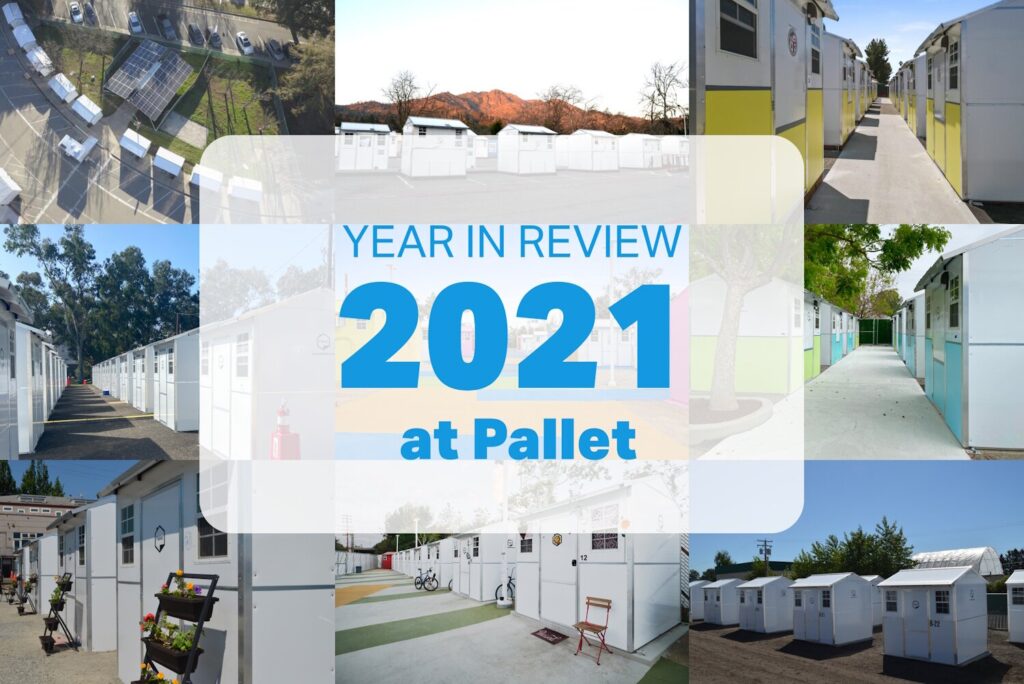
As 2021 comes to a close, we’re taking a look back at the stories we’ve shared throughout the year. It’s been a busy year at Pallet, from new village openings in three new states to introducing a new product: bathrooms for shelter villages. Most importantly, hundreds of people experiencing homelessness are staying in dignified shelter with a locking door and have access to social services. They can stabilize and work towards moving into permanent housing with the assistance of an on-site service provider.
In addition to sharing company news, we’ve also shared information about our homeless neighbors and the challenges they face. Here’s a round-up of our top stories from this year.
1. Los Angeles Opens Its First Shelter Village

In the past year, homelessness in Los Angeles County grew at a rate of 13%. That’s a startling change for any city — but for Los Angeles, where more than 50,000 people live without adequate access to shelter, a 13% increase represents thousands of new people who now live without a roof over their head.
The need for shelters and supportive housing in Los Angeles is more critical than ever. The City of Los Angeles is building Pallet shelter villages for its residents experiencing homelessness to address that need. The first such shelter village of its kind in Los Angeles opened in February. It immediately reached full capacity, with new residents moving off the streets and into their own personal, private, and dignified sleeping cabins. [Keep Reading]
2. Pallet employee Josh thought the life he has today was out of reach
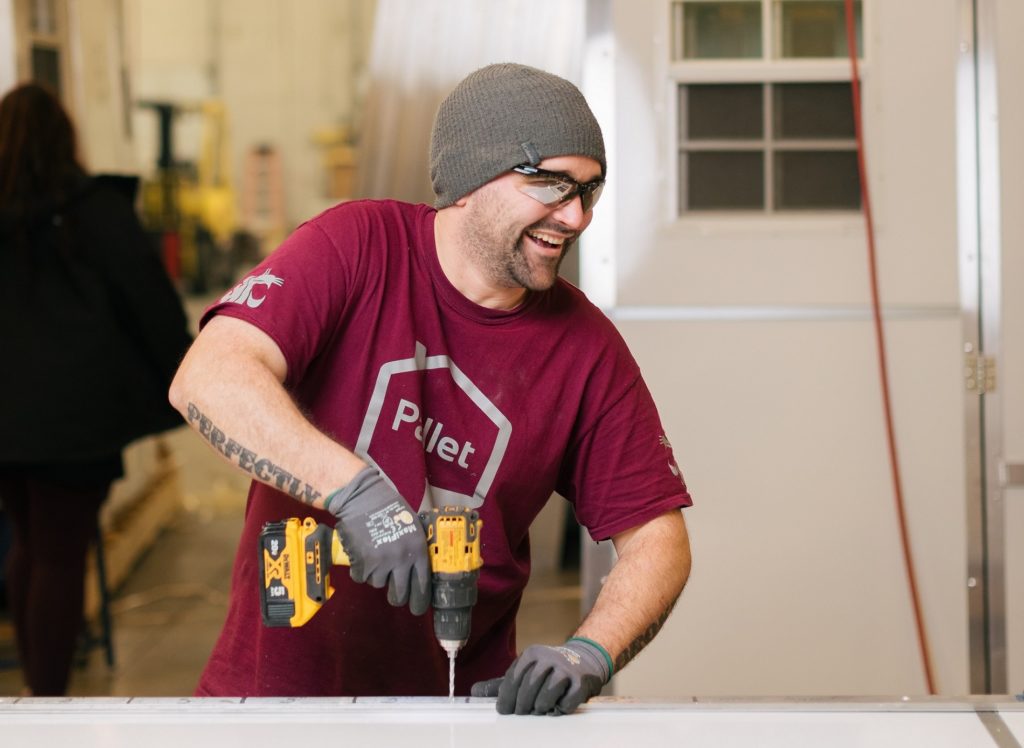
On a sunny spring weekend, Josh and his fiancée exchanged I do's in an outdoor ceremony. The two pledged to be life partners in front of a small group of friends and family. The joyous occasion marked a milestone for Josh he would not have predicted for himself. Several years ago, he was sleeping in his car in the back of a store parking lot. Today he maintains a full-time job here at Pallet, mended fractured personal relationships, and tries to lead by example.
"If you told me almost eight years ago when I got clean, that this is where my life would be, I would not have believed you," Josh shared. "I wouldn't believe you, that I have been with the company for almost four years. I wouldn't believe you, that a woman is head over heels for me and wants to marry me." [Keep Reading]
3. Community check in: Riverside, California
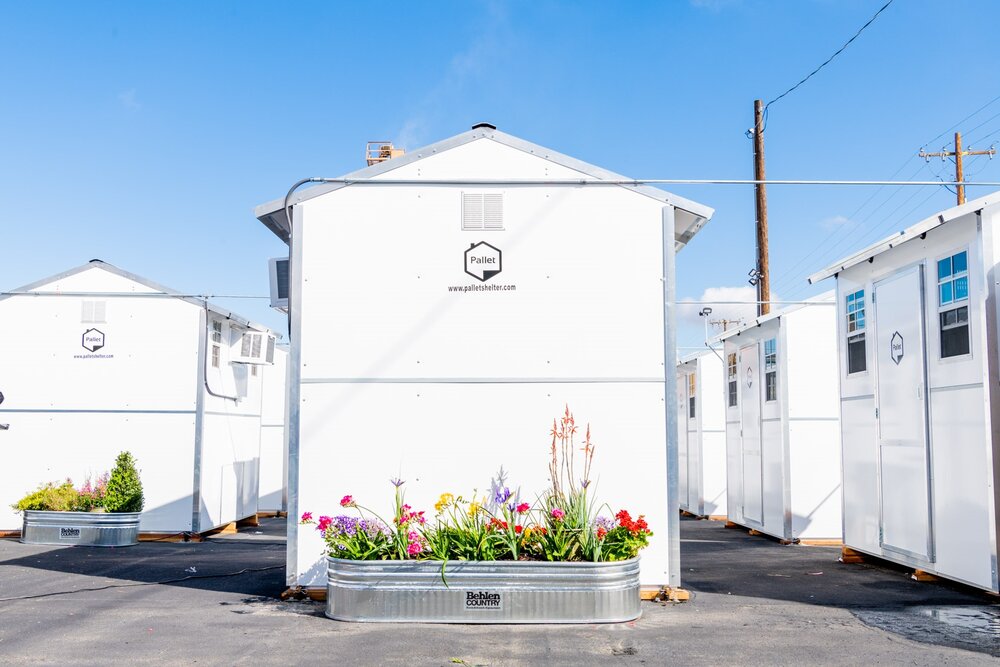
Moving out of homelessness is complex, and the path to stability varies from person to person. However, one proven factor in improving the odds of long-term success is transitional housing. Riverside Cabin Village Shelter offers this critical step with Pallet shelters.
The southern California community opened in March 2020 with 30 shelters. City Net, a nonprofit organization addressing homelessness through the coordination of community efforts, is the service provider. They’ve partnered with the City of Riverside. Residents have access to 24-hour wraparound services, including program supervisors, case managers, and housing navigators. Meals are also provided.
March 16, 2020 - April 30, 2021 impact:
● 149 people served
● 49 people received tenant-based rental assistance (TBRA)
● 41 people permanently housed
● 25% increased their income
● 3 people reunified with family [Keep Reading]
4. Putting people before profit: Why we’re a Social Purpose Company
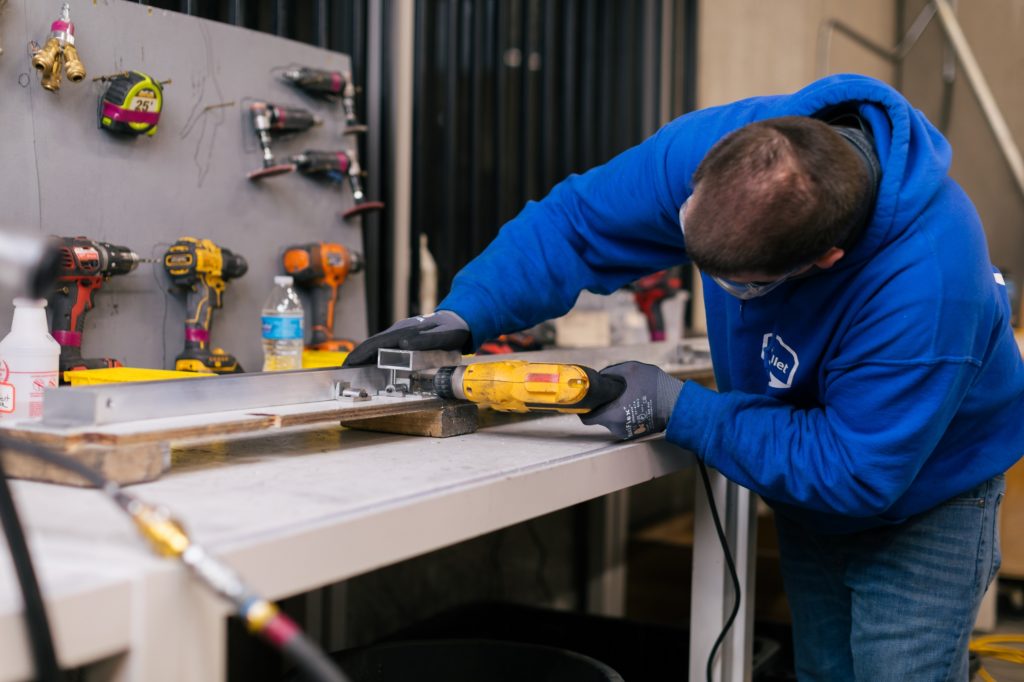
Classifying ourselves as a Social Purpose Company (SPC) is more than an official designation. It speaks to Pallet’s values and purpose. SPC is the Washington state equivalent to a B corporation. It means our team puts a social purpose above making a profit. We're on a twofold mission: build equal opportunity access to housing and employ a nontraditional workforce. [Keep Reading]
5. Profile: Chris Hernandez, Chandler Blvd. Tiny Home Village case manager

Chris Hernandez freely admits he likes to talk. He puts people at ease and effortlessly connects with others. It's a crucial skill in his role as one of two Hope of the Valley Rescue Mission case managers at Chandler Blvd. Tiny Home Village in Los Angeles, California.
"As a young kid, I was always very verbal with people. I was always near people," Chris said. "I've worked in hospice. I've worked with quadriplegic, paraplegic people. I've worked with people with cancer. I was a nursing assistant. I worked in a nursing home. I just love being around people and helping people. And I think I'm good at it."
Chris is part of the staff who provide social services at Chandler Village, a transitional housing community made up of 40 Pallet shelters. [Keep Reading]
6. Debunking homelessness myths: They are not local
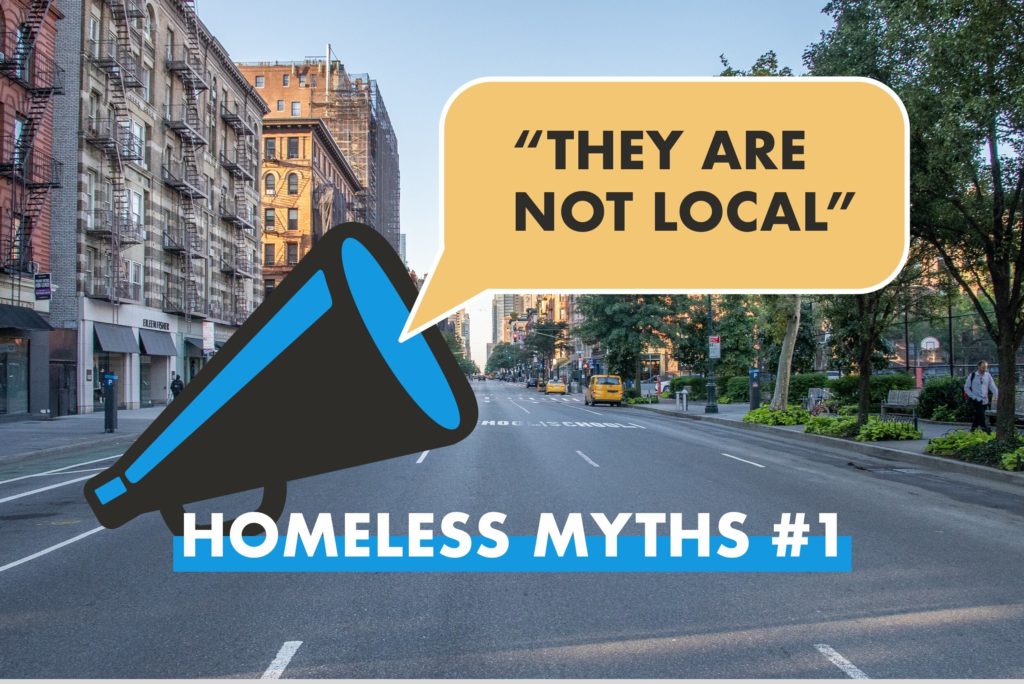
While the myths surrounding homelessness may seem benign, they can have real consequences for unhoused people. Public perception helps shape public policy. When we believe the worst about our homeless neighbors, they aren't shown the compassion and dignity they deserve. Getting back on the path to stability requires support that we should be eager to give.
As part of an ongoing series addressing myths about homelessness we begin with the myth that people experiencing homelessness in a given area are not local — that the majority of those in need have flocked to a given city in search of a handout and government services. It's not unheard of for someone housed to believe that their unhoused neighbors are transplants from another place. We'll explain the problem with this logic later, but first, let's look at some statistics. [Keep Reading]
7. Pallet introduces bathrooms for shelter villages
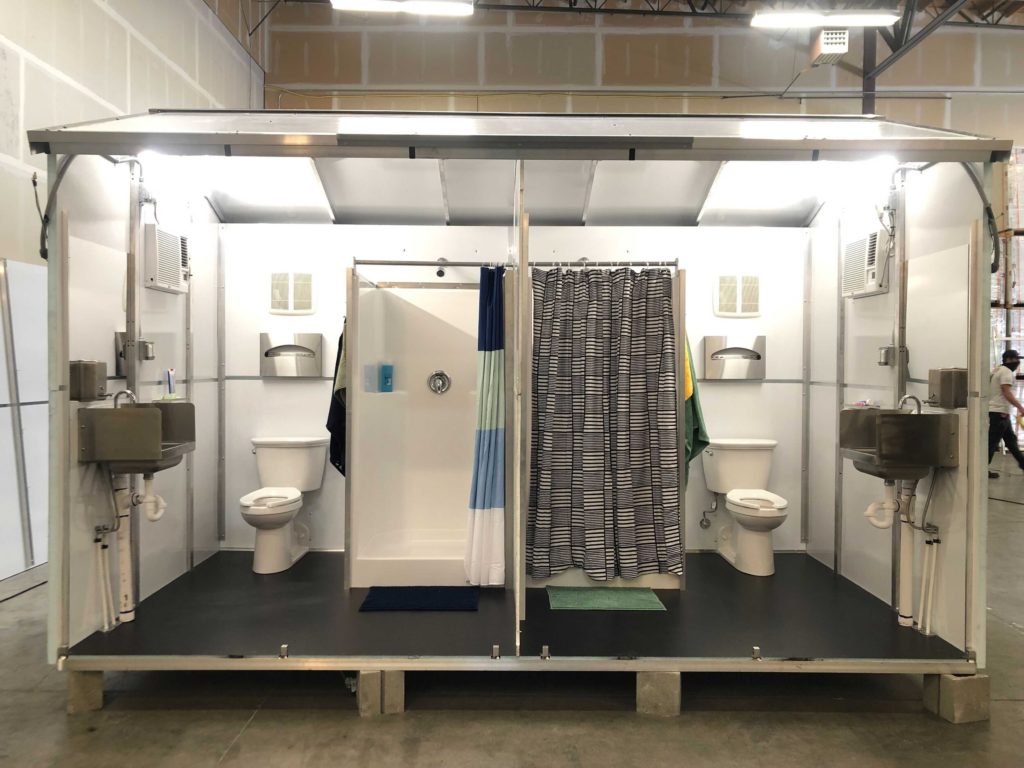
Ensuring Pallet Shelter Village residents have access to bathrooms is an integral part of our community model, along with on-site social services. Having a safe, private space for hygienic needs is one element of our commitment to creating a dignified community for people experiencing homelessness. We're excited to announce Pallet's engineering team has designed a series of bathrooms for communities. Five designs include various combinations of a sink, toilet, and shower. A tankless water heater assures that hot water will be readily available.
The new bathrooms are an evolution of our 64 sq. ft. and 100 sq. ft. sleeping cabins. The same material is used for the structure, aluminum framing and walls composed of fiberglass reinforced plastic with a foam insulating core. The team modified the basic structural design to meet its new purpose. This approach allowed our engineers to move quickly to meet this need. [Keep Reading]
8. Five tips to become a second chance employer
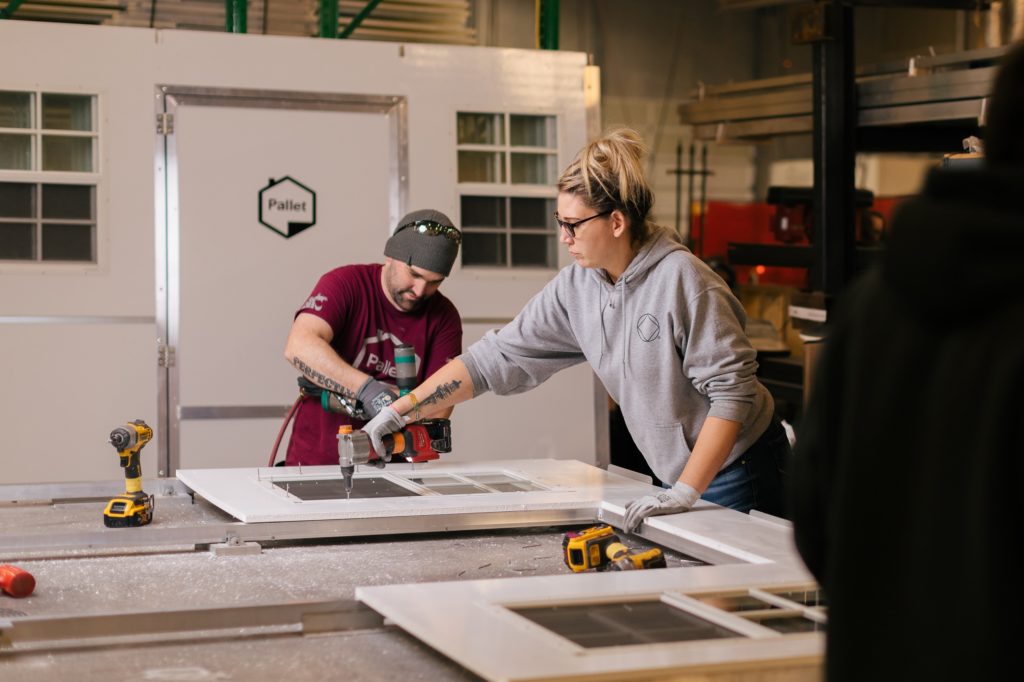
Pallet's nontraditional workforce is an integral part of our success. Temporary shelters are the foundation of our people-first restorative communities across the country for unhoused people. Because our team members have lived experience in homelessness, Pallet makes a product that uniquely meets the needs of people who have been living on the street. Their input is essential.
As a second chance friendly employer, we believe potential — not the past — defines people's futures. More than 80% of our employees are formerly homeless, in recovery, or previously involved in the justice system. Amy has shared her expertise with companies considering tapping into this hidden workforce. Here are her five tips to get started [Keep Reading]
9. Veterans move into Pallet shelters
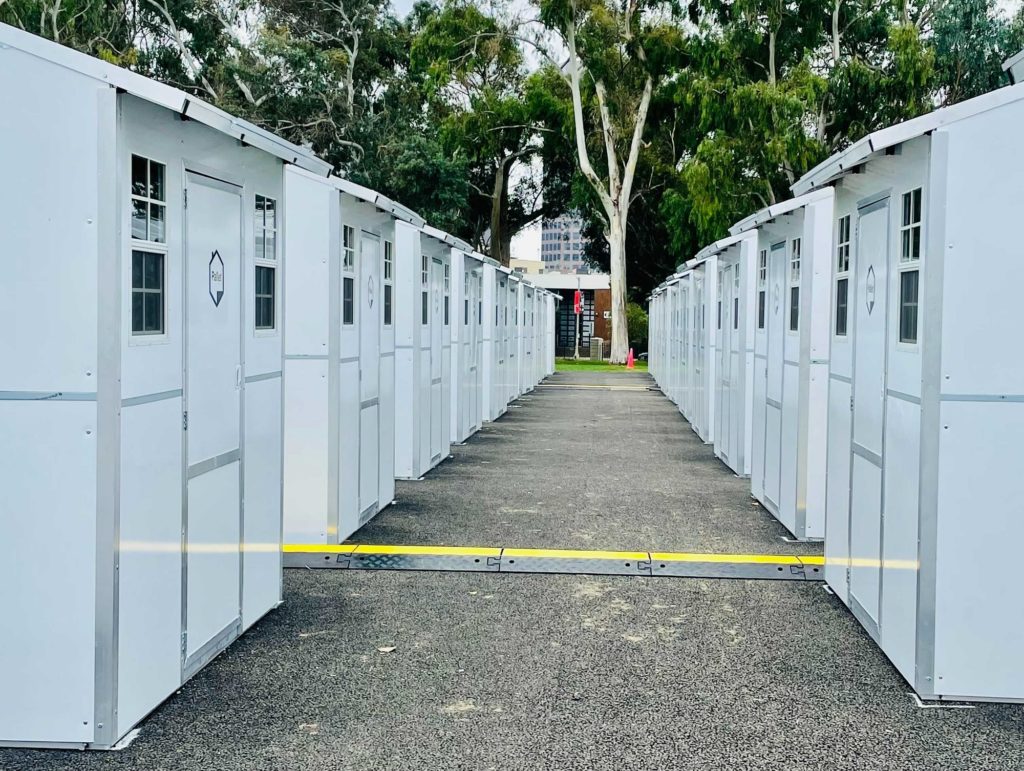
A group of people who served our country moved from unsheltered homelessness into dignified temporary housing. The new village is operated by VA Greater Los Angeles Healthcare System. It is located on their property in West Los Angeles. It's part of their Care, Treatment & Rehabilitative Services (CTRS) Initiative, a low-barrier-to-entry outreach program. There are a total of 28 Pallet shelters on site. Veterans are offered the shelters based on a priority list with the most vulnerable veterans receiving higher priority. [Keep Reading]
10. From winter to summer Pallet shelters can weather the conditions

Pallet's mission is to unlock possibilities by building people-first restorative communities. There are Pallet shelter villages in 1 in 5 states with 3,000 beds and counting. Each location addresses the homelessness crisis with a resource net of social services and a safe place to sleep. As Pallet partners with local governments and nonprofit organizations to build transitional housing villages, it's crucial our shelters can withstand various weather conditions. People should have resources to stay cool in the summer and warm in the winter. Pallet’s engineering team completed performance testing on the 64 sq. ft. and 100 sq. ft. cabins to refine our sleeping cabins’ designs. [Keep Reading]

'Tis the season for giving. Two groups in need of extra help are our unhoused neighbors and people experiencing poverty. Many individuals and families are still dealing with economic uncertainty because of the coronavirus pandemic. But you can help your neighbors today by donating items in high demand. Below is a list of items needed right now at food banks, homeless shelters, and other organizations assisting people in poverty.
Winter items
Winter officially begins December 21, but many areas are experiencing frigid temperatures now. Warmth and protection from the weather are essential this time of year. If you're buying new items, keep in mind a range of sizes is needed.
● Coats
● Gloves
● Scarves
● Hats
● Hand warmers
● Crew socks, wool socks (new)
Food
According to the nonprofit Feeding America, 1 in 8 people faces hunger, and 1 in 6 children faces hunger. Across the country, food banks are serving more individuals and families. Volunteers of America, a nonprofit organization providing housing assistance and other services has seen demand for food increase significantly. According to a published report, "Volunteers of America went from distributing 3.7 million pounds of food the year before the virus took hold to nearly 8 million pounds the first year of the pandemic." In addition to the rise in demand for food assistance, an increase in inflation has also meant fewer community contributions.
● Non-perishable canned food such as soup, fruit, and beans
● Peanut butter
● Pasta
● Rice
● Fresh fruits and vegetables
● Snack bars
● Canned meat such as tuna
● Lean proteins such as a whole chicken *some food banks have space for items that need to be kept cold or frozen, call ahead to double check
● Dairy products such as milk, cheese, and yogurt
Toiletries
Personal care products can be expensive for people who are already struggling to make ends meet.
● Toilet tissue, deodorant, lip balm, menstrual care products
● Toothpaste, soap
● Shampoo and conditioner (travel sized works best for unhoused people)
● Diapers and wipes
● Hand sanitizer
Items for outreach services
Organizations serving people experiencing homelessness typically go out into the community to reach people living unsheltered, helping to meet the immediate needs of the unhoused.
● Sleeping bags
● Sleeping pads
● Solo tents
● Tarps
● Umbrellas
Financial donation
Financial donations help an organization meet their specific needs as it can change often. It also allows them to purchase what they need when donations are low so they can continue to serve the community.
Before you donate it’s a good idea to call or check the website of the organization you’re interested in helping. They may have a list of items you can buy directly and send to them.
For more ideas, check out our list of most needed to help our homeless neighbors year-round.

Oakland City Council President Nikki Fortunato Bas officially introduced Lakeview Village to the surrounding community on a rainy Monday morning. Neighbors eagerly walked through the village to see the new addition. The day's weather reinforced the value of Pallet shelter villages for people experiencing unsheltered homelessness. Living outside means exposure to the elements, from rain to snow to extreme heat. Our shelters provide protection, security, and dignity.
Lakeview Village is located on city-owned property near Lake Merritt. It's a first-of-its-kind solution to addressing homelessness in Oakland. The parcel on which it’s built is slated for future development, but rather than letting the land remain unused while people slept outside, city officials created an innovative and compassionate interim solution.
Residents are staying in Pallet shelters with the following amenities: a foldable bed, personal climate control, windows, electrical outlets to power personal devices, shelves, space for storage, a fire extinguisher, and a locking door. They'll also have access to meals, bathrooms, and showers. Each shelter is single occupancy. Residents also have access to a community room that contains a mini kitchen. Housing Consortium of the East Bay (HCEB) is the service provider for the site.
HCEB Program Manager for Lakeview Village Kevin Cockerham said once residents get settled, they'll focus on getting people "document ready." HCEB case managers will help residents get replacement identification cards, birth certificates, and social security cards. Housing navigators will assist them with finding a permanent place to live. Social services are also available.
"We are making sure that we're providing trauma-informed services, harm reduction services around three areas: health, mental health, substance, and other health and wellness issues," Nikki explained. "Secondly, economic issues. There are many reasons why people become homeless even when they're working."
Kevin is excited about the opportunity to help the new residents of Lakeside Village. He's worked at HCEB for two and a half years and is proud of his work assisting people in finding permanent housing. He's learned his position requires empowering the people he's working with and being a life coach as well.
"A lot of people don't believe that the hard work is going to get them to where they want to be," Kevin shared. "So I'm just like that crutch, that backbone for them. 'C'mon, let's keep pushing, keep pushing.' Then when something happens, I just bring it to them like, 'Look what you did. You were successful in this.' That's a part of where we want to go, of our goals."
There isn't a set timeframe for how long people can stay at Lakeview Village. Because each person's situation is unique, they'll be on individualized plans.
More village news:
New Beginnings Pallet shelter village opens in Arkansas
Pallet shelter village opens in Everett, WA
Community check in: Riverside, California
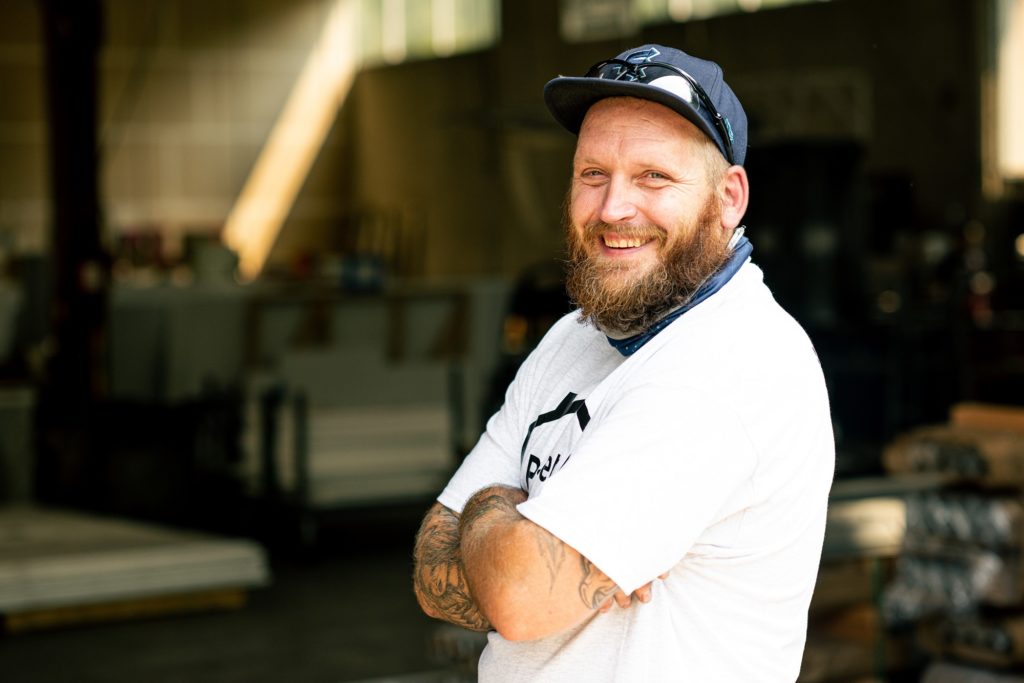
Since J.J. began working at Pallet in the spring 2020, he's become an integral part of the team. In a short time, he was promoted from manufacturing specialist to production supervisor. His leadership skills and genuine desire to help others made him a natural fit for the position. The role is more than just making sure everyone is working safely and efficiently.
"Part of it is trying to figure people out, because I know how easy it is to just make a snap judgment on somebody and be done with it," J.J. explained. "I like to try to figure out what makes them tick and the best way to teach them so that I can get them to feel the best."
J.J. is a native of the Pacific Northwest who worked in construction and R.V. assembly before joining Pallet. At one point, he supervised a team of 16 people. J.J. described Pallet as an environment unlike others he's worked in: a family he didn't know he had. His outgoing personality has helped him easily bond with co-workers. Like many of them, he's experienced childhood trauma, homelessness and is in recovery.
He understands who they are and what they need. They can count on him even outside business hours, "They're my brothers, and they're my sisters. There's nothing I won't do for them. I don't care if they call me at one o'clock in the morning and I don't have to be up for an hour and a half. And they say, 'I'm struggling.' I got those calls. 'Bro, where you at? I'll be there in a minute.'"
J.J. takes his role seriously because of the positive impact our work has on the community. He's taken the words of Amy King, Pallet Founder and CEO, literally when she told staff that without them, someone spends yet another night experiencing unsheltered homelessness.
"My purpose is to hit whatever shelter production number they tell me to get. So that somebody doesn't have to sleep on the streets. That is my purpose now and to help people grow," J.J. shared. "They come in here; they're broken, they're just getting clean, just getting out. Doesn't matter what their story is. I'm trying to get it to where they understand that they're valued and that they're able — even if they decide Pallet isn't for them."
Despite his personal experience with homelessness, working at Pallet has been a learning experience as well. He now has a better understanding of the dangers women living on the street face and why the lockable door on our shelters is vital.
Sometimes in life, we have experiences that we don't fully understand until years later. J.J. had one of those moments during a company-wide meeting. Amy talked to the group about people helping others who aren't doing it for recognition. At that moment, an old memory came back to him. J.J. grew up in a tumultuous household, so he frequently ran away as a teenager. At one point while living on the streets, he slept by a hedge outside of a home. The heat coming from a nearby dryer vent kept him warm. The homeowner kept the dryer going at night for several weeks and left him food as well.
"I was 15 years old. How do you grasp that somebody is willing to do something like that for you? And it clicked to me that she had left her dryer on for me that month and a half I stayed there," J.J. said. "There's people that are in the shadows that are truly just trying to help. They don't want recognition for it."
J.J. is paying it forward and bringing the same approach to his role at Pallet.
Outside of work, J.J. enjoys spending time with his wife and kids, camping, and going to sporting events.
We no longer require resumes to work at Pallet. Here's why.

This Veterans Day, we're proud to share some good news: a group of people who served our country moved from unsheltered homelessness into dignified temporary housing.
The new village is operated by VA Greater Los Angeles Healthcare System. It is located on their property in West Los Angeles. It's part of their Care, Treatment & Rehabilitative Services (CTRS) Initiative, a low-barrier-to-entry outreach program. There are a total of 28 Pallet shelters on site. Veterans are offered the shelters based on a priority list with the most vulnerable veterans receiving higher priority.
UPDATE: In December, 2021 former California governor Arnold Schwarzenegger donated $250,000 to the nonprofit Village for Vets for the purchase of 25 Pallet shelters. There are now a total of 78 shelters on the site.
The Pallet shelters they are staying in include the following amenities: a foldable bed, personal climate control, windows, electrical outlets to power personal devices, fire safety equipment, and a locking door. They'll have access to meals, bathrooms, and showers, as well as peer support, medical care, and behavioral health services. This is Pallet’s first-ever village built exclusively for veterans experiencing homelessness.
"The shelters provide additional privacy and protection from the elements, making participants more comfortable as they work with their case managers to receive the supportive and medical services available to them on campus," Chanin Santini, CTRS supervisor, said.
Pallet shelters were added to what was previously only a safe tenting site at the request of veterans who had heard of “tiny home” villages for those experiencing homelessness. The shelters were quickly added to the site when a nearby homeless tent encampment traditionally occupied by veterans was disbanded. In addition to Pallet shelters, veterans could move into a safe, clean, designated tented living area.
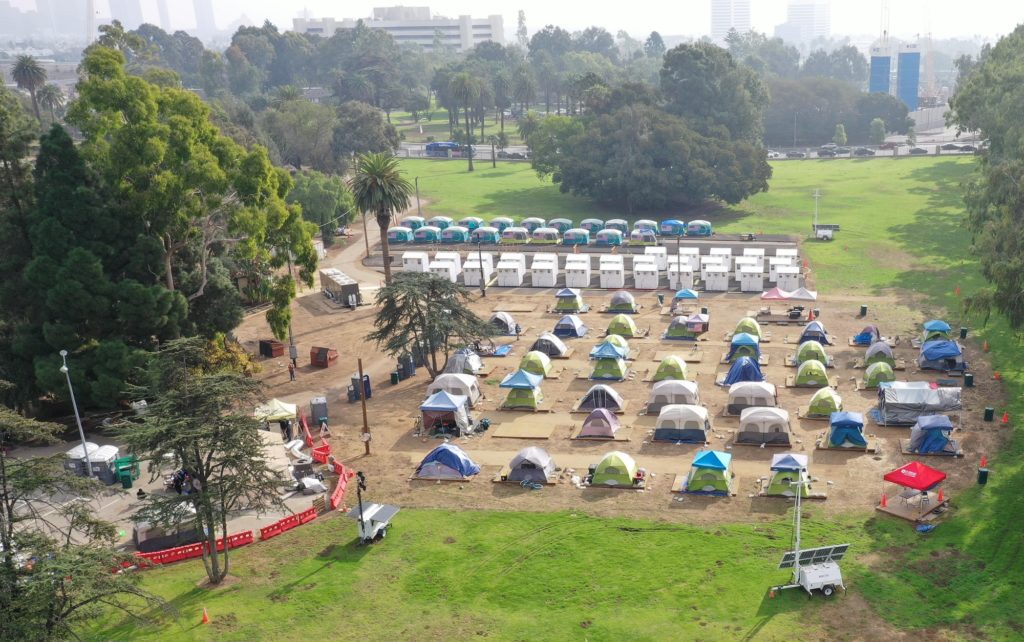
CTRS is a pilot initiative that provides unsheltered homeless veterans expanded access to VA services during the COVID-19 pandemic. VA officials say the goal is to improve unsheltered veterans' healthcare outcomes while guiding them toward permanent housing solutions.
In the greater Los Angeles area, the latest count showed there were 3,902 veterans experiencing homelessness. The majority were unsheltered. Across the country, 8 percent (37,252) of homeless adults are veterans.
Pallet is proud to be a part of this initiative. Our shelter villages rapidly address unsheltered populations — by providing the dignity of private space in a healing community environment.
How Pallet provides a transitional step to permanent housing

Hundreds of thousands of people are experiencing homelessness across the country. Whether they're temporarily staying in a hotel or living outside, they face daily challenges.
Kevin Fitzpatrick is a homeless advocate and board member of a Pallet shelter village service provider. He says people experiencing unsheltered homelessness, in particular, are focused on basic survival. A weather event such as rainfall can create a significant obstacle.
"After a rainstorm, you worry about how you're going to dry everything. That could be your whole day trying to dry your sleeping bag, trying to air out your tent. All the things that got soaking wet that day," Kevin explained. "I think most people don't ever really think about the mechanics of what that looks like day to day. If they were, I think we would have a much more empathetic country than we have right now."
Donating items directly to an individual or a shelter can make a difference.
If you're interested in helping your homeless neighbors, below is a list of frequently requested items. Anything you donate should be new or gently used. Personal care items are best when travel-sized and new (half-empty bottles will not be accepted). Many nonprofit organizations post their wish lists online to ensure they receive what's needed. Calling ahead is also a good idea.
1. Socks

Socks are always needed but often the least donated item. They provide warmth and protection but also get dirty and wear out quickly. Imagine taking a shower then putting dirty socks back on because that's all you have? Access to clean socks helps keep our feet healthy. White crew socks are typically preferred. Wool socks are especially helpful in the winter.
J.J., a Pallet employee, has experienced homelessness. He said they were a must-have item in part because he never took his shoes off. He explains why: "One, you never know when you're going to have to run. And two, if your shoes are off and somebody wants them, and they take them. What are you going to do? Walk around barefoot?"
2. Personal care products
Personal care products help us feel clean and are needed year round.
● Body wash
● Deodorant
● Ethnic hair care products
● Menstrual care products
● First-aid supplies such as bandages
● Hand sanitizer
● Masks
● Razors
● Reusable water bottles
● Toothpaste, toothbrush
3.Clothing
Proper clothing is important especially in the winter months. Hand and feet warmers are also useful when people are staying outside.
● Gloves
● Hats
● Hoodies
● Jackets
● Jeans / Pants
● Shirts
● Underwear
4. Gift cards
Gift cards to grocery stores, department stores, fast food restaurants, or even a gas station are a good idea. Gift cards give people the flexibility to buy exactly what they need in a dignified way. They also give people experiencing homelessness the ability to become a paying customer, which is often the threshold to come inside, get warm, and use the restroom. Gas station gift cards are useful to people who sleep in their vehicle. Bus tickets/passes are useful as well.
5. Pet food and supplies
Pet ownership among people experiencing homelessness isn't uncommon. According to the National Alliance to End Homelessness, "evidence shows that animal companionship is fortifying and contributes to the emotional well-being of people experiencing homelessness." One study found homeless pet owners feed their pets before themselves. For women, pet ownership while living outside also helps keep them safe. Donating pet food and supplies helps unhoused people maintain a vital bond. Pallet recognizes the importance of keeping fur babies with their owners. It's why our shelter villages welcome people with pets.
Providing unhoused people with what they need rather than judgement is the minimum we can all do.

Homelessness in the U.S. is a growing crisis. Over the last four years, the number of people in need has increased. According to the Department of Housing and Urban Development (HUD), about 18 of every 10,000 people in the nation are unhoused. More than half live in four states: California (28 percent), New York (16 percent); Florida (5 percent); and Texas (5 percent).
Homelessness generally means an individual or family without fixed, regular, and sufficient nighttime residence. It includes people staying in congregate shelters, transitional housing, and those on the street. People living in hotels, and motels paid for by a charitable organization or government program are also considered homeless. In addition, homelessness applies to people leaving an institution where they stayed for 90 days or less and previously didn't have housing.
Unsheltered homelessness refers to people sleeping outdoors in locations not designed as a regular sleeping location, such as the street, a park, under an overpass, in tent encampments, abandoned buildings, or in a vehicle. People living in public places often attract the most attention in part because research shows people often have a visceral response to visible poverty.
Unaccompanied youth under 25 experiencing housing instability, plus people fleeing domestic violence who don't have a support network, are also considered homeless.
The National Coalition for the Homeless states there are three types of homelessness: chronic, transitional, and episodic.
People experiencing chronic homelessness are entrenched in the shelter system, which acts as long-term housing for this population rather than an emergency option. They are likely to be older, underemployed, and often have a disability.
Transitional homelessness is when people enter the shelter system for only one stay – usually for a short time. They are likely to be younger and have become homeless because of a catastrophic event.
Episodic homelessness refers to people who experience regular bouts of being unhoused. Unlike transitional homelessness, they are chronically unemployed and may experience medical, mental health, and substance use issues.
Another category is imminent risk of homelessness. It applies to individuals and families on the brink of being unhoused. They have an annual income below 30 percent of the median income for the area. They don't have sufficient resources or support networks needed to obtain other permanent housing.
Hidden homelessness refers to people who aren't a part of official counts. They might be couch surfing at a friend or a relative's house.
Whether we can see our homeless neighbors or not, they deserve a safe place to stabilize. Homelessness isn't a personal failure; it results from many factors, including poverty, lack of affordable housing, and structural inequality.
Pallet shelter villages provide a crucial step to move people off the streets and into a place of their own, combining the dignity of personal space in a healing environment. A resource net of onsite social services and food, showers, laundry, and more helps people transition to permanent housing.

One prevailing view of homelessness is that it's a personal failure. The false belief implies people living on the street have done something wrong to cause their misfortune. This view doesn’t recognize structural issues that can inhibit one's ability to keep their head above water. It's not uncommon to hear, "homeless people are all on drugs" or "homeless people are all mentally ill." These statements aren't true.
Data and surveys show economic factors — such as losing employment — are the leading cause of homelessness from urban to rural areas. The most recent count by the Department of Housing and Urban Development shows there are 580,466 unhoused people across the country. No one is immune to falling on hard times, a fact highlighted by the effects of the coronavirus pandemic.
This post is part of a series that debunks homelessness myths. In part one, the "they're not local" myth is addressed. Following is a look at factors contributing to homelessness.
Economic Conditions
A 2020 Greater Los Angeles homeless count showed 59 percent of people experiencing homelessness for one year or less cited economic hardship as the main reason for their loss of housing. This was followed by a weakened social network (39 percent) and disabling health condition (24 percent). Respondents were able to choose more than one reason.
Sixteen percent of people surveyed during a 2020 point-in-time count in King County, Washington, showed losing a job as the reason for their homelessness. Other economic-related reasons included: could not afford rent increase (8 percent); eviction (5 percent); foreclosure (1 percent); totaling 30 percent.
A 2018 Council on Homelessness report from the Florida Department of Children and Families states, "most people who become homeless in Florida have extremely low incomes making it difficult to maintain stable rental housing." The report lists three primary factors contributing to homelessness in Florida: lack of access to housing, need for employment and income opportunities, and inadequate access to health care.
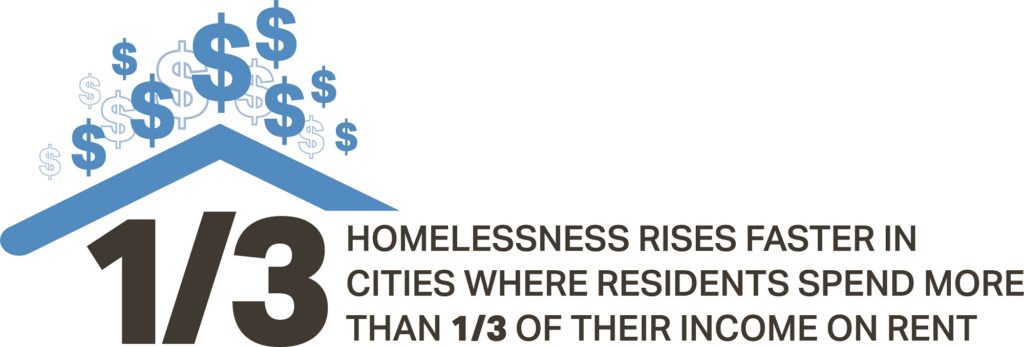
The Council on Homelessness report highlights how lack of affordable housing and poverty are intertwined components of the homelessness crisis. Homelessness rates rise faster in cities where residents spend more than one-third of their income on rent. In only 7 percent of all U.S. counties can a full-time minimum wage worker afford a one-bedroom rental home at fair market rent, according to a 2021 National Low Income Housing Coalition report.
Additional factors contributing to homelessness:
Domestic violence
Domestic violence is a leading cause of homelessness for women and children, according to the Washington State Coalition Against Domestic Violence. In a 2014 survey of 25 U.S. cities, 15 percent of all homeless adults were survivors of domestic violence. An ACLU report on homelessness calls attention to the link between domestic violence, poverty, and eviction.
Substance Use
From the Addiction Center:
"The National Coalition for the Homeless has found that 38 percent of homeless people are alcohol dependent, and 26 percent are dependent on other harmful chemicals. Often, addiction is a result of homelessness. The difficult conditions of living on the street, having to find food, struggling with ill health, and being constantly away from loved ones create a highly stressful state of being. Individuals suffering from homelessness may additionally develop psychiatric conditions in response to a harsh lifestyle often characterized by feeling threatened by violence, starvation, and a lack of shelter and love."
A national report from the same year (2017) shows the national substance use rate in people 18 and older was 7.6 percent. This data includes people living in homeless shelters, but not those who aren’t.
Mental Illness
From a National Coalition for the Homeless report:
According to the Substance Abuse and Mental Health Services Administration, 20 to 25 percent of the homeless population in the United States suffers from some form of severe mental illness. In comparison, 6 percent of Americans are severely mentally ill (National Institute of Mental Health, (2009).
The list above are just a few of the factors contributing to homelessness. It’s a complex issue without a one size fits all solution. Despite the images often associated with the unhoused — an older single male — homelessness also affects families. Black people are four times more likely to experience homelessness because of structural racism. LGBTQ+ youth, people who have been incarcerated, and those with a prior history of homelessness are also at increased risk of experiencing homelessness.
Homelessness can happen to anyone and it isn't a personal failure. Instead, it's an outcome of poverty, a lack of affordable housing, and structural inequality.
PART ONE: Debunking homeless myths: They’re not local

Why are warming centers important in the winter?
Winter brings an increased risk of hypothermia for people living in tents. Hypothermia starts to set in when your body loses heat faster than it can be produced.
Homelessness is always a crisis – but in winter the stakes are higher.
Inclement weather closes public buildings where people experiencing homelessness access resources, such as libraries, college campuses, or volunteer-led food pantries. When snow storms or hazardous conditions impede public services, people experiencing homelessness suffer.
Flu, the common cold, and other illnesses are also spread during wintertime. According to the CDC, flu activity peaks between December and February. Learn more about how winter affects homelessness.
Why are personal sleeping shelters important?
Warming centers get people inside as quickly as possible. But for personal reasons, some of these people require private space, or they may not accept shelter at all. Each person experiencing homlessness has their own story. Having personal space – just like in an apartment or home – allows people to develop their own routines.
Congregate or large warming shelters may not work well for people who have:
- Experienced domestic violence, and are worried about running into past partners
- LGBTQIA+ families that need a safe place to stick together
- Irregular schedules, such as working graveyard shifts
- Compromised immune systems
- Pets that also need space to shelter, exercise, and food
- Important survival gear they cannot abandon
Having a personal sleeping shelter is a good way to serve more of the population.
Pallet is the leader in building transitional housing – “tiny homes” – for people experiencing homelessness. Our village model has been implemented across the United States in different climates, and has been tested to temperatures as low as -40°F while maintaining 70°F interior temperatures.
Pallet shelter villages are a low-barrier option for people experiencing homelessness. Private sleeping shelters have locking doors, insulation, and optional heating and air conditioning. Many Pallet villages allow pets, too. All Pallet shelter villages are run by on-site service providers local to the community. Villages are a safe place to seek help for mental illness or substance use disorders.
Learn more about Pallet shelter villages.
What services should warming centers have on-site?
When harsh weather continues for weeks or months, everyday services become more important. On-site facilities can help people experiencing homelessness with:
- Laundry facilities
- Lockers to store belongings
- Clean bathrooms with warm, private shower stalls
- Charging stations for cell phones and electronic devices
- A dining center to eat and pick up pre-packed snacks
- Water bottle refill stations
Pallet shelter villages are designed as an all-encompassing community for residents who shelter there. Local service providers work with people experiencing homelessness who live on-site. Residents have access to bathrooms, hand-washing stations, dining facilities, electricity, heating, and more.
What is good to donate to warming shelters?
Each warming center has different needs, so it’s always a good idea to check before starting a fundraiser or making donations. Call ahead and ask if they are taking:
- Backpacks
- Bottled water
- Packaged snacks, such as granola bars or apple sauce
- Waterproof gloves, jackets, and boots
- Hand and foot warmers
- Wool socks
- Disinfectant supplies
- New underwear
- Blankets
Better serve people experiencing homelessness in your area by planning ahead this winter. Warming centers and private shelters should be used to reduce the risk of hypothermia and illness.
Get Started
People experiencing homelessness deserve a safe and dignified space this winter.
Learn MoreMore on Pallet’s employment model:
Five tips to become a second chance employer
FAQ’s about becoming a second chance employer
Resume Not Required

Risk of hypothermia and frostbite
For people experiencing unsheltered homelessness, living outdoors poses a greater risk during winter. Cold weather can cause hypothermia – where your body loses heat faster than it can be produced. People experiencing homelessness tend to lack access to vital resources, including insulated winter clothes and warm shelter. This is especially true at night, when temperatures can drop below freezing.
When your body temperature is at 95 degrees Fahrenheit or below, it becomes critical to seek help. According to the Centers for Disease Control and Prevention (CDC), low body temperature affects the brain; hypothermia symptoms include:
- Memory loss
- Slurred speech
- Drowsiness
- Shivering
Frostbite is another risk – usually affecting the nose, ears, cheeks, chin, fingers, and toes, according to the CDC. Severe cases of frostbite can lead to amputation if left untreated. People experiencing homelessness may not be able to seek medical attention, especially when there is lack of access to affordable transportation.
Congregate shelters fill up fast – and aren’t for everyone
When the weather is mild, people experiencing homelessness may seek refuge in their own private space – whether that’s a tent or car. Wintertime is a different story. As people seek warmth, congregate shelters begin to fill up.
But congregate shelters aren’t the first choice for everyone. Here are some reasons why people choose to stay in tents during the winter:
- Most congregate shelters are gender-specific, meaning not all families, couples, or friends can stay together
- Work schedules may not align with congregate shelter hours
- Most congregate shelters do not allow pets
- People who have experienced trauma may have difficulty being around strangers
- Congregate shelters limit the belongings you can bring in, sometimes only allowing a backpack
- Safety can also be a concern, since there are different personalities in an enclosed space
- Fear of getting bed bugs in a communal setting
- Inability to sleep when it’s noisy
Spread of flu and other viruses
As people seek warmth at congregate shelters in fall and winter, it’s likely a few people entering these shelters have been impacted by coronavirus, the flu or other viruses. Like any communal setting – from workplaces to concerts – there’s an increased risk of catching a bug. Congregate shelters are a great way to house as many people as possible, but carry the risk of outbreaks. COVID-19 and the flu are easily spread in the air.
Closure of public spaces, from dorms to food pantries
Snow, frozen roads, windstorms, and other winter weather can close crucial resources for people experiencing homelessness. For example, some cities turn off communal water fountains to reduce the risk of freezing pipes; this could also affect public restrooms, making access impossible.
When roads close or power outages occur, staff can’t reach their workplaces. Community libraries, food pantries, college campuses, and more may close quickly with little advance notice. This means people experiencing homelessness – including students – may not have anywhere to go. Some residence halls even close during winter time. What happens if a student doesn’t have anywhere safe to stay?
In the event of a city-wide shutdown or power outage, people who are sleeping outside may no longer have a way to look up modified bus routes or connect to friends on their phone.
Get Started
People experiencing homelessness deserve a safe and dignified space this winter.
Learn MoreMore on Pallet’s employment model:
Five tips to become a second chance employer
FAQ’s about becoming a second chance employer
Resume Not Required
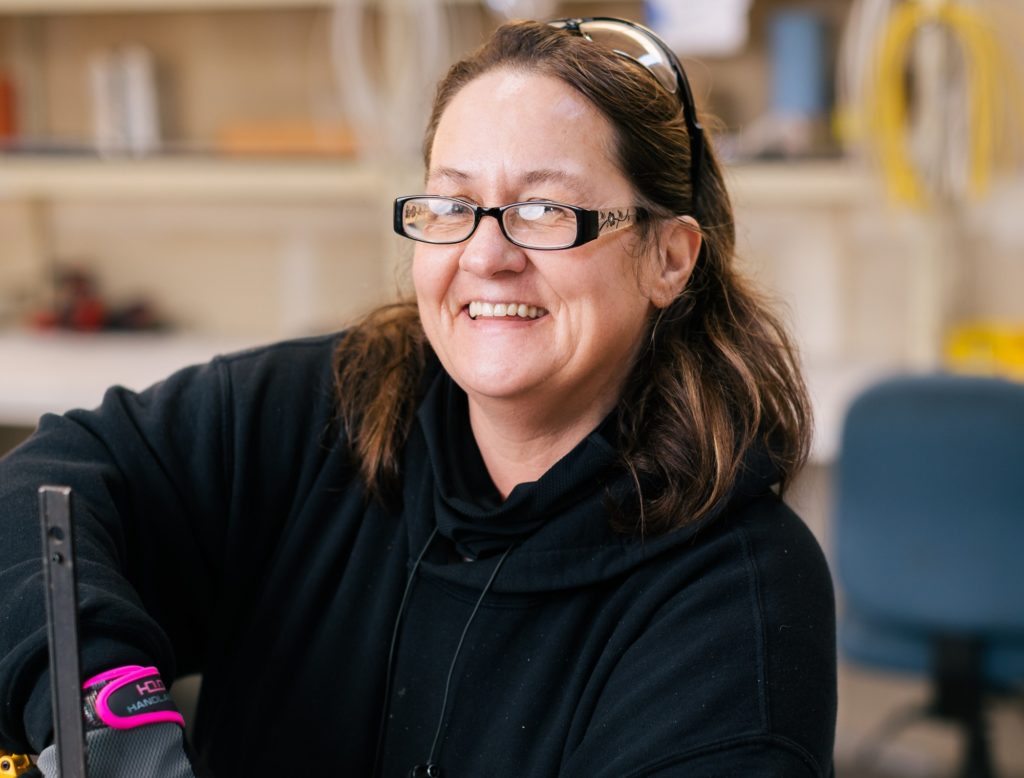
For the last three years, Daniece has been committed to self-improvement. She works full-time at Pallet as a manufacturing specialist, manages two homes for people in recovery, and is mending relationships. She's showing her family she's back in their lives for good.
The path Daniece is now on began when she was incarcerated. While serving a sentence, she enrolled in an intensive substance use treatment program. It ended up being a transformative experience. The approach required her to get up at 5 a.m. and attend group meetings. She also received counseling, motivational interviewing, and recovery-focused skill building. Daniece completed a relapse prevention exercise which she described as scary.
"They made you plan your next relapse. Plan, how you're going to get it, how much you're going to get, how you're going to use it, what you're going to do with it and how long you think that's going to last," Daniece explained. "Then, when you're done with that, what's going to happen?"
Daniece said she experienced anxiety and stomach aches throughout the planning process.
"But they do that to build a new pathway in your brain," she shared. "After you present that, then you know you don't ever want to do that."
From there, Daniece progressed in the program and even became the big sister to another inmate. She provided support and helped guide them through the treatment process. They formed a bond and they’re still in contact. Daniece says the program helped build self-esteem, and learned a lot about herself as well. Discovering her learning style was eye-opening.
"Some people can read. Some people need to write it down. Some people can watch somebody else do it," she shared. "But for me, I physically have to do it with my hands in order for me to comprehend it. Which I didn't pinpoint that before, so it just makes it easier for how I learn now."
While incarcerated, Daniece connected with The If Project. The nonprofit organization collaborates with currently and formerly incarcerated adults, community partners, and law enforcement focused on holistic intervention and reducing and preventing incarceration and recidivism. They suggested she apply for a position at Pallet after her release. As a second chance friendly employer, we believe potential — not the past — defines people's futures. More than 80% of our employees are formerly homeless, in recovery, or previously involved in the justice system. (*We now describe our hiring practices as fair chance employment. Learn why we changed our language here.) Daniece joined the team in 2020 and is thriving in a supportive environment.
"We just give our all to it. It's rewarding because it's going to the homeless people," Daniece said. "Somebody could offer me more money to go someplace else. And I wouldn't because this is a rewarding job for me."
Daniece also experienced homelessness for about a year and is sure if she had the chance to live temporarily in a Pallet shelter, it would've made a difference.
"Shelter over my head and a place to put my things and possibly sleep without worrying about everything. I know I could've done a lot more for myself. I wouldn't have had to go to prison to realize that. That's why the shelters are super rewarding for me."
While in treatment Daniece created a vision board which outlined various goals she created for herself for the next five years. It included paying off fines and buying a car, which she accomplished in just one month. She’s proud of her accomplishments and is continuing to work towards personal development.
In addition to working at Pallet, Daniece is training to become one of the coaches at Recovery Café, a refuge for healing and hope for people traumatized by homelessness, substance use, and other mental health challenges. Plus, she's on The If Project's council.
"I took a lot from the community," Daniece shared. "I'm in a position where I want to give back now."

Fresh bedding, USB outlets for personal devices, and a locking door are just a few of the amenities more than a dozen people experiencing homelessness in Arkansas now have access to. This week they moved into New Beginnings, a Pallet shelter village in Fayetteville. A nonprofit bearing the same name is the service provider for the site. The village meets the complex needs of chronically unsheltered people. The village is low barrier — pets, partners, and possessions are welcome — plus residents will have access to trauma-informed care.
New Beginnings staff stocked each 100 sq. ft. Pallet shelter with everything the residents would need for their fresh start. Items include a locking storage bin, homemade quilt, chair, reading light, toiletries, and cleaning supplies. A few pets also moved in with their owners, so there are supplies for them too. It was important for each person not to feel like they were still living in a tent.
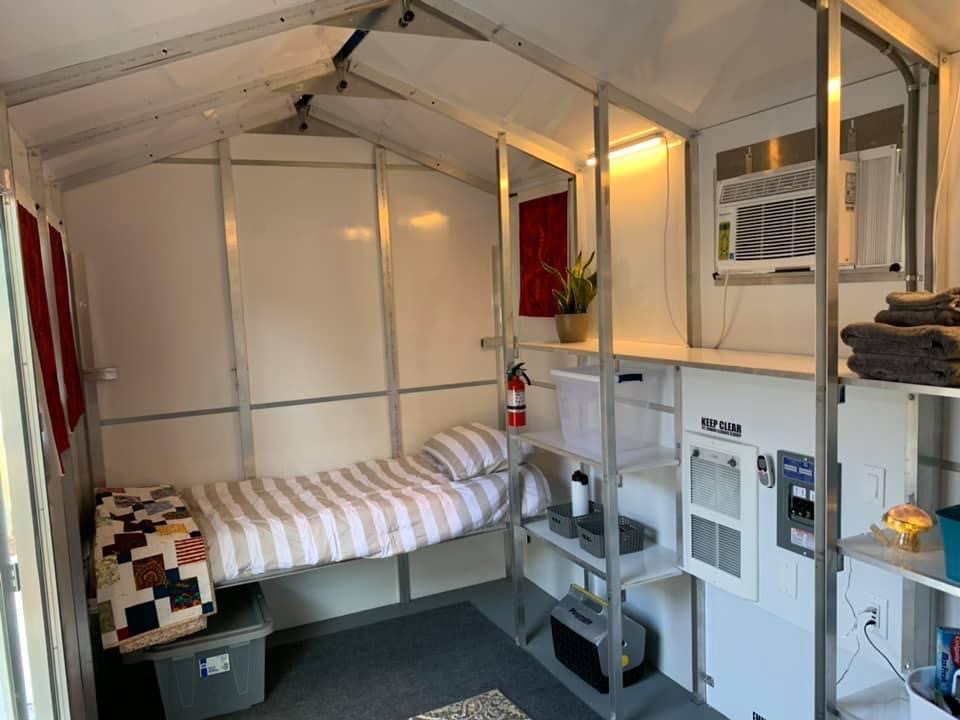
Village features:
● 20 Pallet shelters with locking windows, personal climate control specifically designed for colder weather, custom fit mattresses, and more
● Program building: offices for housing navigator, social worker, medical personnel, and mental health counselors
● Three bathrooms, two are ADA compliant
● Laundry facilities
● On-site meals
● Commercial kitchen
Among all the site's features, New Beginnings board member Kevin Fitzpatrick says the one feature that sets this Pallet shelter village apart is the locking door on each cabin.
"That makes the difference in most of these people's world because the majority of them are coming from a world where they were consumed by who's going to steal my stuff. And what am I going to do with my family heirloom? What happens if somebody assaults me in the middle of the night? Those are all-consuming," he explained. "They are consumed by the issues of safety and security. And people that have trauma in their life, both recently and in the past. That creates a whole other layer to that safety and security. No wonder they are in that circumstance because it just becomes a cyclical nightmare for many of them."
Fitzpatrick is also a University of Arkansas professor and homeless advocate. He understands the importance of accessible housing as he's watched homelessness increase in Northwest Arkansas. For several years he's worked on bringing a transitional housing village to the area. The rigorous process paid off when the Pallet shelters arrived over the summer.
"This project really got a shot in the arm when the Pallet shelters went up," he shared. "Buzz started to happen, and I'm not sure that it did before that. So it really gave people an opportunity to see exactly what we were doing. And I've not heard a single negative word."
Fitzpatrick went on to say each new resident is on a different timeline. Some will move on to permanent housing faster than others, which is expected since everyone is dealing with different circumstances.
Build a Pallet shelter village
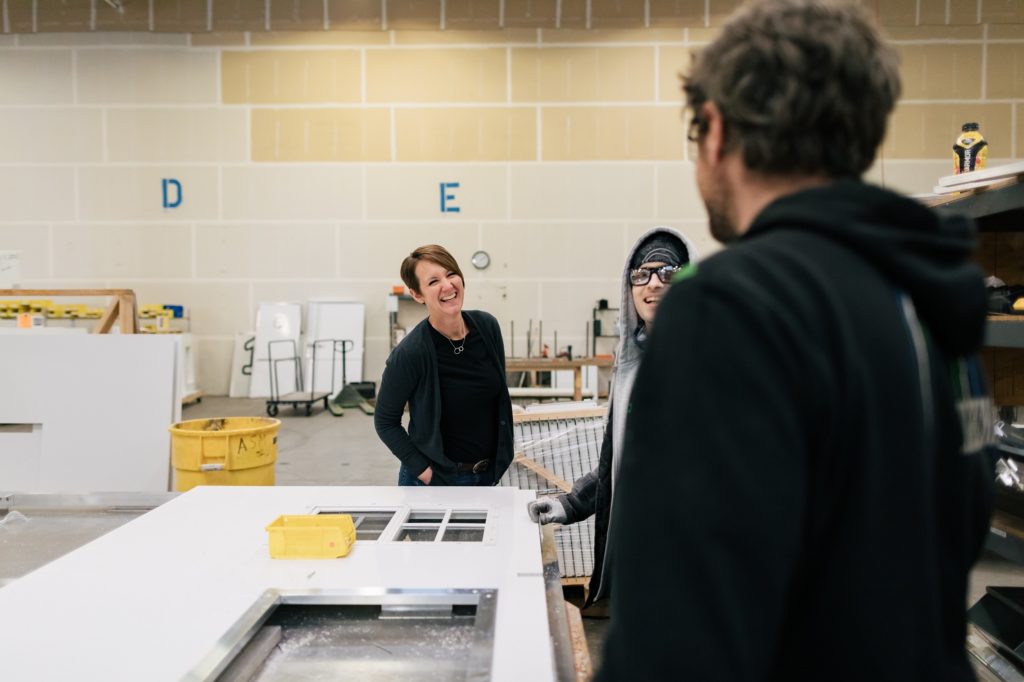
From the start, Pallet employed a non-traditional workforce to build shelters for people experiencing homelessness. We believe potential — not the past — defines people's futures. More than 80% of our employees are formerly homeless, in recovery, or previously involved in the justice system. People with lived experience are vital in helping us design and build restorative communities. Amy King, Pallet Founder and CEO, wouldn’t have it any other way. She encourages employers to adopt a diversified employment practice.
In this follow-up to five tips to becoming a second chance employer, Amy answers frequently asked questions about hiring. (*We now describe our hiring practices as fair chance employment. Learn why we changed our language here.)
Do I need to perform a background check?
A background check isn't necessary for many industries. Exceptions include those that interact with children. If an employer chooses to run a background check, Amy says it's best to approach it as a tool for honest communication.
"We take more of the approach of, here's your background check. You've seen it, we've seen it. Let's have a conversation about it. It creates that inherent kind of foundation and undercurrent of trust between us and the employee as we go forward. I think it's a helpful tool."
One upside to going over background check results is that it gives the employee a chance to verify that all the information is correct. If there's an error, we direct them to a service that helps them clear it.
The results from a background check have never disqualified anyone from working at Pallet.
Should we have sobriety requirements?
This decision depends on the industry and corporate values. Pallet is a substance-free workplace. We chose this partly because many of our employees are in recovery, so we've created a culture that supports them.
"When you come here, this is a safe place. If you can't pass a drug test, you can't be here because the person next to you is fighting hard for their sobriety, and we don't want you to derail them. And they don't want to derail you, you're in this together. It's less about substance use as it is about creating a culture of safety. And I think that's the key for people who want to do second chance employment; it's got to be a safe environment for people."
I'm concerned my current employees will be scared. How do I address fears of safety?
One of the best things you can do is expose your existing staff to people with lived experience before hiring. For example, Amy has helped interested employers by putting together a panel of people to discuss their lives and the circumstances leading to homelessness, substance use, or incarceration.
"Hearing these stories of rehabilitation and recognizing that someone exiting prison or coming out of addiction or coming off the streets out of homelessness doesn't have to be a scary person. And is probably, in fact, inherently not a scary person. They're a person who needs help."
What about theft?
"That person is no more dangerous than anybody else in your building. I guarantee it. People are people," Amy explained. "Give your people the benefit of the doubt. If you trust them and you believe in them, they will believe in themselves and trust themselves. And then it becomes a shared trust."
How high is staff turnover?
Pallet has been able to avoid the revolving door of staff and the expense that comes with it.
"We have very low turnover rates compared to most businesses because our people are very loyal. They're doing purposeful, mission-driven work that they care about, so they're more likely to stay here."
Why should I hire a nontraditional workforce?
"One of the best things you can do to contribute to our community is help the people who are the most marginalized and who have the least amount of opportunity. That might not seem like an obvious thing. But the more you help the people at the bottom, the more you're helping everybody. Because everybody is responsible for that person at the bottom, whether they're aware of it or not, and it's not just economics, either. Human beings are not inclined to ignore one another's suffering, and whether we outwardly ignore it or not, it's there."
For more on Pallet’s workforce and the construction of our shelter villages, check out this podcast interview transcription with Amy.
